
Bamberg is one of the few major historical cities in Germany that survived the Second World War.
Today Bamberg is considered one of the most striking historical cities in Germany, the historical center of which (the old town of Bamberg) is included in the UNESCO World Heritage List.
By modern standards, Bamberg is a small city, and it is easy to get around on foot.
Bamberg is located on the banks of the Regnitz River and stands on seven hills, which is why it is known as the "City on Seven Hills" or "Franconian Rome".
All this makes Bamberg one of the most charming and visited cities in Germany with an abundance of historical attractions. There are hills with panoramic views, and each of which has its own dominant - the church; the island part with winding narrow streets with buildings in the Baroque, medieval, romantic style, and houses along the river, called "Little Venice"; as well as cathedrals, churches, fortresses, former palaces, monasteries and museums. And breweries, which have already become an integral symbol of Bamberg, add variety to a leisurely vacation in the beautiful Franconian city, in which the spirit of the Middle Ages still hovers, now mixed with the modern way of life.
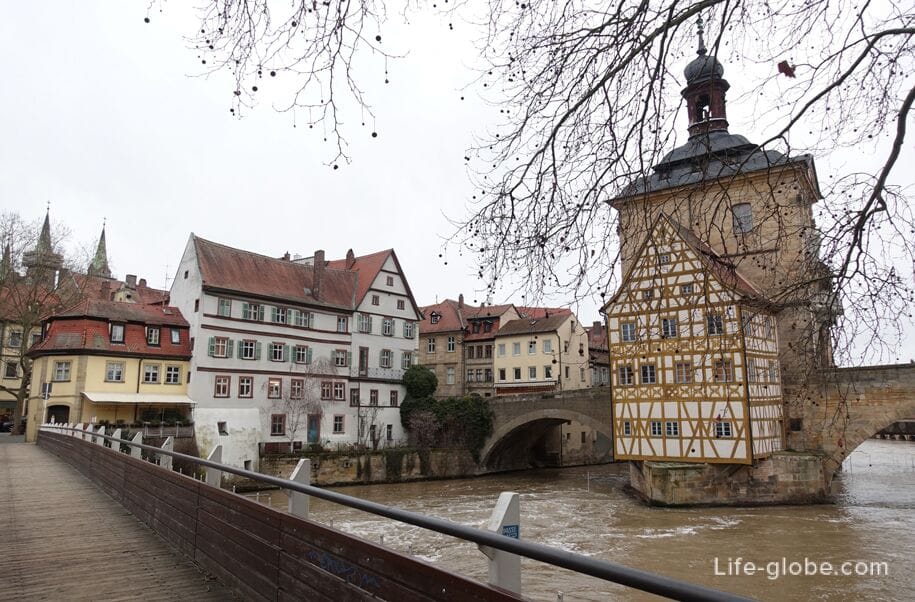
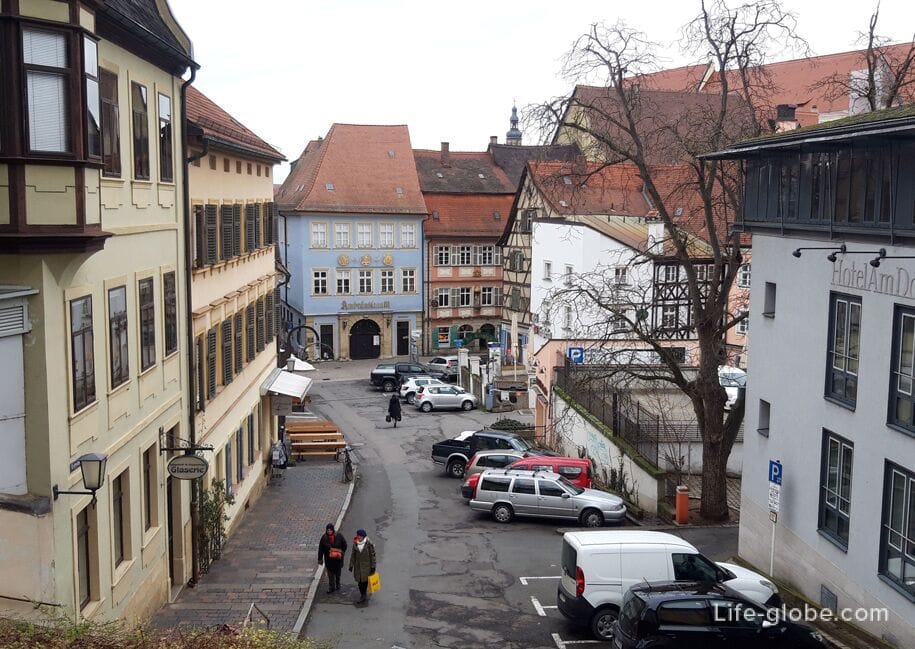

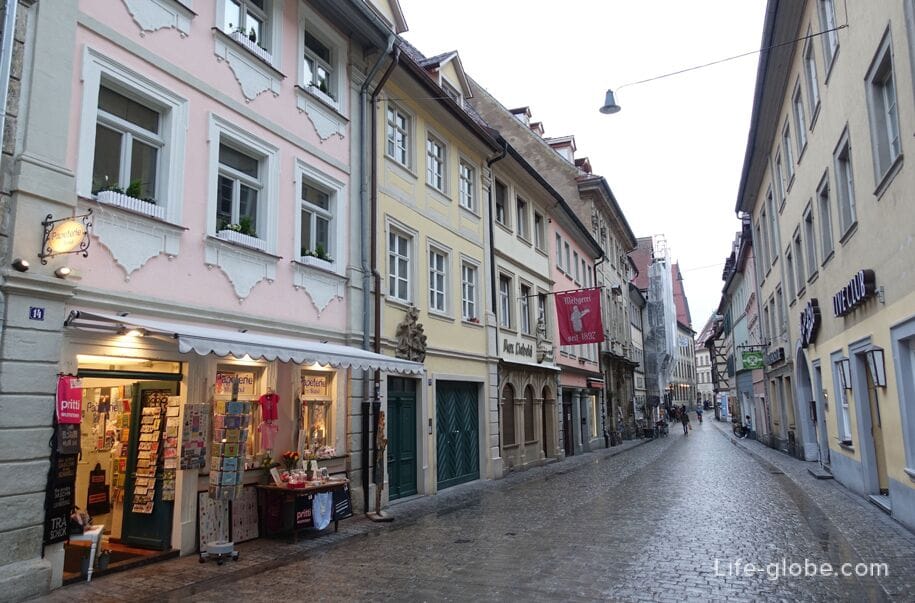
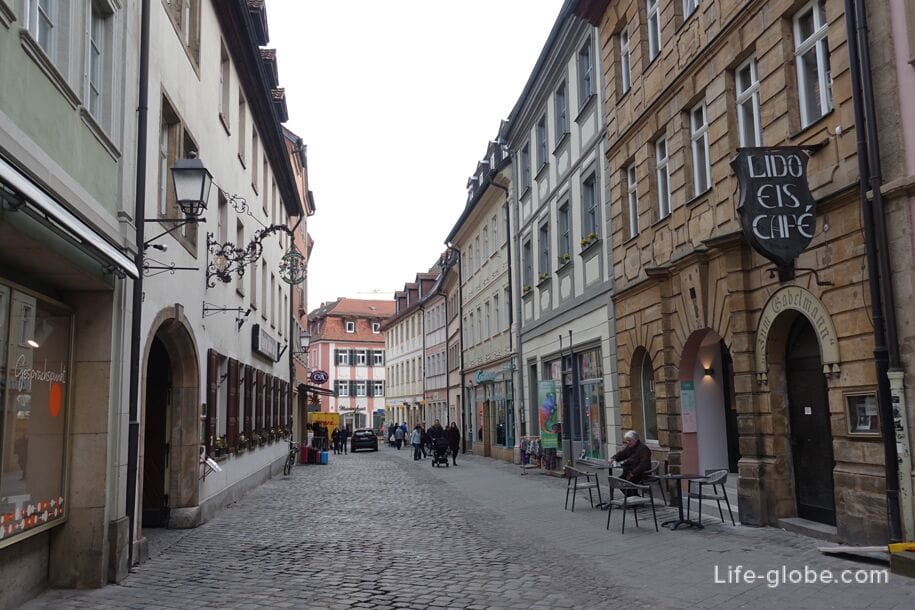
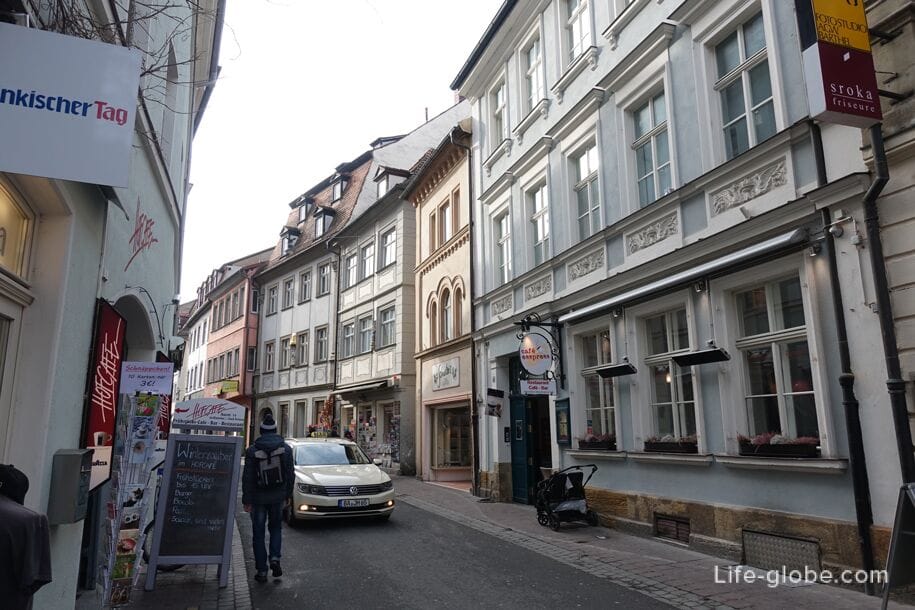
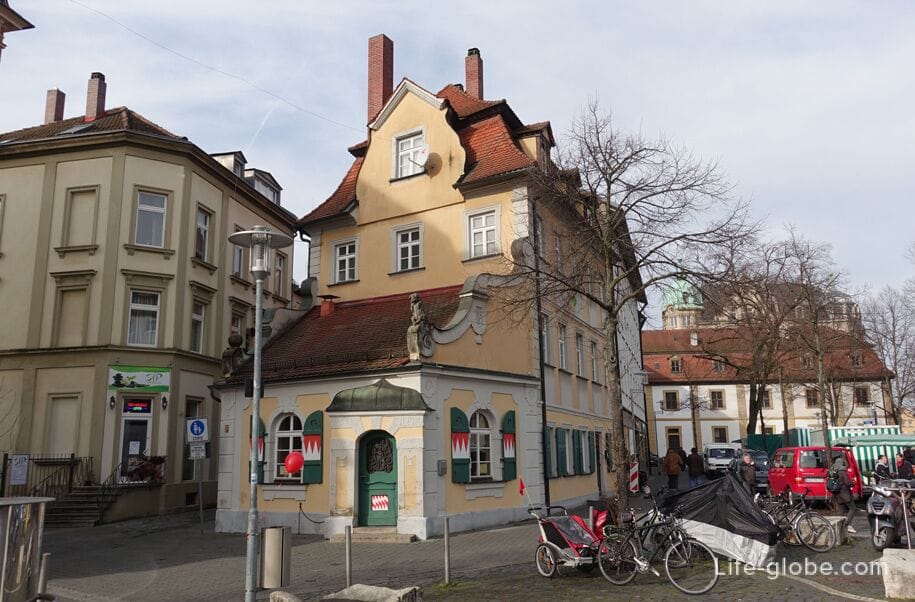
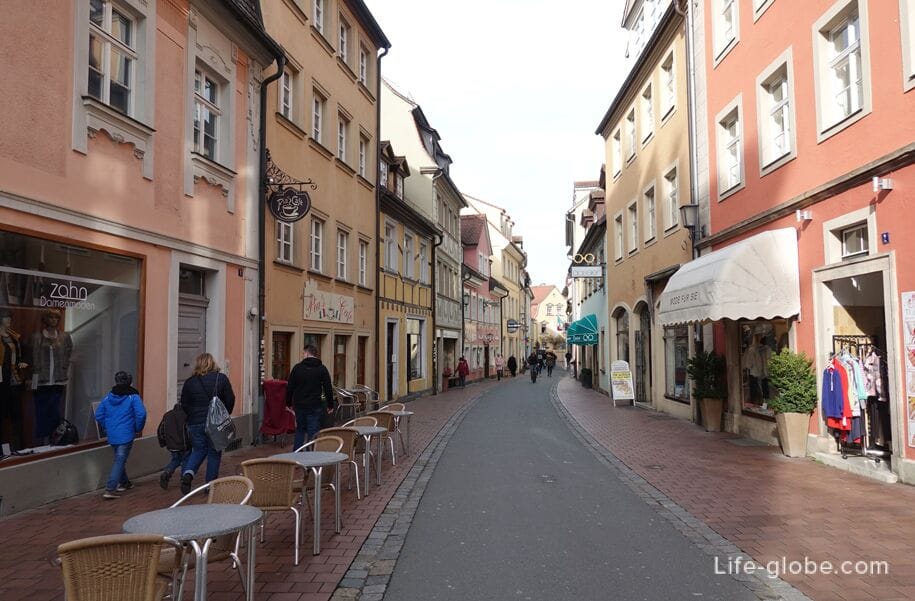
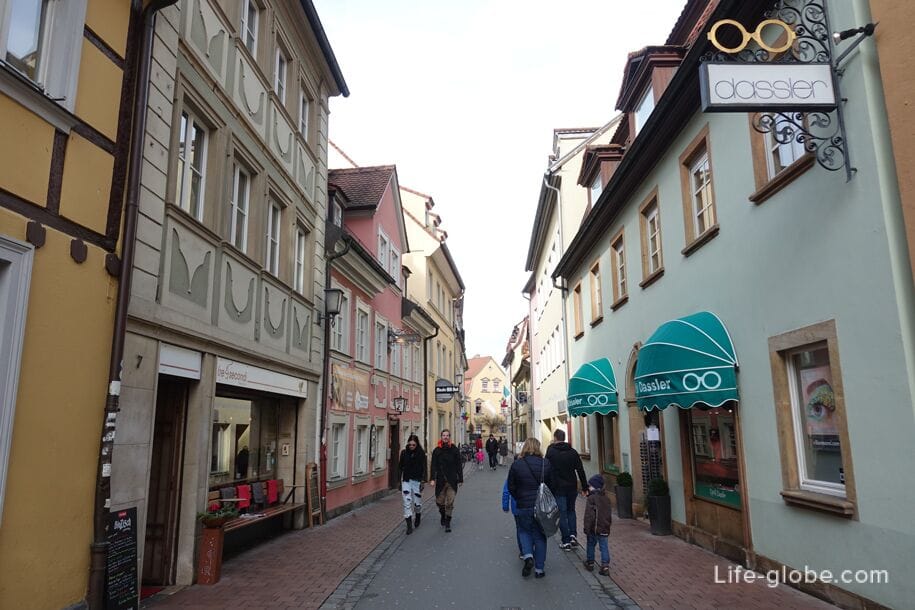

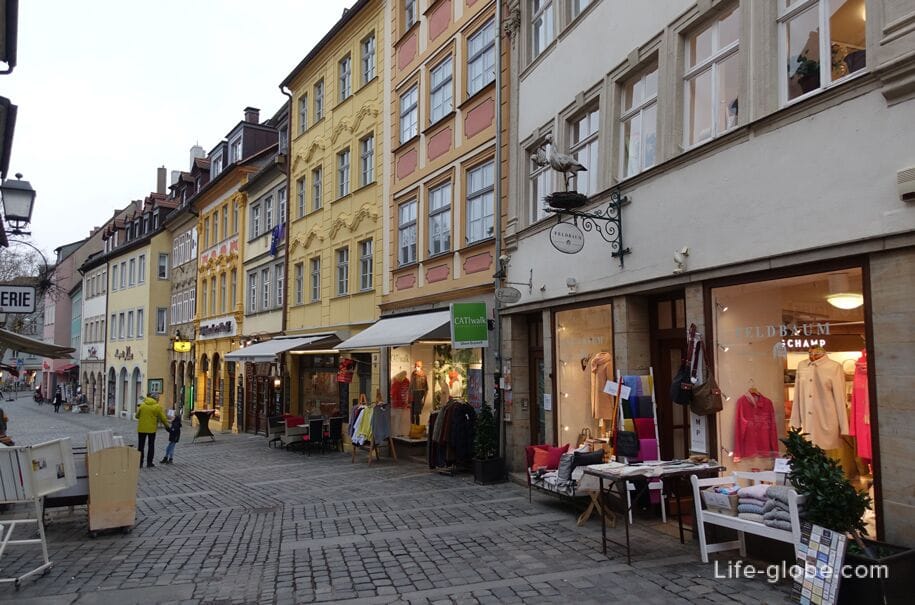
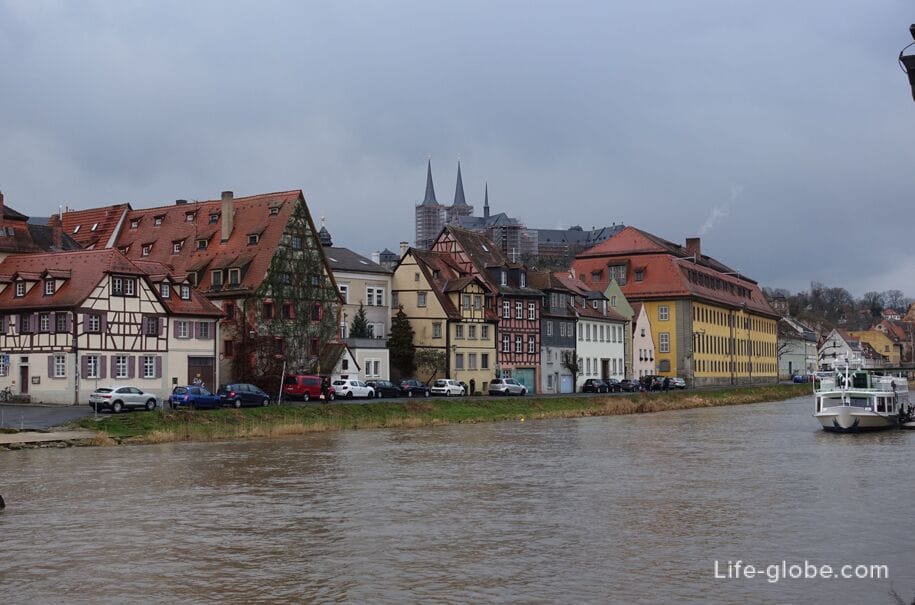
This article provides the most complete list of attractions, museums, significant objects and interesting places in Bamberg. If you want to learn only about the most important sights and the main museums of the city, where you should go first, or if there is little time allocated to Bamberg, then you can see the list of top attractions and museums of the city here →
The Old Town Hall of Bamberg (Altes Rathaus Bamberg) is a medieval town hall, which is one of the most important and beautiful buildings that characterize the historical center of the city.
The Town Hall stands on an artificial island in the middle of the Regnitz River, between the former episcopal and working (urban) districts.
The Town Hall was first mentioned in 1387 and is a complex of buildings with a Bridge tower and adjacent bridges with sculptures. A bridge passes through the tower of the town hall, so the town hall is sometimes called the "Town Hall on the Bridge".
Today, the Ludwig Museum operates within the walls of the old town Hall, with a collection of Strasbourg faience and porcelain from the collection of the chocolate manufacturer Ludwig called "Baroque Splendor". Adjacent to the exhibition is the famous Bamberg Rococo Councillors' Hall. Museum website: sammlung-ludwig. Learn more about the Old Town Hall and bridges...

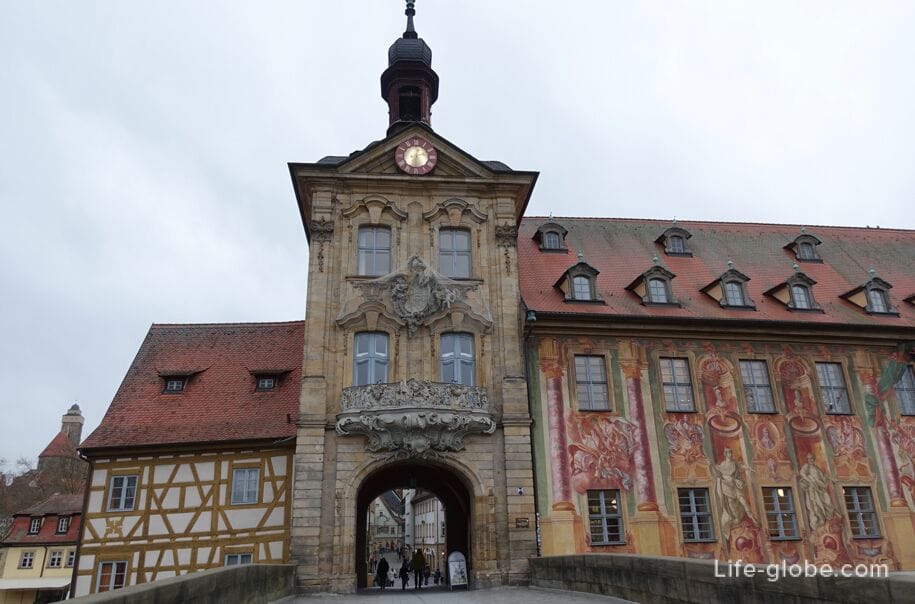
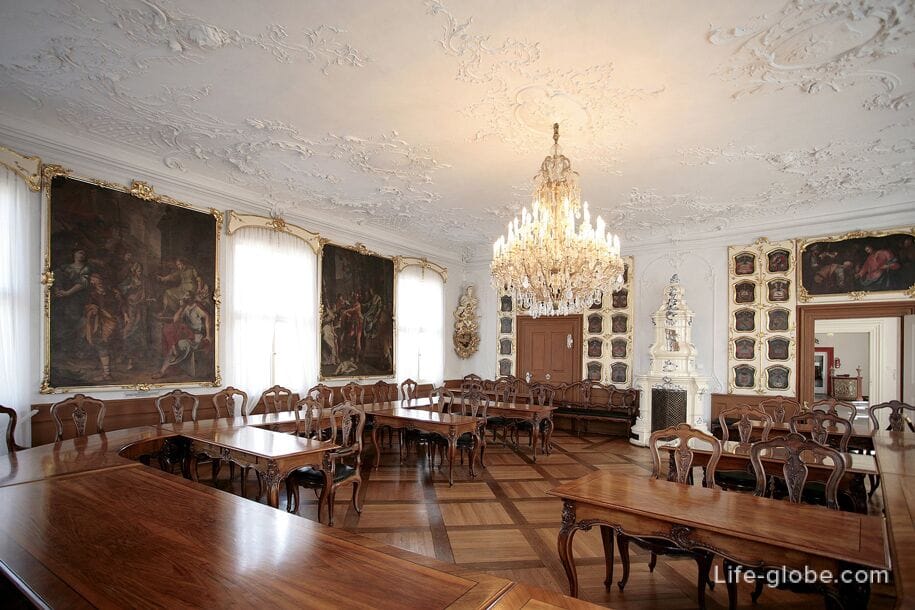
At the Cranes (Am Kranen / Am Kranen) is an embankment, a street and a square on which there are several significant objects and which is located near the bank of the Regnitz River.
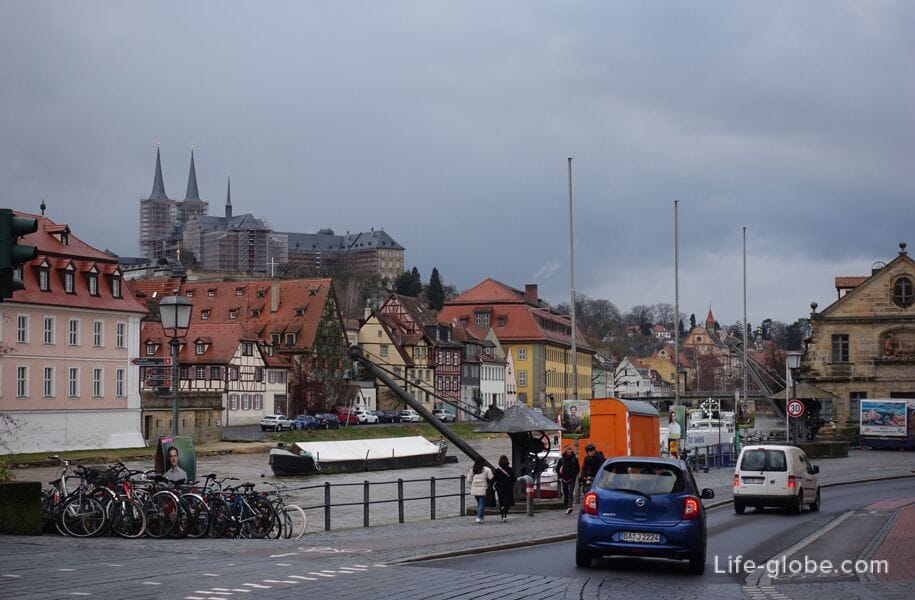
Attractions of the square "At the Cranes"
The head of Centurion I (Igor Mitoraj "Centurione"), which is a modern sculpture in Bamberg.
The bronze sculpture was created by the Polish-born master Igor Mitorai, who worked mainly in Paris and Italy.
The head belongs to classical antiquity, but at the same time it is not integral, but with damage, which, according to the plan, should lead to philosophical reflections.

Historical monuments of cranes "Am Kranen".
Once it was the heart of the city's port facility. Its importance comes from the fact that Bamberg received the so-called stacking from Emperor Barbarossa in 1156, according to which passing merchants had to unload their goods in Bamberg and put them up for sale within 3 days before they were allowed to move on.
Monuments to two cranes gave the name of this small square - "At the Cranes" (Am Kranen).

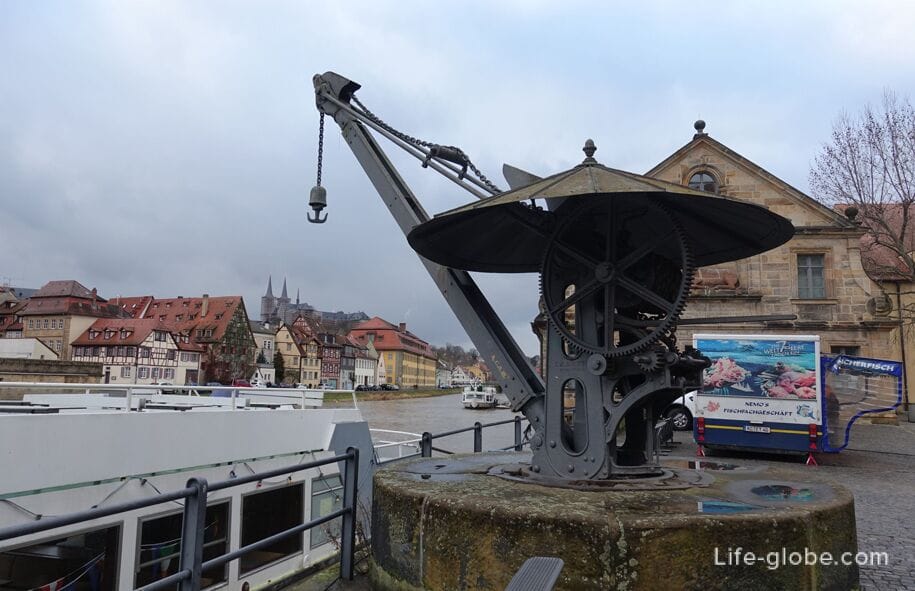
Schlachthaus is an old slaughterhouse built in 1741-1742.
On the pediment of the building of the Old Slaughterhouse there is a bas-relief with the image of a bull and an inscription in Latin: "To be a bull now, but not a calf before is unnatural, but I was lucky. The artist's hand made me a bull before I was born a calf."
Today the building is used as part of the University of Bamberg.
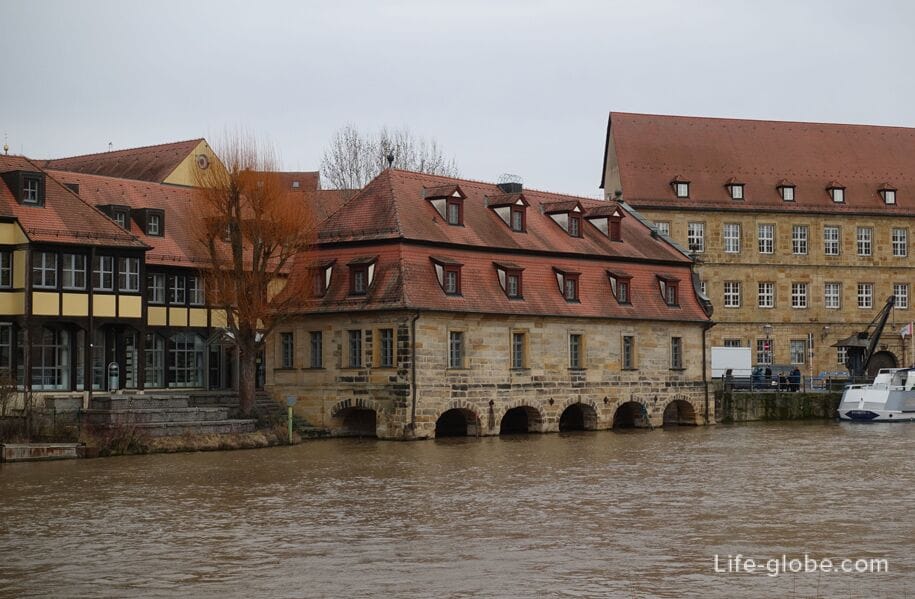
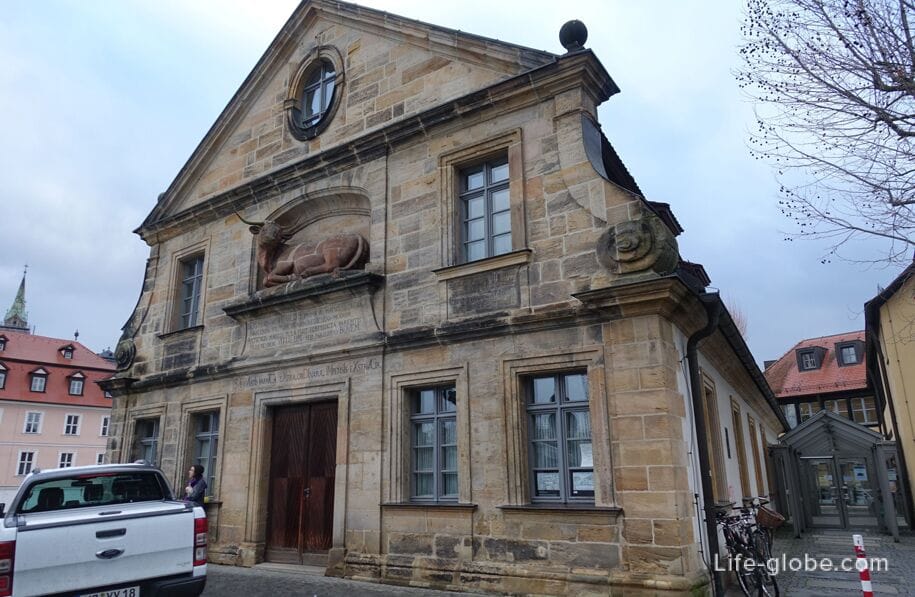
The historic Hafenrundfahrt building.
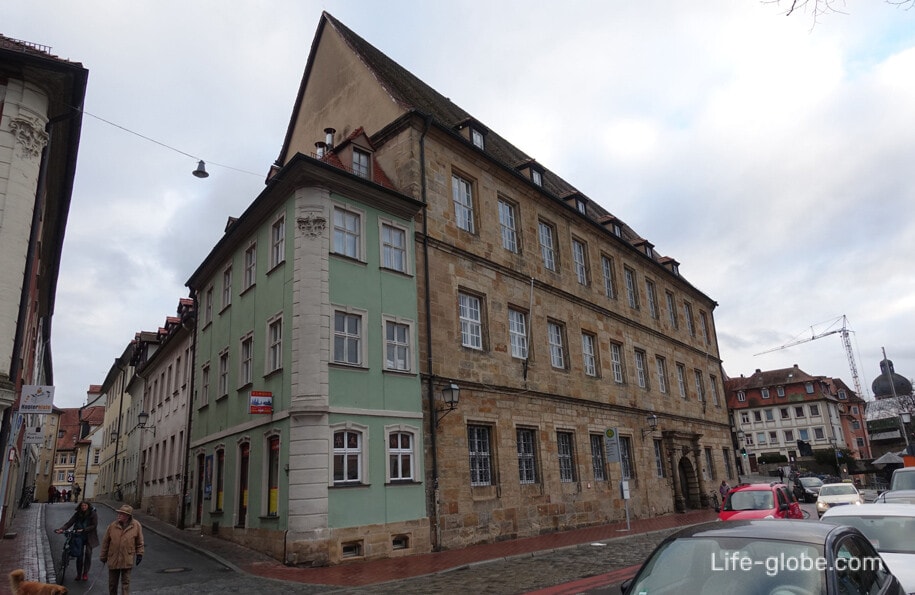
Little Venice (Klein Venedig) is a place on the Regnitz River, where small half-timbered houses with tiny gardens are located in dense rows along the banks of the river.
Previously it was a fishing settlement, and half-timbered houses mostly belong to the Middle Ages.
"Little Venice" stretches downstream of the Regnitz River from the square "At the Cranes".
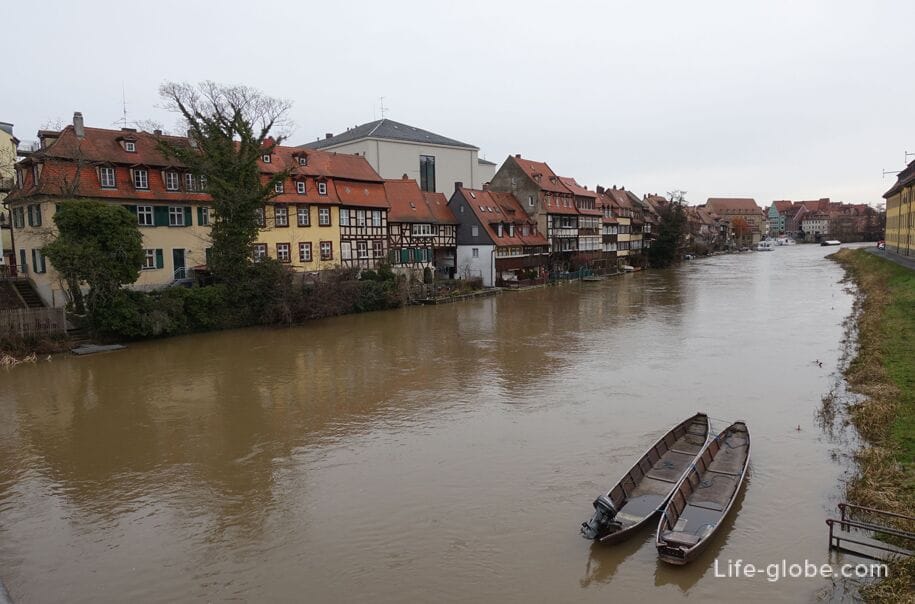
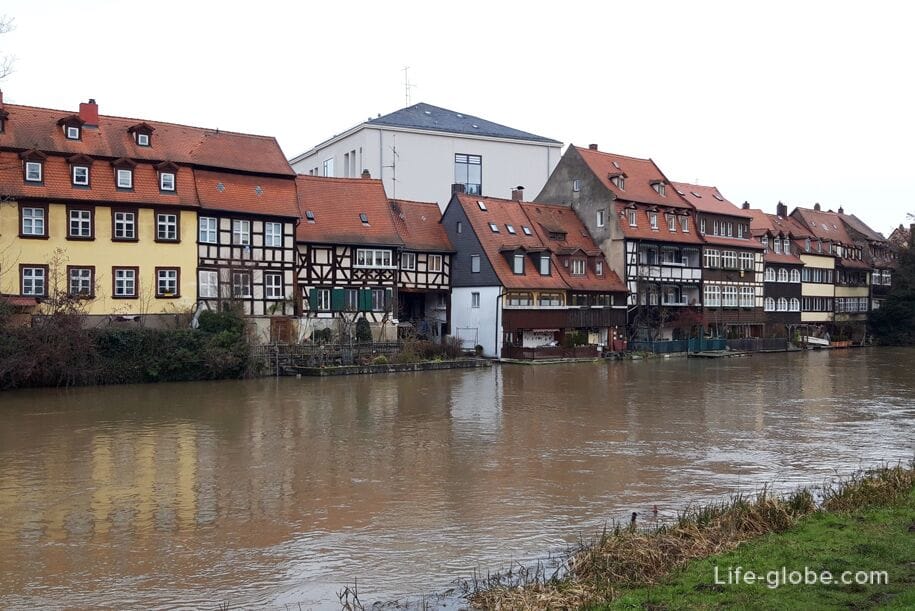
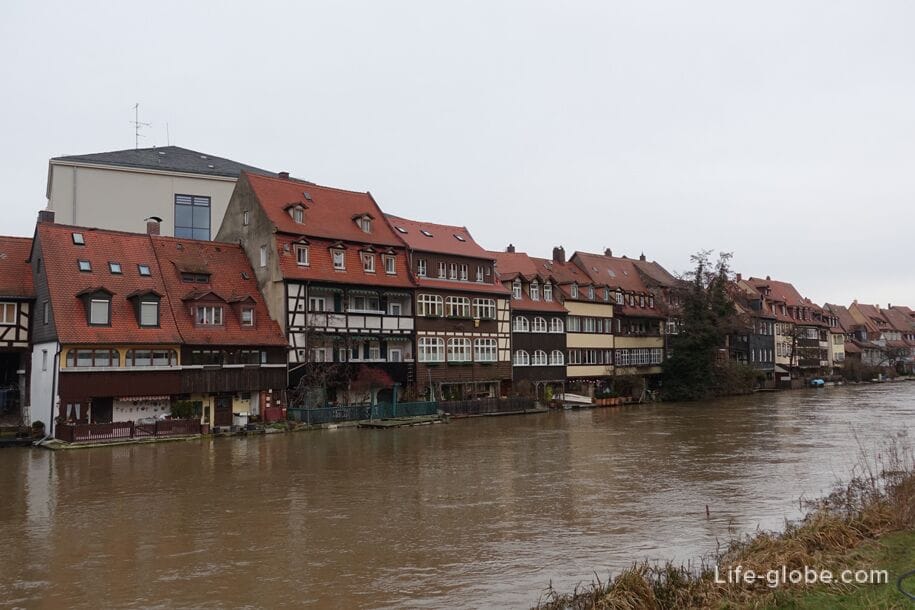

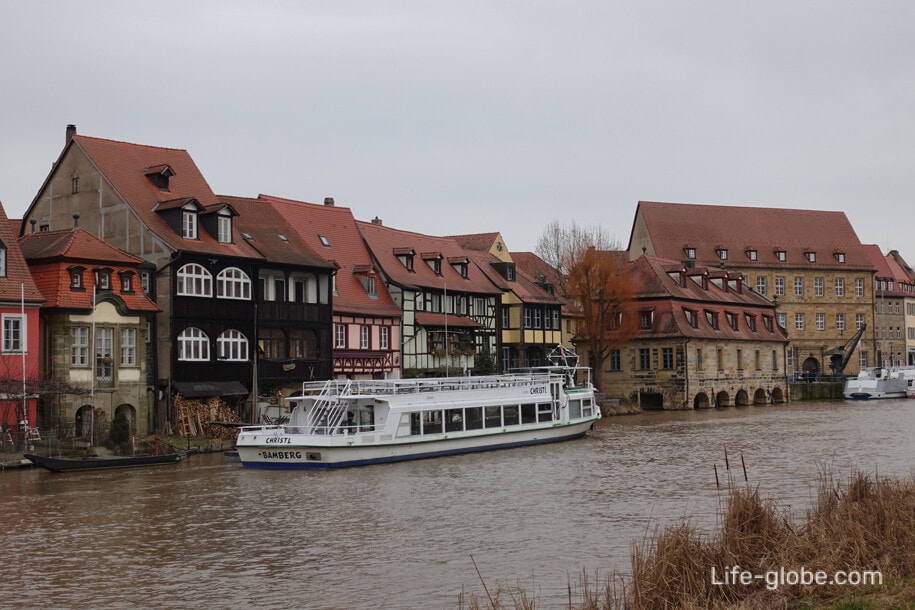
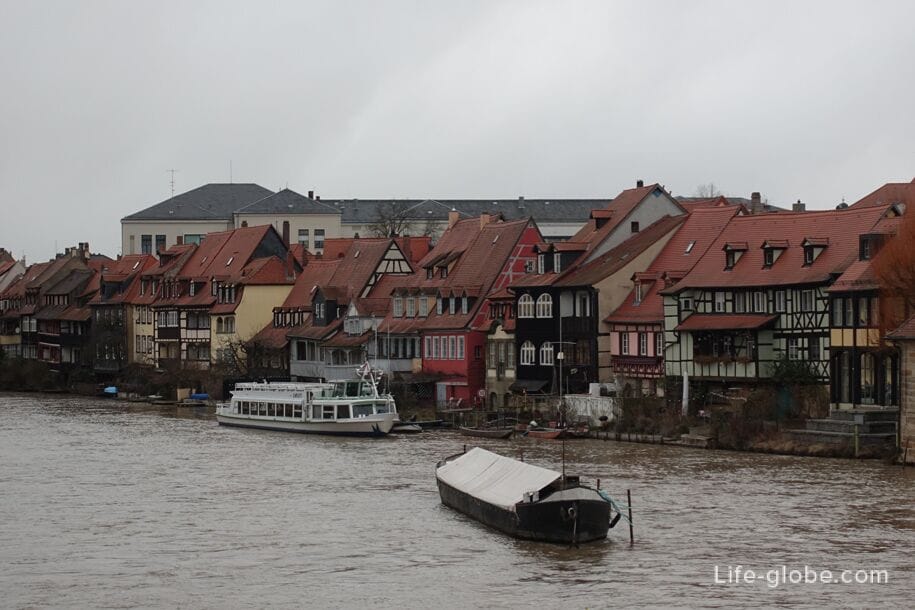
You can see "Little Venice" both from the motes and the banks of the river, and by taking a tour on a pleasure boat, boat or canoe along the river. The pier is located on the square "At the Cranes".
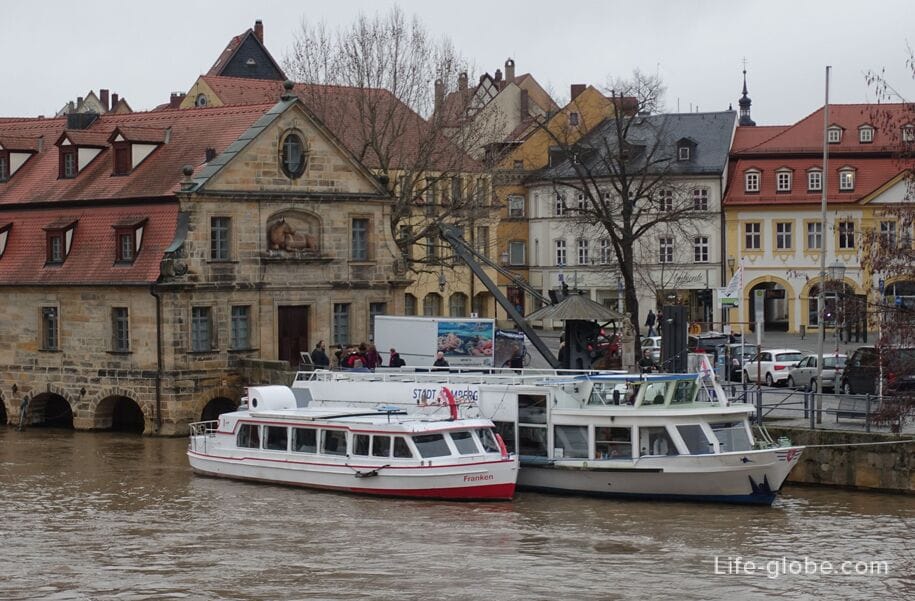
Embankments with elegant historical and more modern buildings run along the Regnitz River and its canals in Bamberg, and bridges and locks cross the river itself.
The most impressive buildings are located along the left arm of the Regnitz River (Linker Regnitsarm) and the Ludwig-Main-Danube Canal.
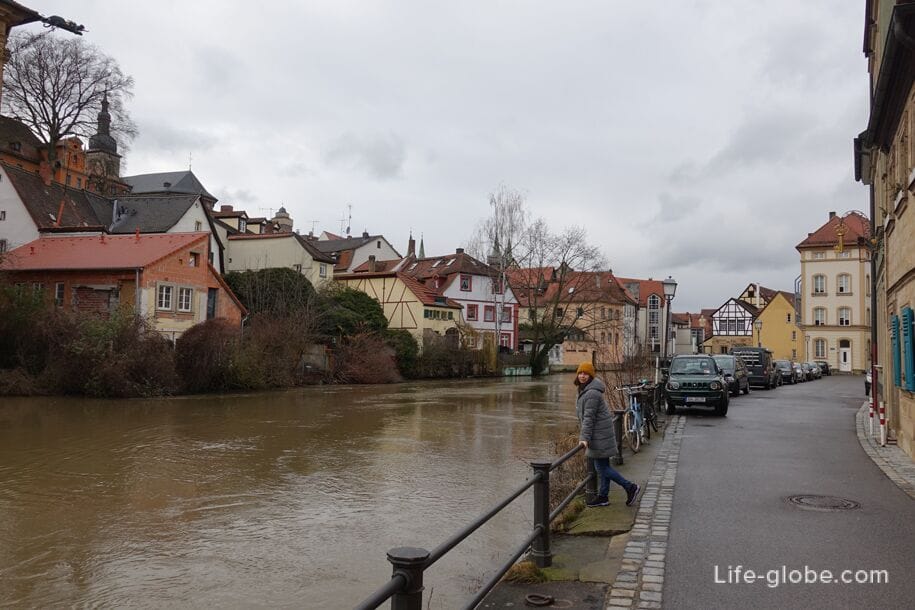
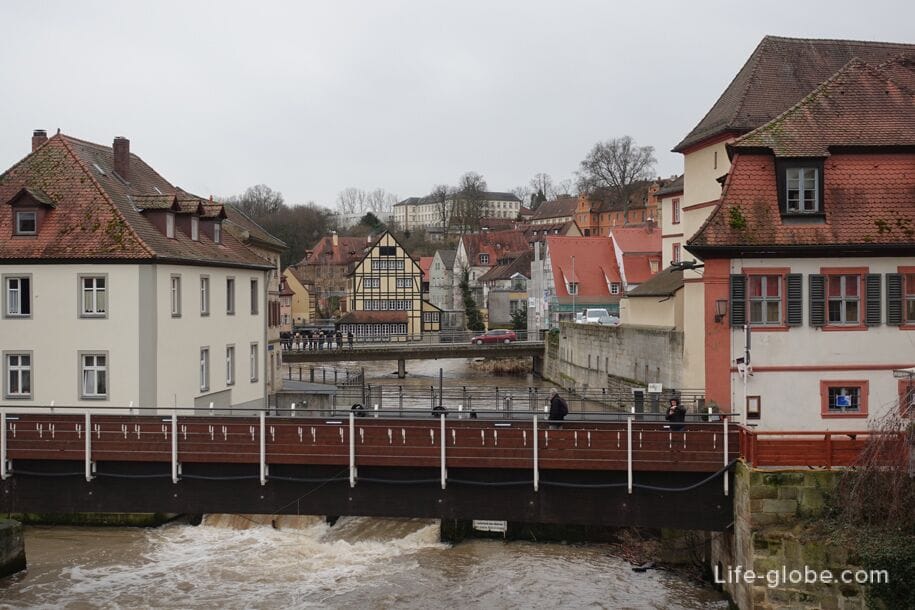
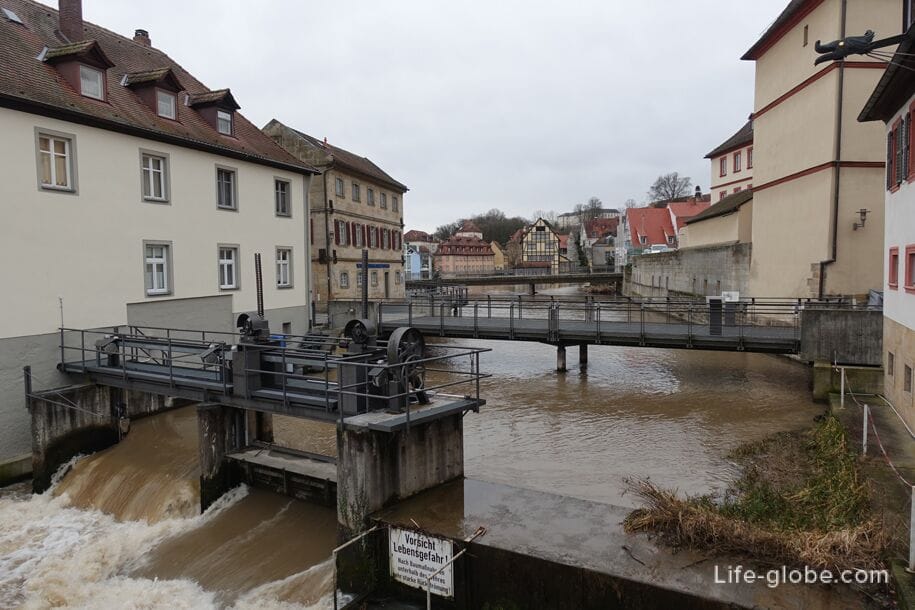
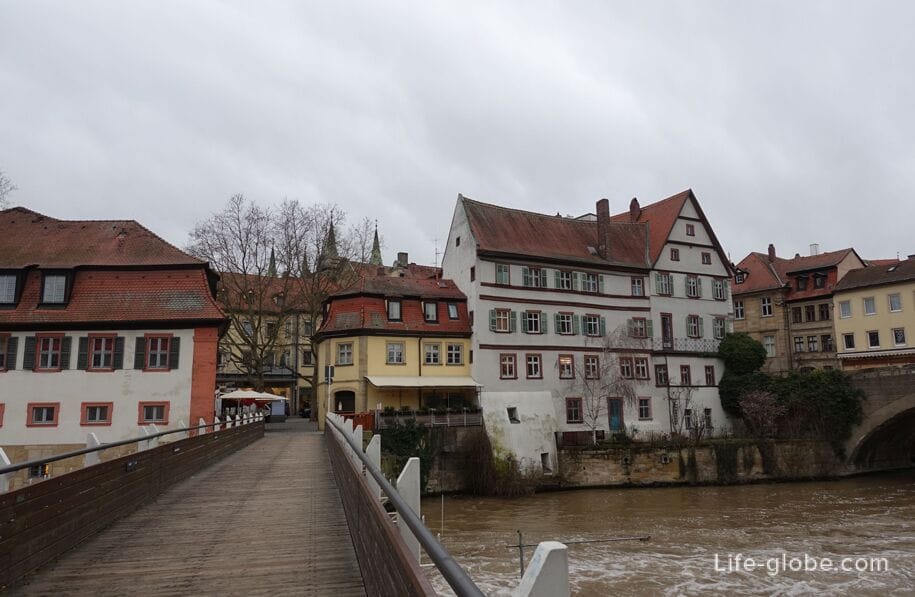
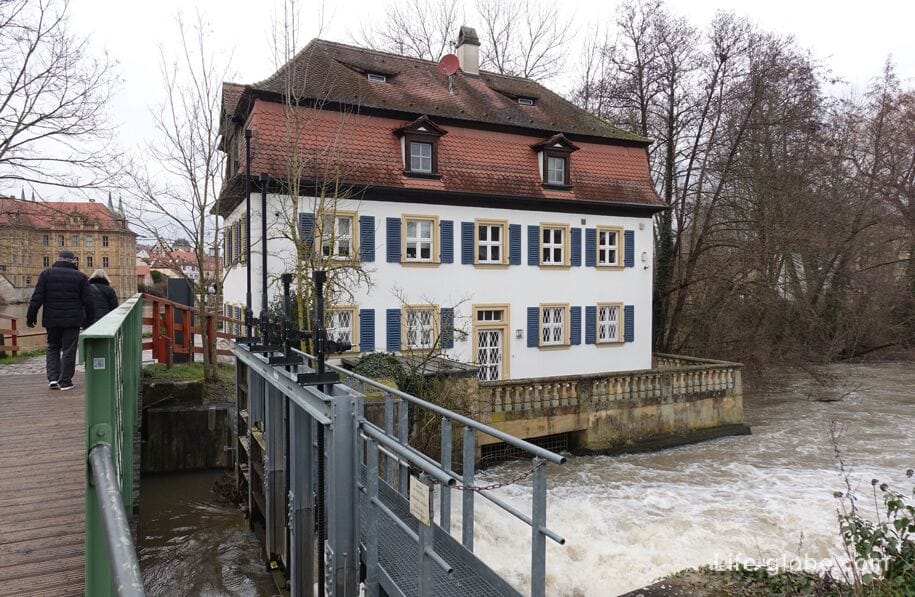
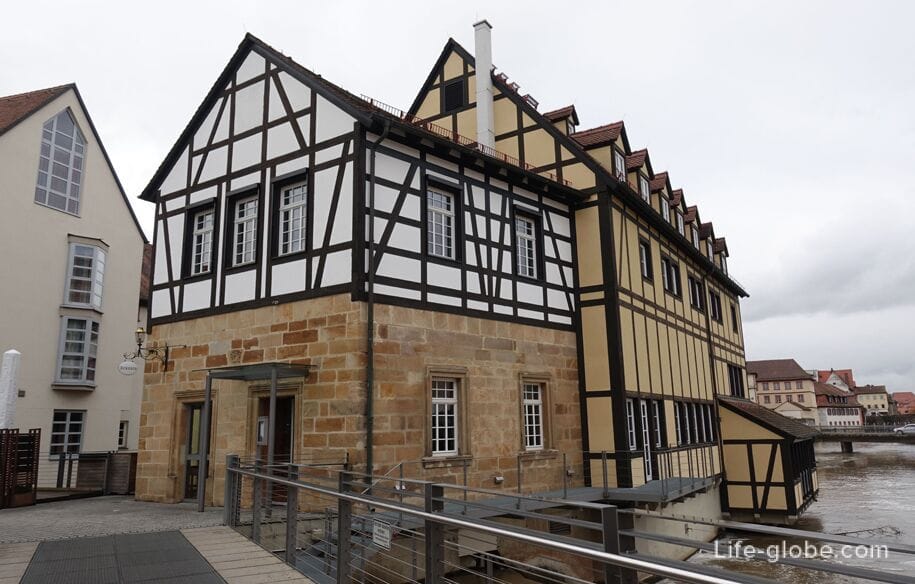
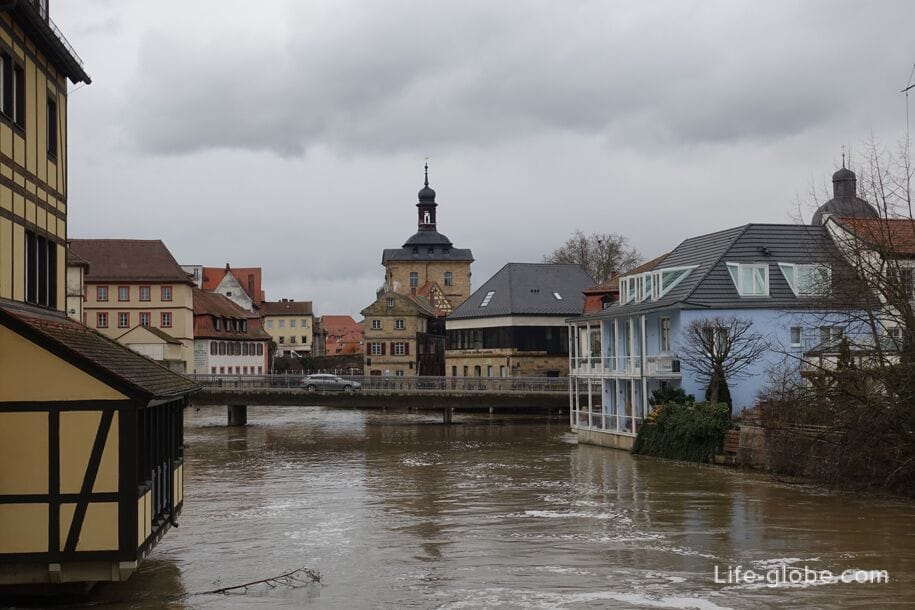
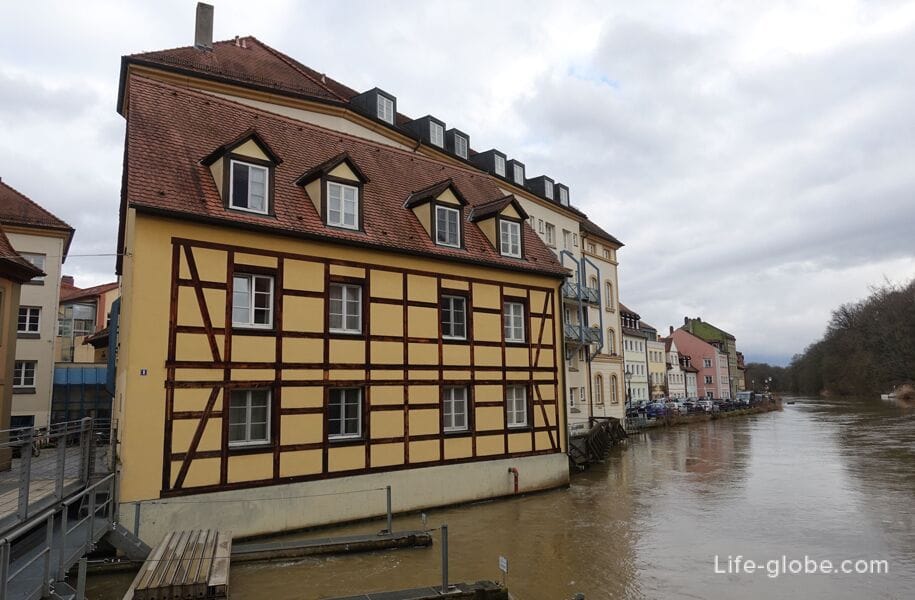

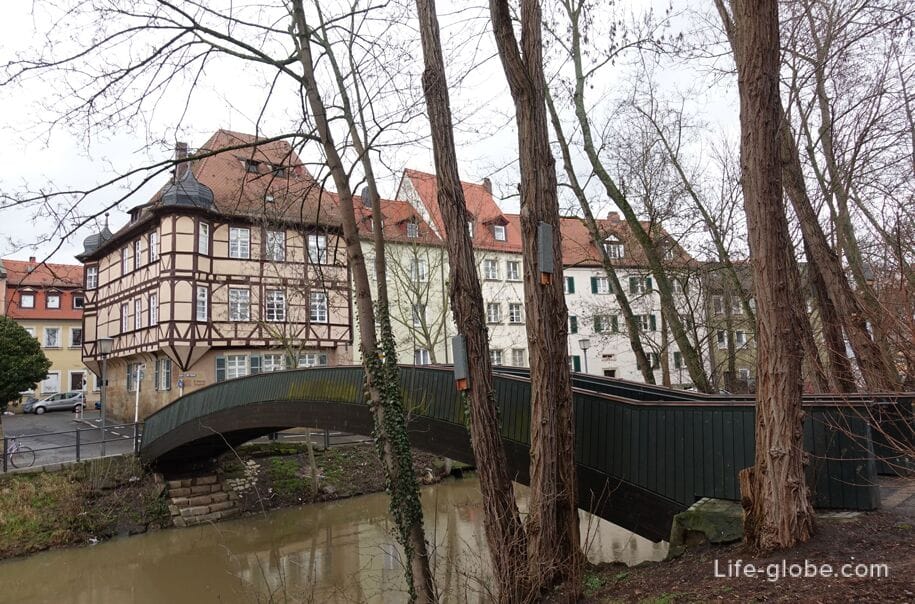
Other embankments and bridges of Bamberg
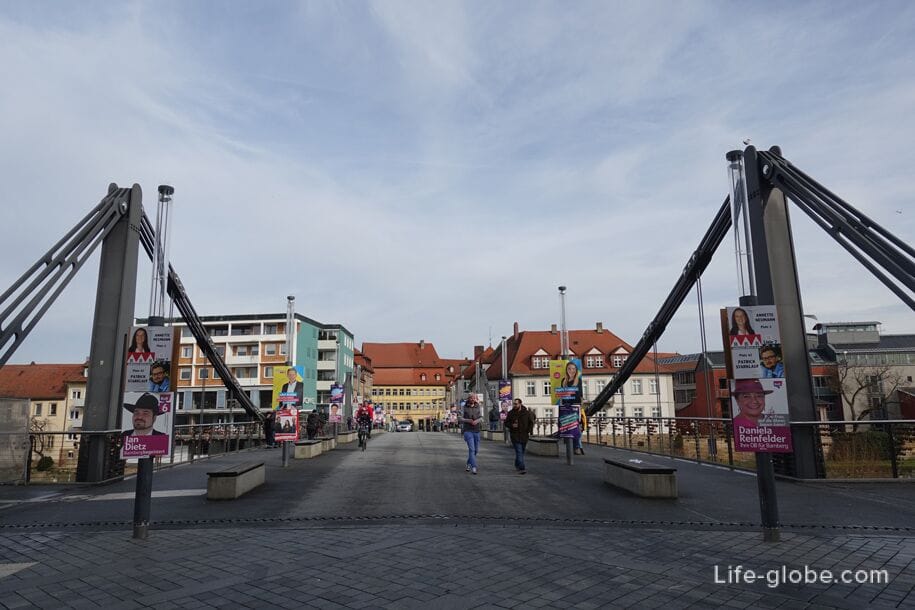
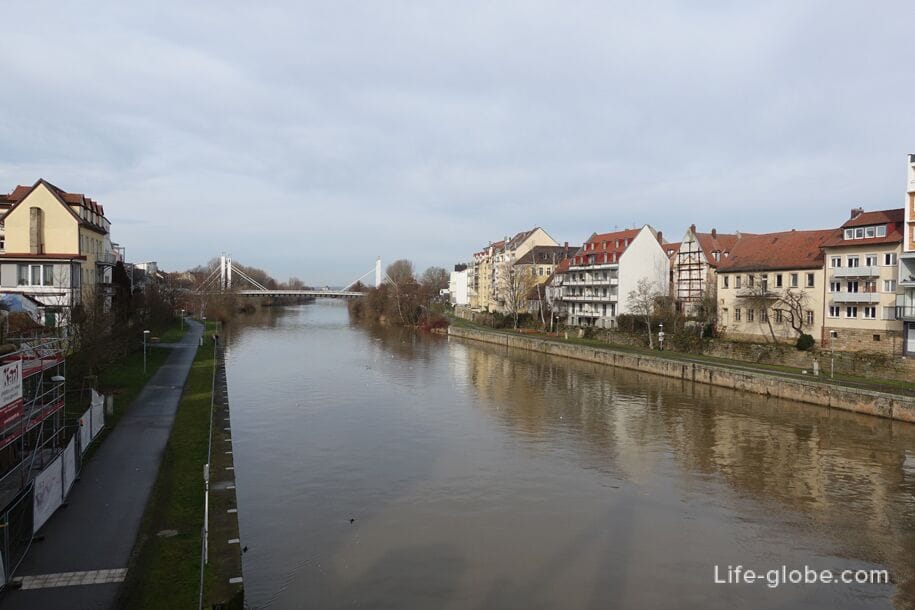
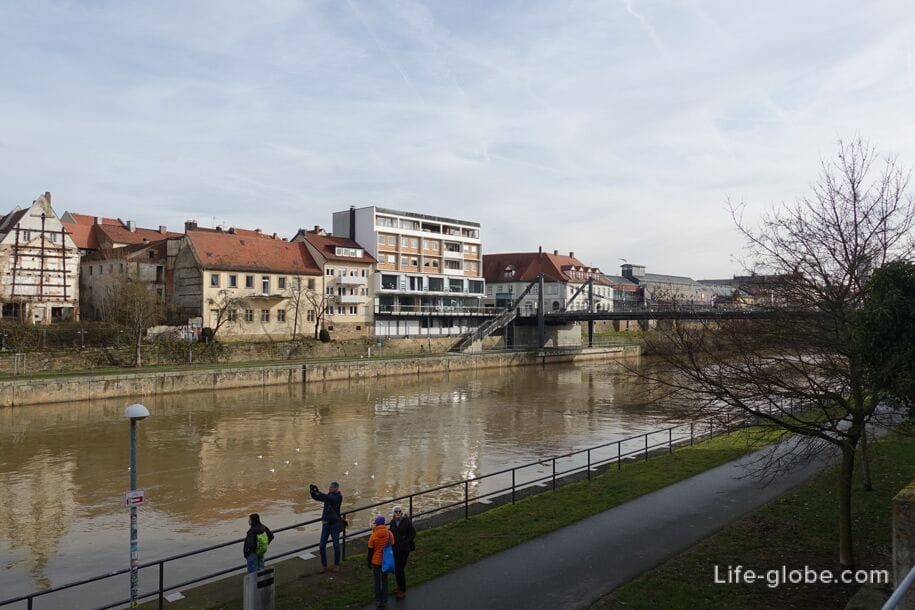
On one of the bridges, the sculpture "Air-Earth" (Air Earth) by the artist Jaume Plensa is noteworthy.
The sculpture was acquired after a six-month exhibition by Catalan artist Jaume Plensa entitled "EIGHT POETS" was held in the public space in 2012, where eight large sculptures, illuminated from the inside, placed special light accents in the old town of Bamberg. This was followed by the purchase of a sculpture called "Air-Earth", which was fully funded by donations, sponsorship money and foundations. Since then, the sculpture of Plens has been located on the Oberen Mühlbrücke Bridge and enchants guests, especially in the evening hours, thanks to the moving glow.
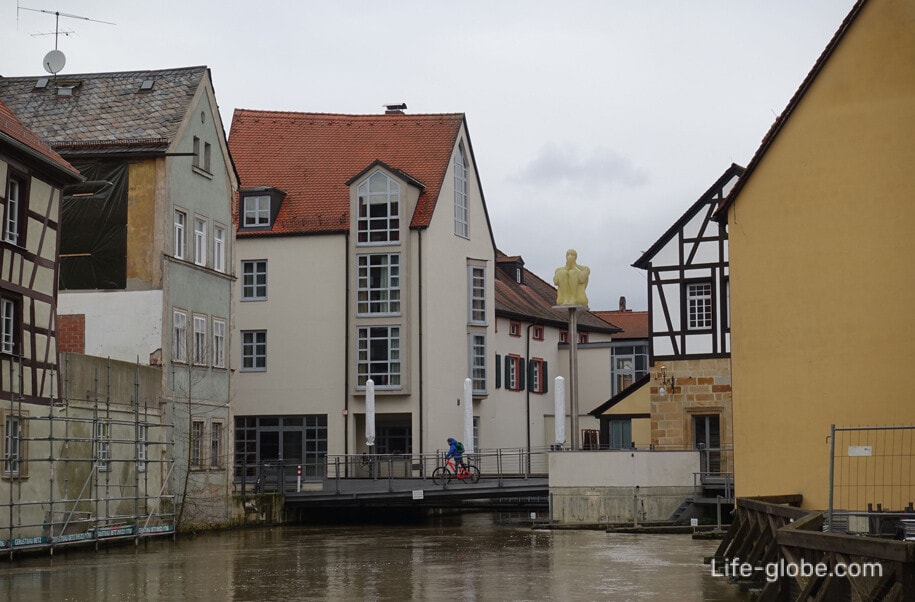
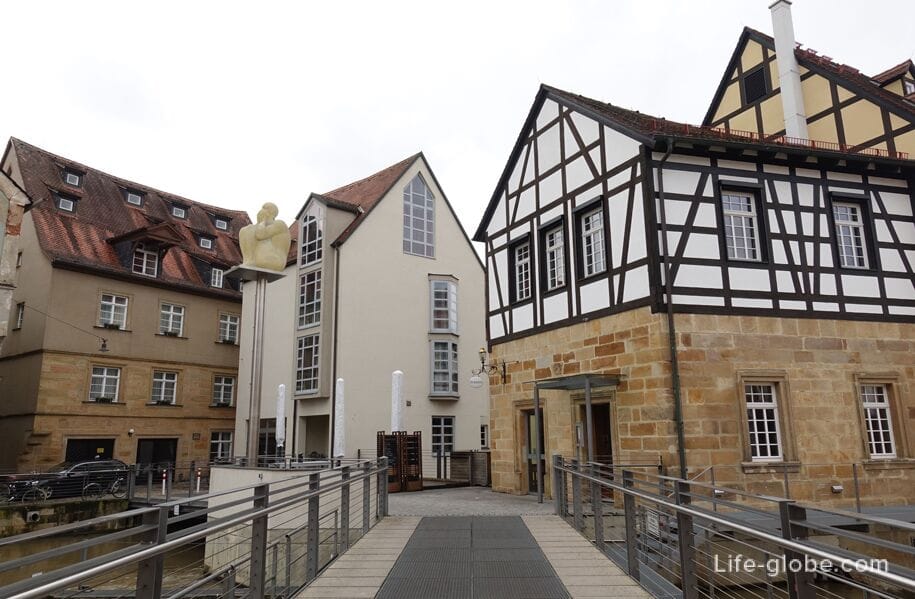
The most famous of the locks is the "Gateway 100" (Schleuse 100) - the last of the locks of the old Ludwig-Main-Danube canal (Ludwig-Main-Donau-Kanal), built under King Ludwig I from 1836 to 1845.
"Lock 100" is still used for pleasure boats and canoes and is operated manually by the lock keeper. It also helps to regulate the water level in the left arm of the Regnitz. The idyllic castle keeper's house near the lock has also been preserved.

Among the buildings along the Linker Regnitsarm Canal, Villa Concordia stands out, which is a true architectural monument and was originally erected in 1716-1722 as a residential mansion for the court adviser Ignaz Tobias Bettinger.
Today this magnificent Baroque building is the International House of Artists (Internationales Künstlerhaus Villa Concordia), where there is an exhibition hall and a library. Website: villa-concordia.de.
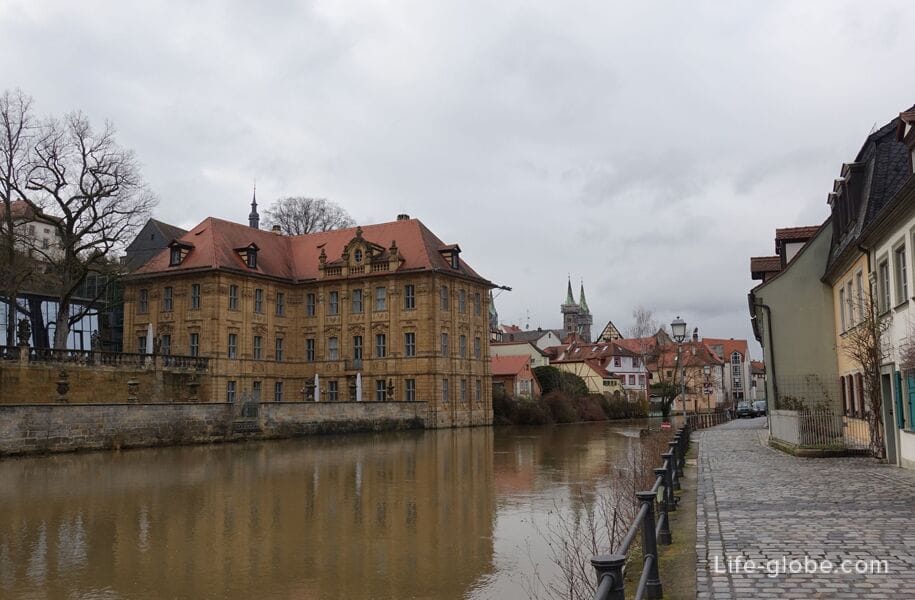
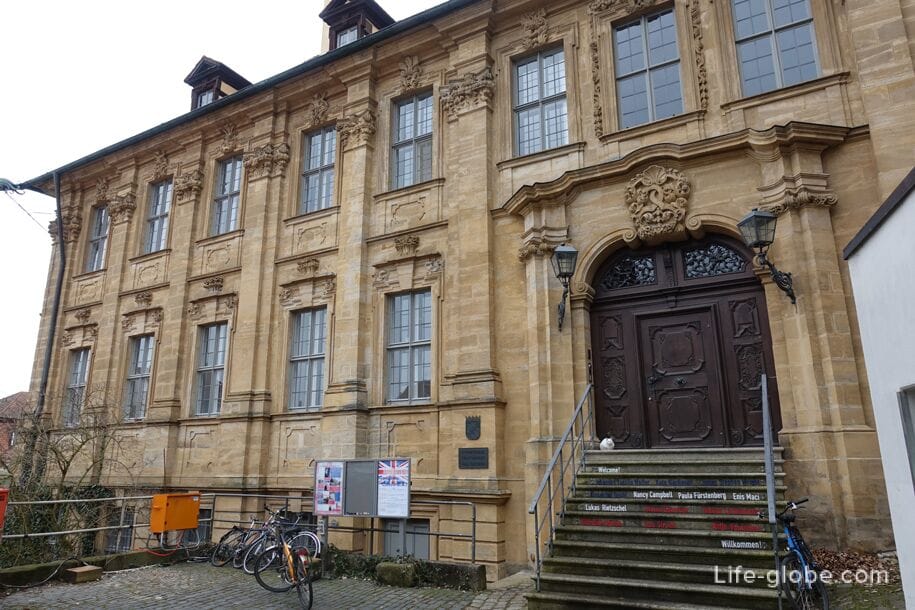
On a small island between the left arm of the Regnitz River (Linker Regnitsarm) and the old Ludwig-Main-Danube canal are notable:
- historical buildings;
- The former Geyerswerth City Palace (Residenzschloss Geyerswörth), named after the Geyer family from Nuremberg.
In 1313, the Patrician Geyer family built the city palace, giving this place its current name. In 1585-1586, the family moved to Nuremberg and left the building to the then Bamberg Prince-Bishop Ernst von Mengersdorf. After that, the Prince-bishop ordered to reconstruct the Geyer family property and build the current palace in the Renaissance style.
Today, the former palace is used by the authorities of the city of Bamberg, as well as for events and celebrations. There is an observation deck in the castle tower, but now it is impossible to climb it (we recommend checking the information about the possibility of climbing to the observation deck before the trip);
- Rosengarten Geyerswerth (Rosengarten Geyerswörth) - a garden located in the area of the former castle park Geyerswerth;
- tourist information center;
- The Bamberg World Heritage Visitor Center (Welterbe-Besuchszentrum Bamberg) with a permanent exhibition, which represents three settlement centers: a mountain town, an island town and a gardener town, which were interconnected when Bamberg was founded in the Middle Ages. Admission to the exhibition is free;
- 4-star Welcome Hotel Villa Geyerswörth with a bar, free high-speed Wi-Fi, sauna, modern fitness room, parking, conference and meeting facilities. Breakfast is included in the room rate. Link to the hotel

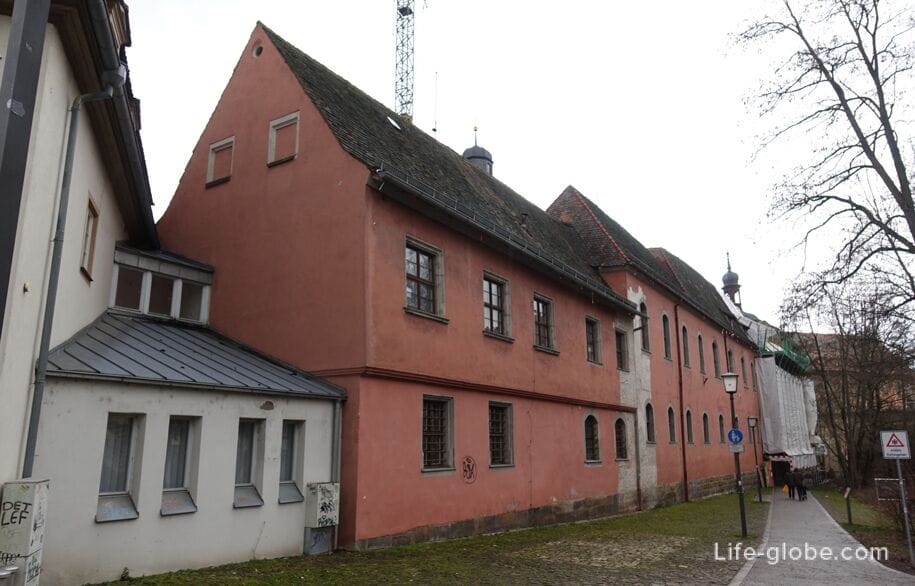
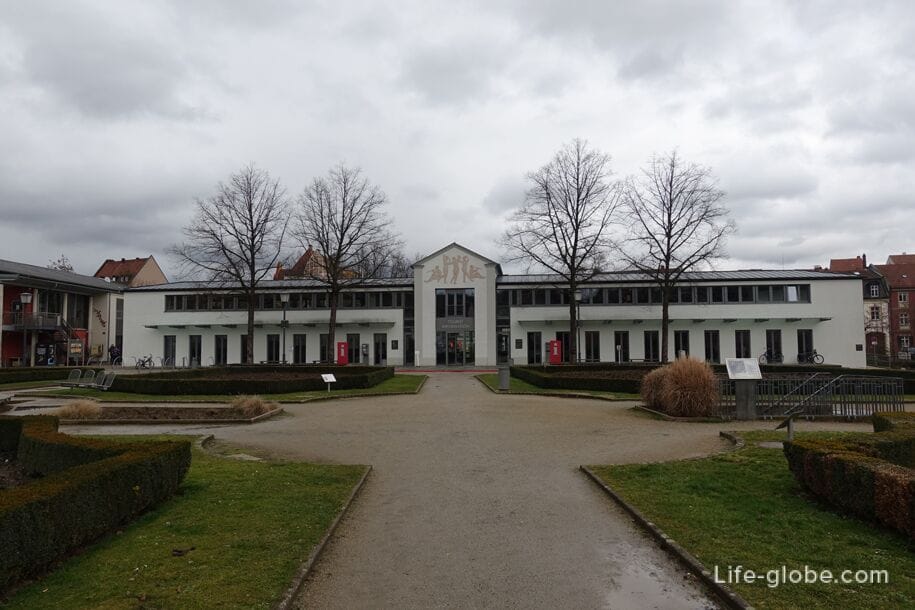
Cathedral Square (Domplatz, Domplatz Bamberg) is the main, one of the largest and most impressive squares in Bamberg.
The ensemble of the square has been formed for many centuries, since 1012, with the simultaneous formation of the ensemble of buildings of the square.

Cathedral Square Ensemble
Bamberg Cathedral (Bamberger Dom) - the Imperial Cathedral of Bamberg, which dates back to the 13th century, is the dominant of the historical center of the city, as well as an example of Romanesque architecture with Gothic elements.
This is the main temple of Bamberg - the Cathedral, the official name of which is the Bamberg Cathedral of St. Peter and St. George (Bamberger Dom St. Peter und St. Georg).
Inside the cathedral stands out: two choirs, crypts, chapels, altars and an organ; frescoes, epitaphs and sculptures, the most famous of which is the Bamberg Horseman; as well as tombs, including the tomb of the holy imperial couple - Henry II and his wife, the Holy Empress Cunegonde, King Conrad III, Pope Clement II and Bishops Gunther and Otto II. More about Bamberg Cathedral...
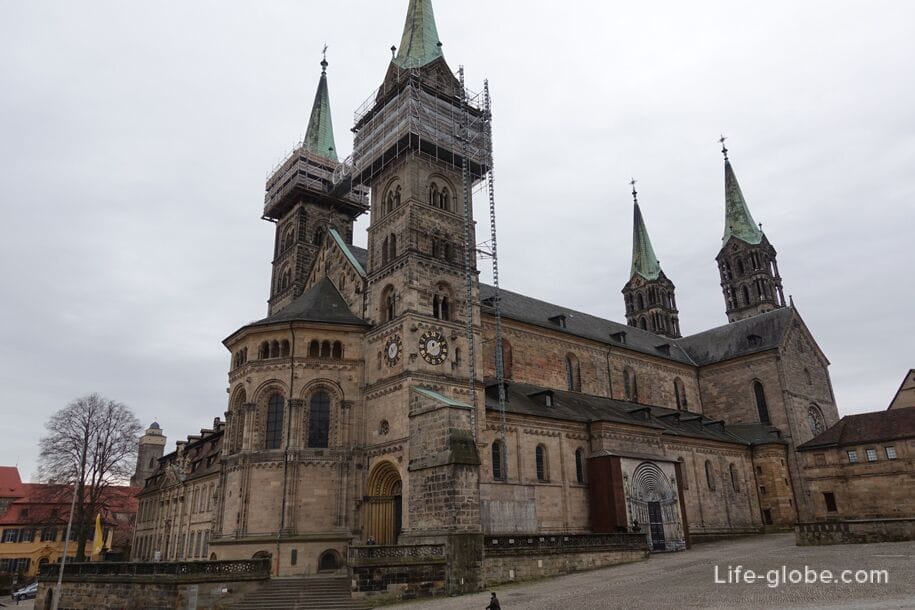
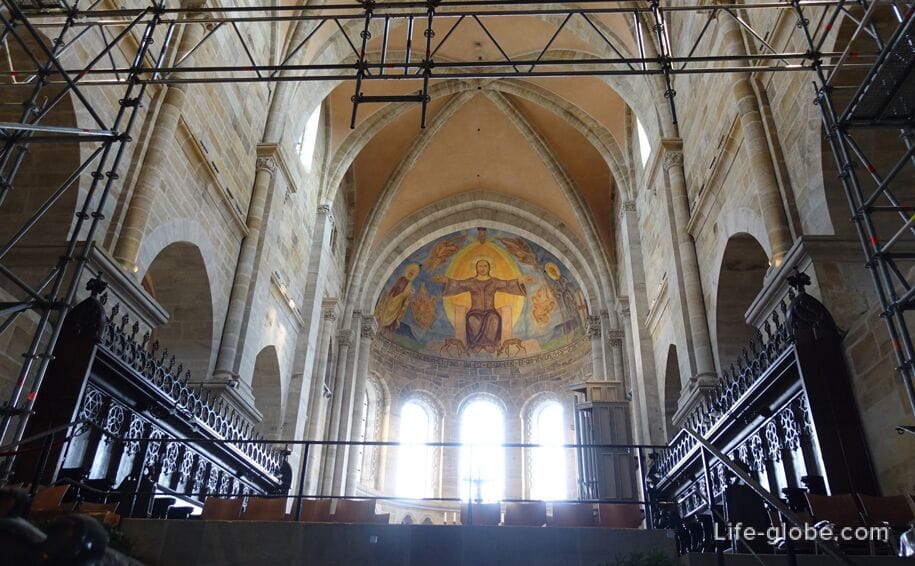

In the neighboring chapter house, to the south (right) of the Bamberg Cathedral, there isCathedral Museum (Diözesanmuseum Bamberg).
The cathedral's chapter house was built by master builder Balthazar Neumann between 1731 and 1733 in the Baroque style. The first plans of the museum were made back in 1907, but only in 1966 it opened under the auspices of the Metropolitan.
The collection of the Museum of the Diocese of Bamberg focuses on treasures and architectural sculptures from Bamberg Cathedral, dating from the time of Henry II and his wife and up to the 21st century.
The museum's website: dioezesanmuseum-bamberg.de .
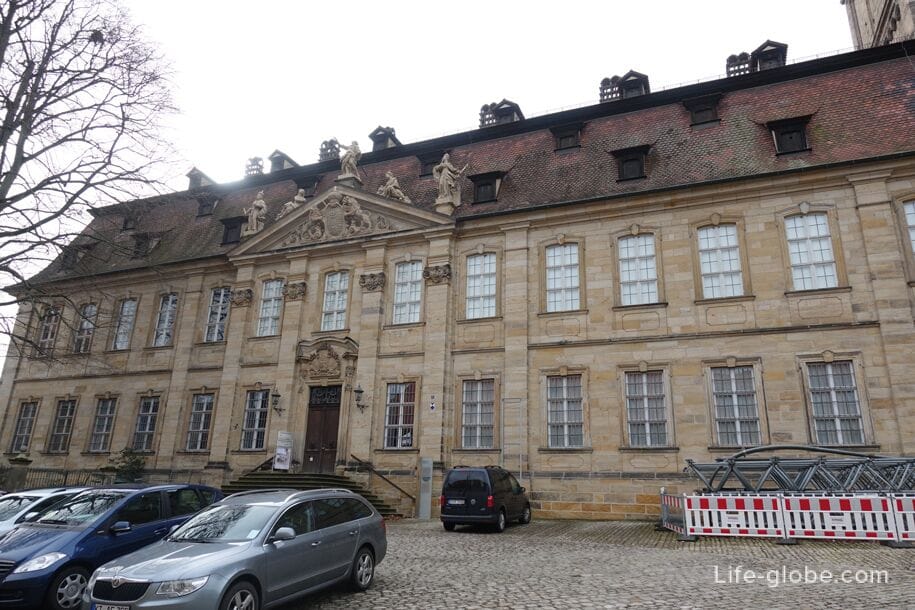
The Old Courtyard or Old Residence (Alte Hofhaltung Bamberg) is a complex of historical buildings that previously served as the residence of bishops.
Initially, the palace of Emperor Henry II was located on the site of the Old Courtyard. Since the diocese was founded in 1007, it is likely that the palace also served as the bishop's residence.
After the palace was left at the full disposal of the bishops, in the 15th and 16th centuries they rebuilt the palace to suit their needs as a complex of buildings in the style of the German Renaissance.
Today, the Old Courtyard stands out with a gate with sculptures, a building with a powerful bay window with rich details in the Renaissance style, which adjoins the gate and a courtyard surrounded by ancient half-timbered buildings.
In the Old Courtyard there are: the Historical Museum (Historische Museum) and the former Catherine Chapel (Katharinenkapelle, Katharinenkapelle), which offers a venue for civil weddings, concerts and lectures, and where from May to October, under the name "Light and Shadow", the 1000-year history of the city is performed (works as a Shadow Theater, Theatre of Shadows). More about the Old Courtyard, the museum and the theater...
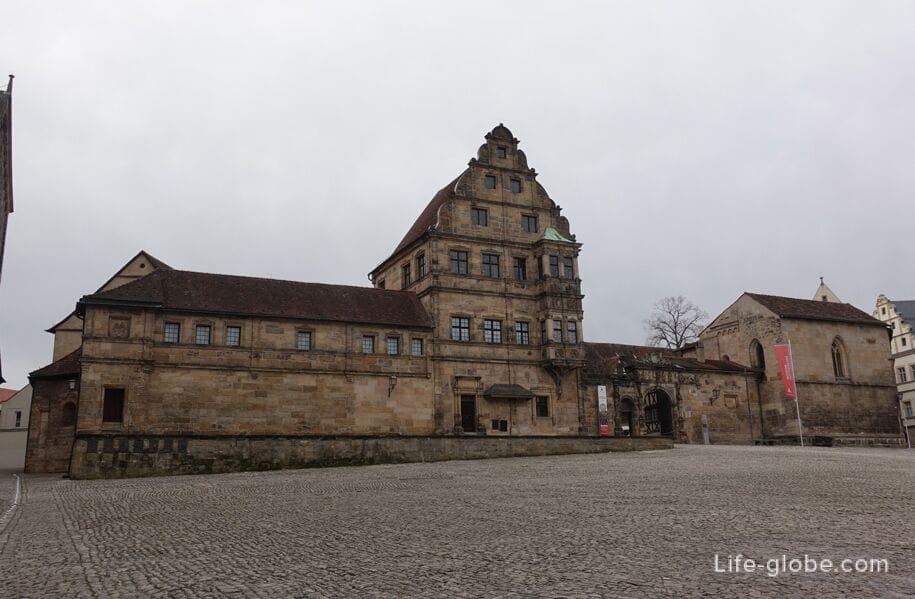
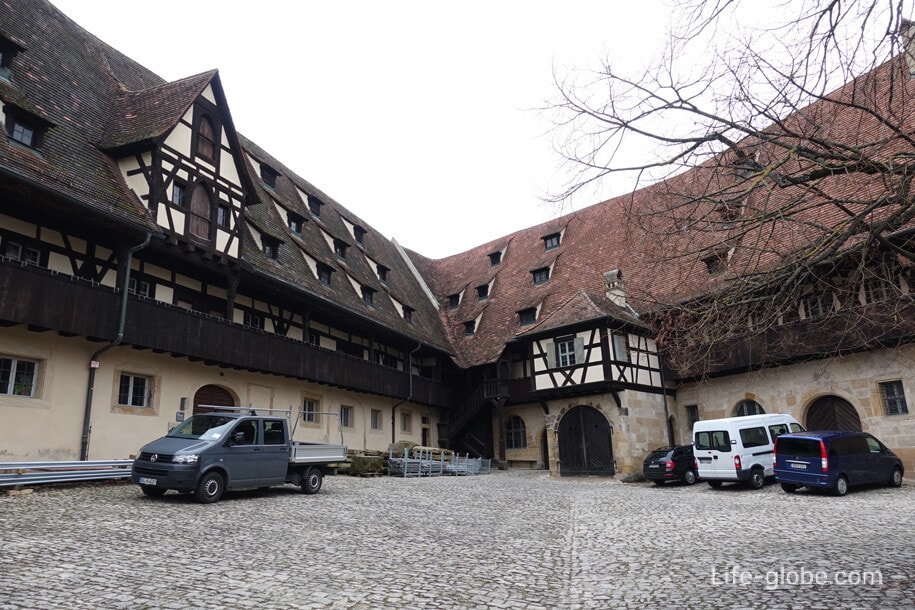

The new residence (Neue Residenz), erected opposite the Strictly Courtyard from the beginning of the 17th century, when the then existing residence (now the Old Courtyard) was already cramped for bishops.
The construction of the New Residence took place in two stages for more than 100 years.
Today, the residence building has several interconnected wings (sandstone buildings), which form a long zigzag structure with architectural portals and various discreet decorations.
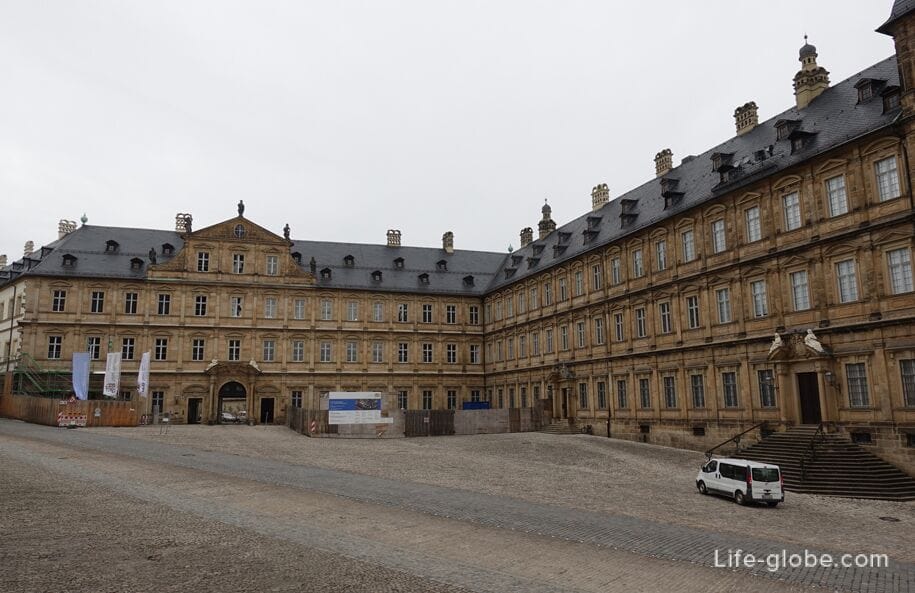
The New Residence houses:
- The State Gallery of Bamberg (Staatsgalerie von Bamberg), which presents almost 50 halls and rooms of the late 17th and 18th centuries in various styles, where art treasures from late Gothic to historicism are presented, including more than 500 pieces of furniture, painting, sculpture and textile art;
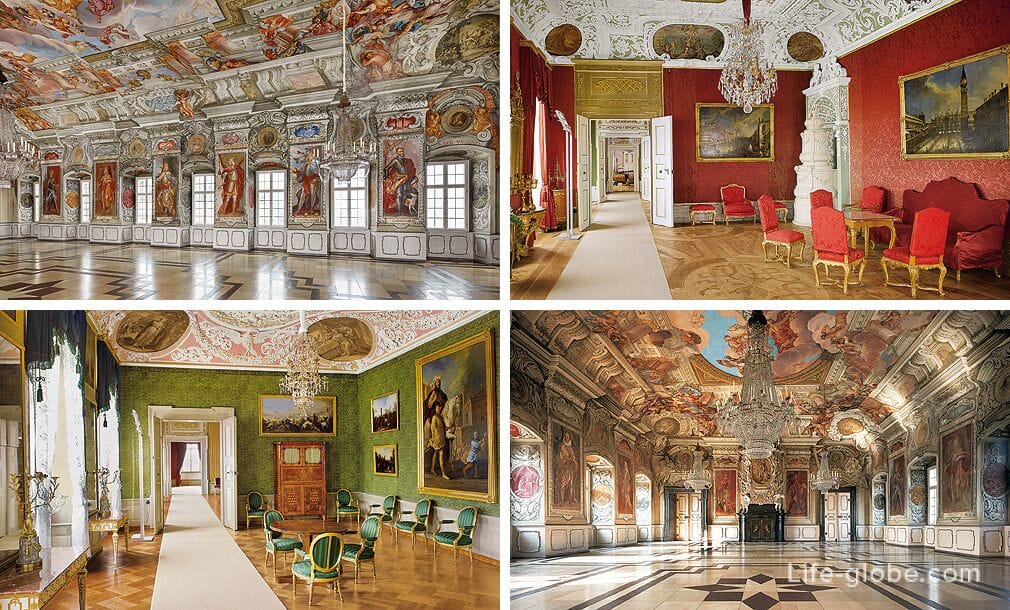
- The Bamberg State Library (Staatsbibliothek Bamberg), located in the east wing of the New Residence and largely preserved the halls of the former residence with stucco and frescoes;
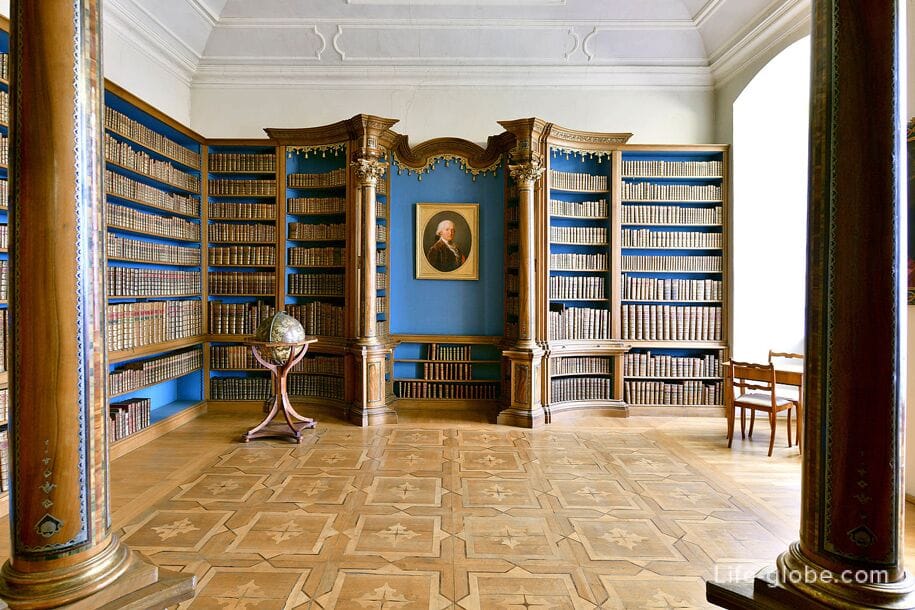
- rosary (Rosengarten Bamberg) - a rose garden located outdoors, between the wings of the New residence (courtyard).
Roses and lime trees grow in the garden, paths are laid out, there is a rococo pavilion (now a cafe), sculptures and a memorial to Otto and his wife Amalia in a blind arch in the wall.
The rose garden offers panoramic views of Bamberg, as well as Michelsberg with the former Benedictine monastery. Learn more about the New Residence, gallery, library and rose Garden...
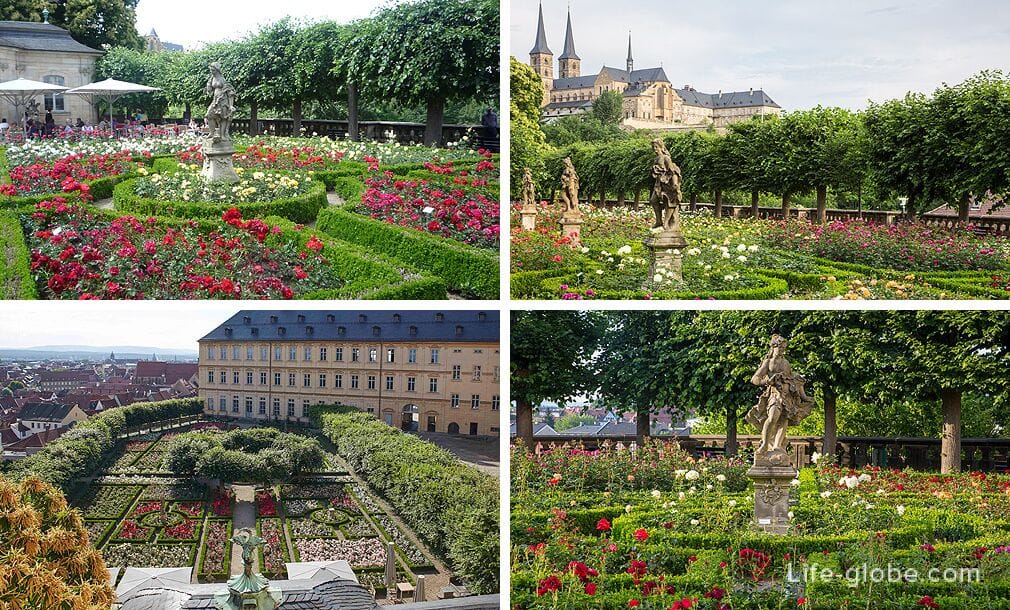
St. Michael's Abbey, also known as St. Michael's Monastery (Kloster Michaelsberg / Mikaelsberg) is a former Benedictine monastery founded in 1015 by the first bishop of Bamberg, Eberhard, at the suggestion of Emperor Henry II.
Today, within the walls of the former monastery there are: a nursing home, the current church of St. Michael with the grave of Otto I (Michaelskirche), a cafe, and in the former monastery brewery is open Franconian Beer Museum (Fränkisches Brauereimuseum Bamberg). There is also a Baroque garden near the monastery, and panoramic views of Bamberg open from the terraces. More about St. Michael's Abbey...
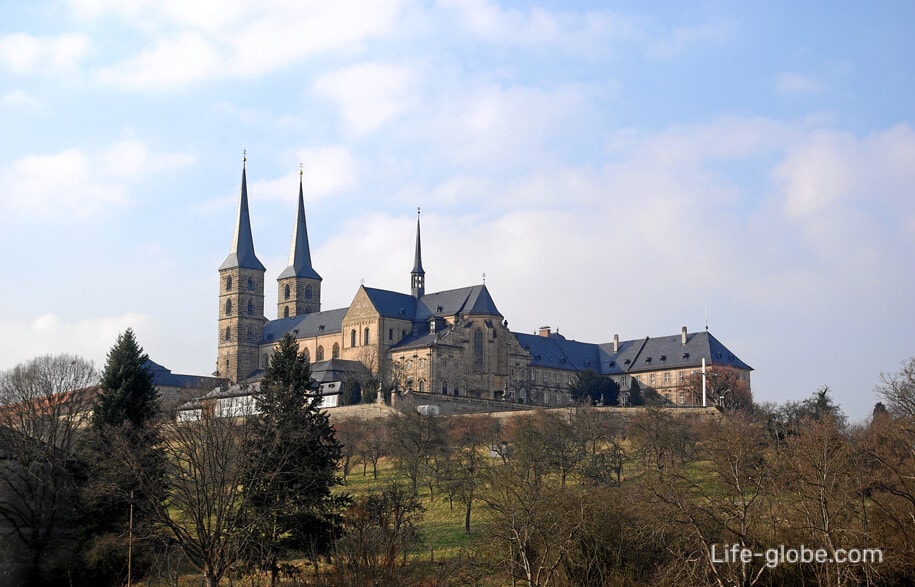
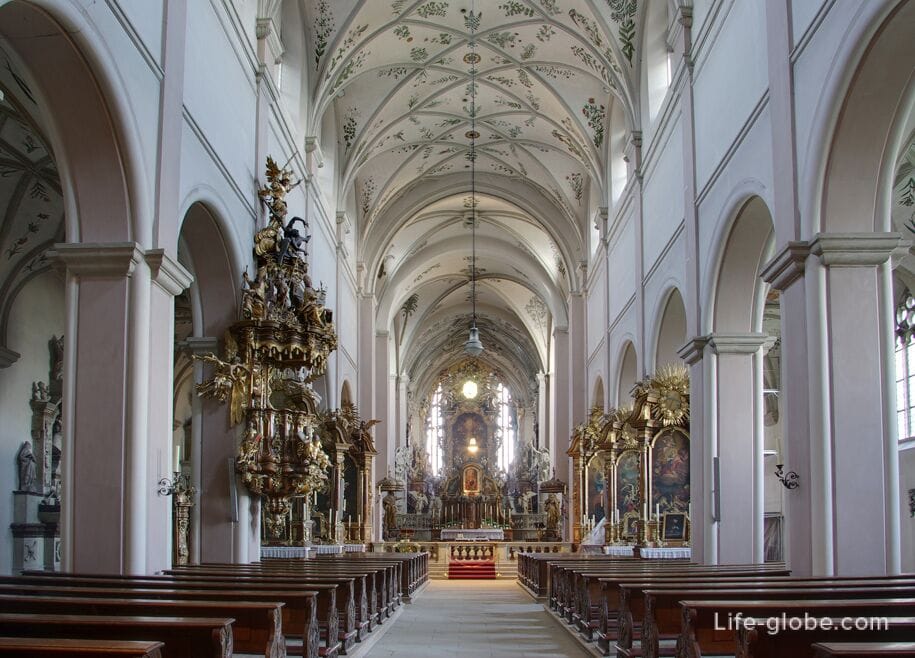
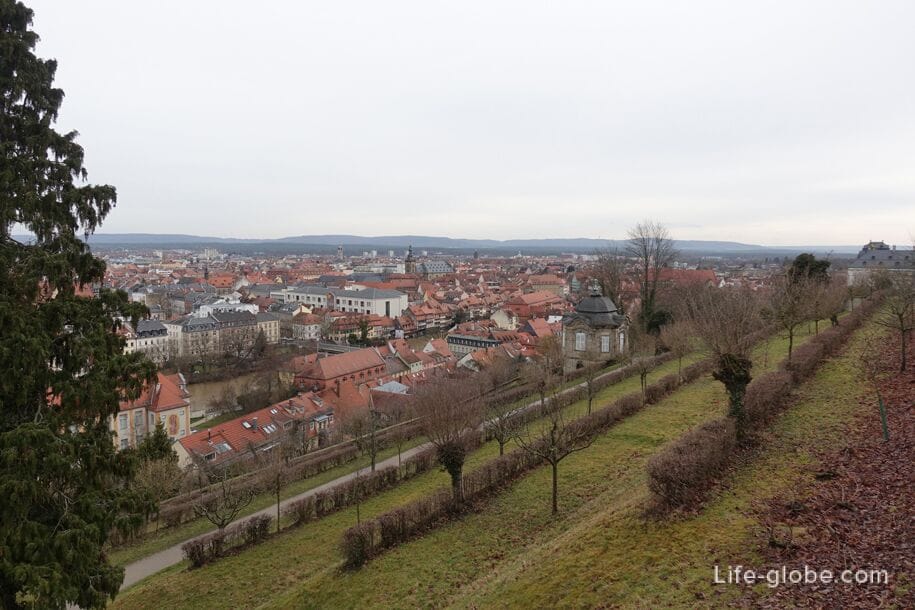
The Benediktinerweg ("Benedictine Path" or "Benedictine Way") runs through the former gardens of St. Michael's Abbey along which you can walk along fountains and vineyards.
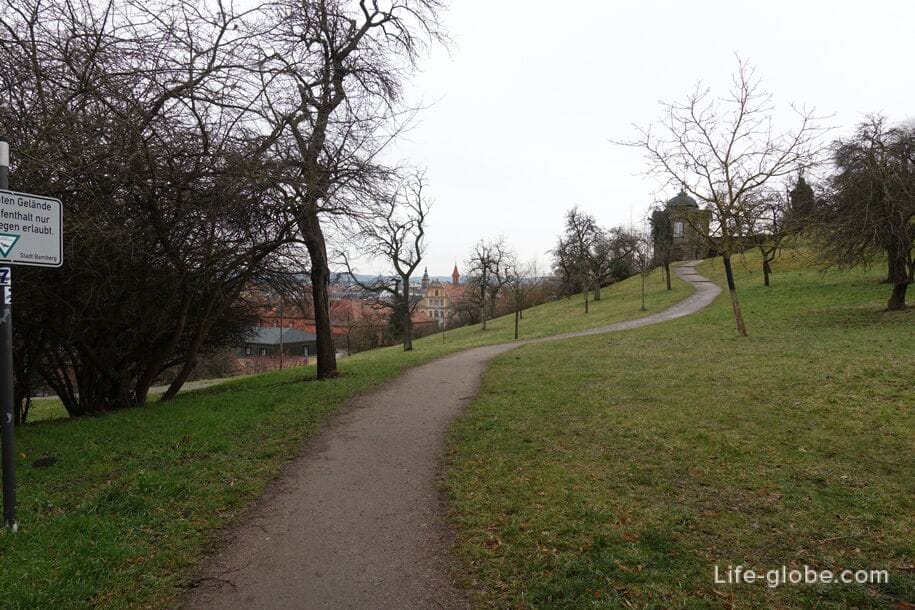
Altenburg Fortress or Altenburg Castle (Schloss Altenburg Bamberg) is a medieval fortress (castle), which is one of the most striking and important sights of Bamberg.
The first mention of Altenburg dates back to the beginning of the 12th century, although, most likely, since the 9th century there was some uninhabited strategic fortification at this place, which served mainly as a refuge for bishops and townspeople.
Today, the Altenburg fortress is not medieval in the literal sense of the word, it has been restored on the preserved parts and is a complex of buildings in the historical style, surrounded by a wall with towers.
On the territory of the fortress there are: the main palace of 1902 and a restaurant, a well of 1893, a Hoffmann's room, a 33-meter observation tower of the 13th century (you can climb to the observation deck of the tower), a bear cage, a chapel.
Panoramic views of the city of Bamberg and the surrounding area open from the observation terraces of the fortress. More about the Altenburg Fortress...
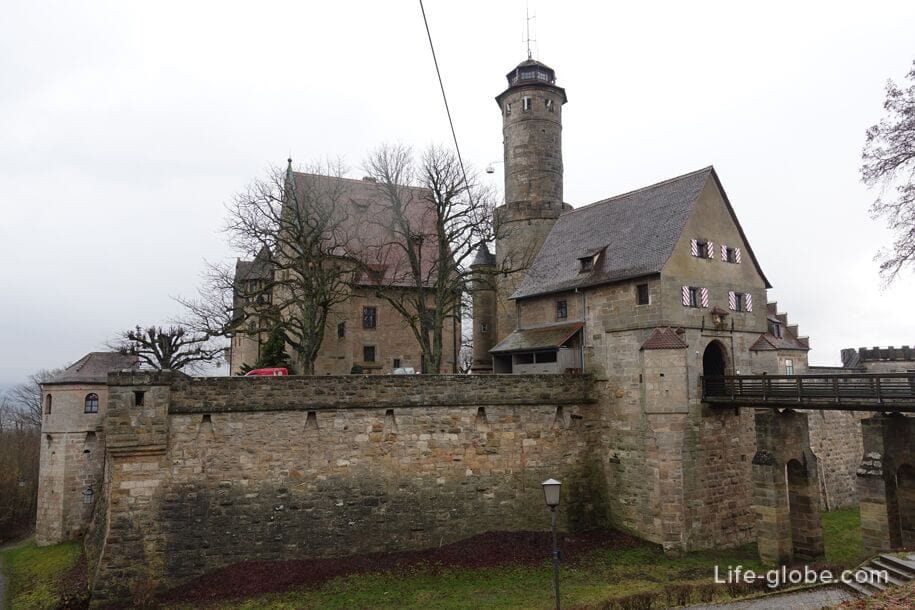

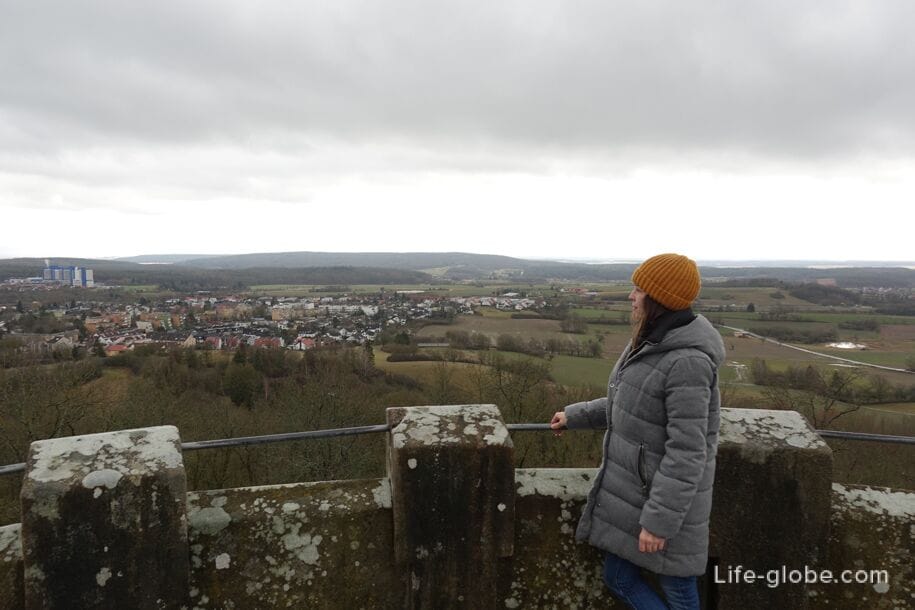

On the way from the center of Bamberg to the Altenburg fortress, on a natural hill near Altenburgen Strasse (Altenburger Str.), there is an open-air observation deck - an observation deck on the Altenburg hill (Aussichtspunkt am Altenburger Berg).
The observation deck offers good views of the historic center of Bamberg and the surrounding area.
The viewing room is free, open 24 hours a day.
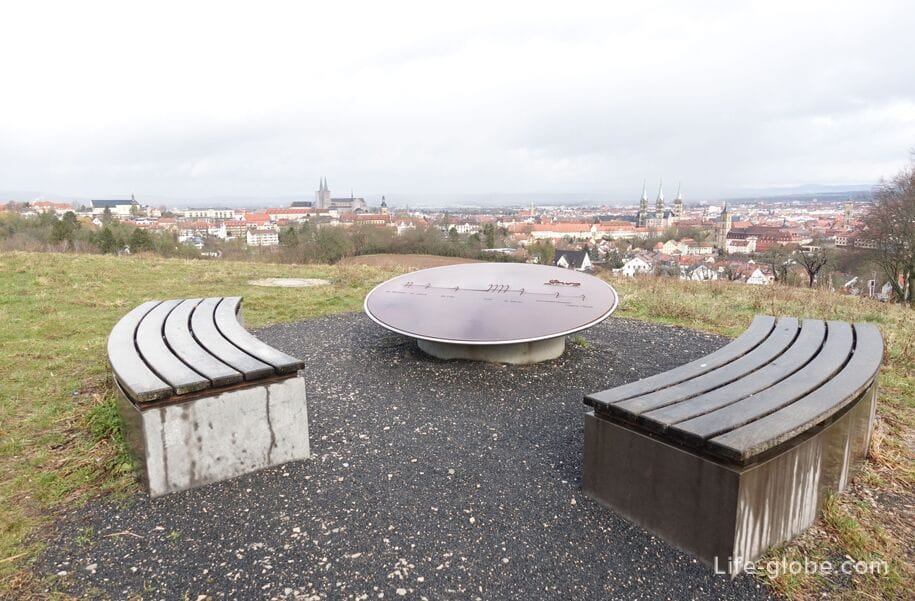
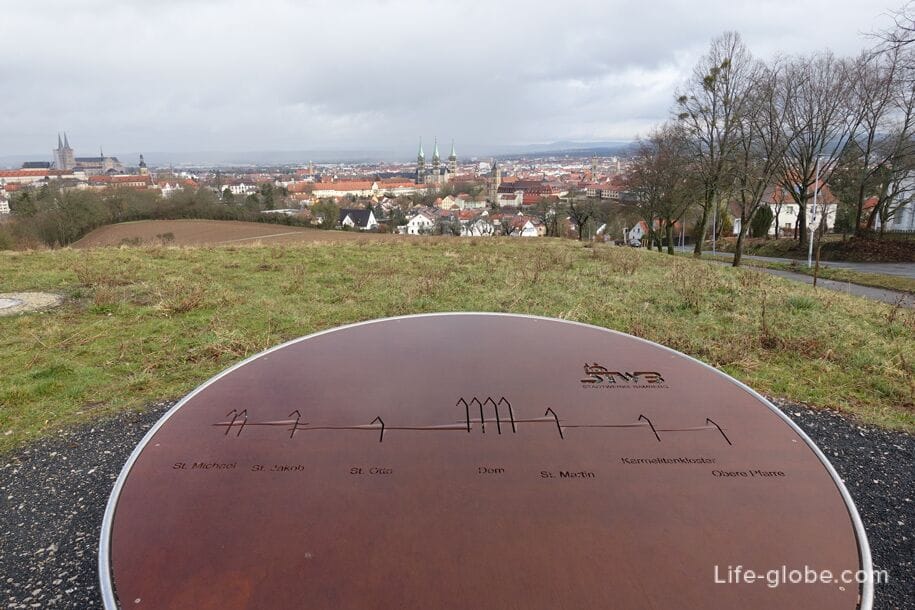
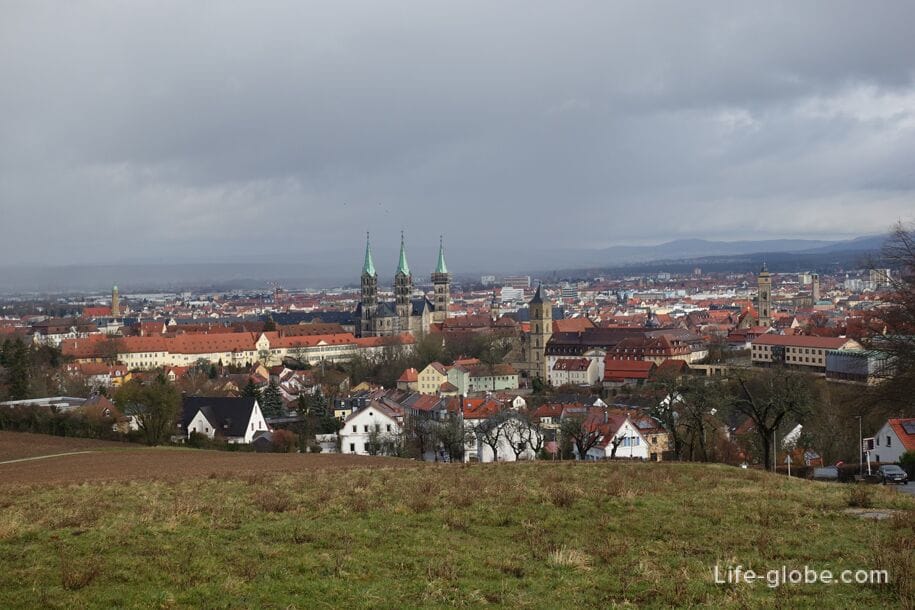
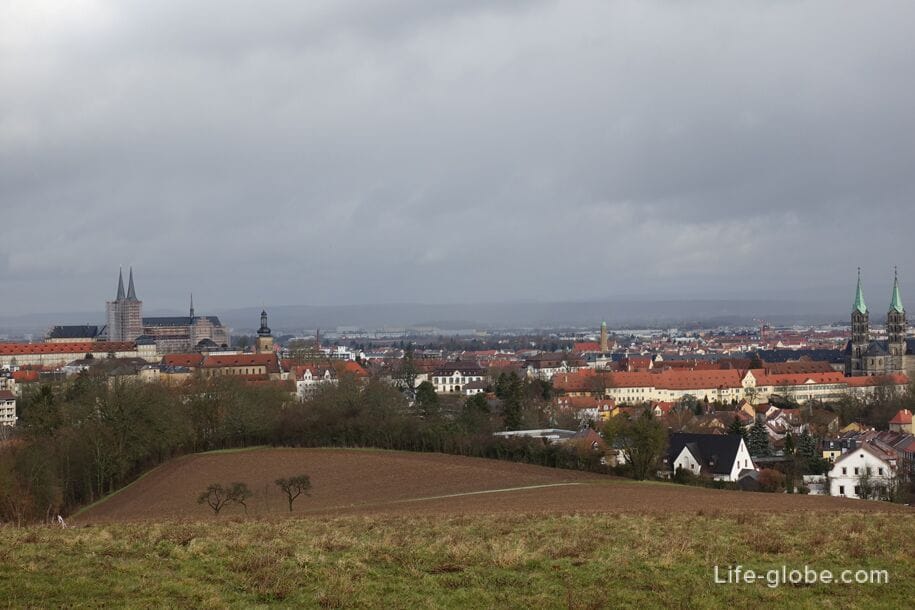
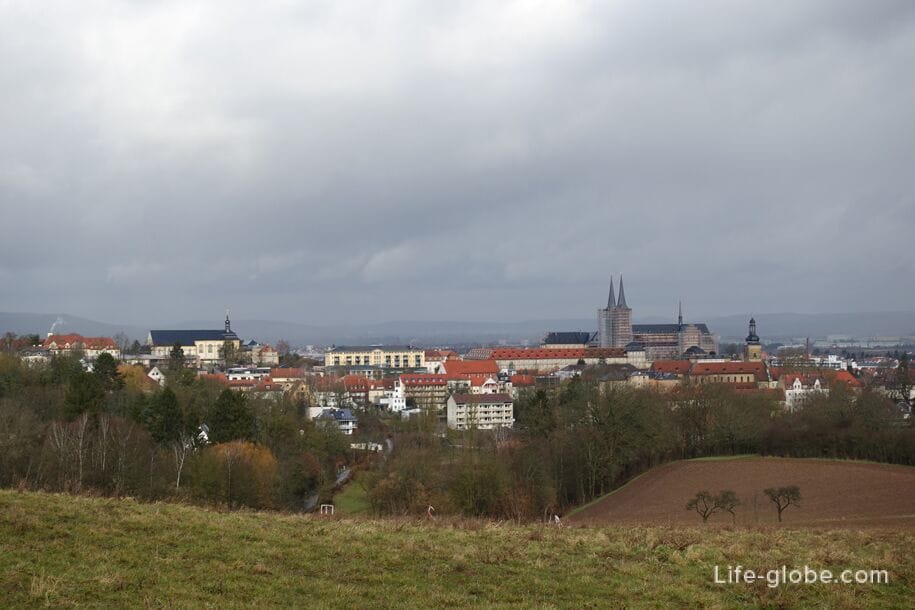
Maksplatz or Maximilian Square (Maximiliansplatz Bamberg / Maximiliansplatz Bamberg) is the most famous and one of the largest city squares in the historical center of Bamberg.
On Christmas Eve, the main Bamberg Christmas Market is located on the square and nearby streets.
The square is decorated with the Maximilian Fountain (Maximiliansbrunnen), which, like the whole square, is named after King Maximilian I. The fountain was created by Ferdinand von Miller in 1888. The fountain statues were cast in 1880.
The perimeter of the square is surrounded by historically buildings that form a characteristic urban ensemble in the late Baroque style. The main building on the square is The new Town Hall (Neues Rathaus), erected by Balthazar Neumann in the 18th century and today is the city hall. Learn more about Maximilian Square...
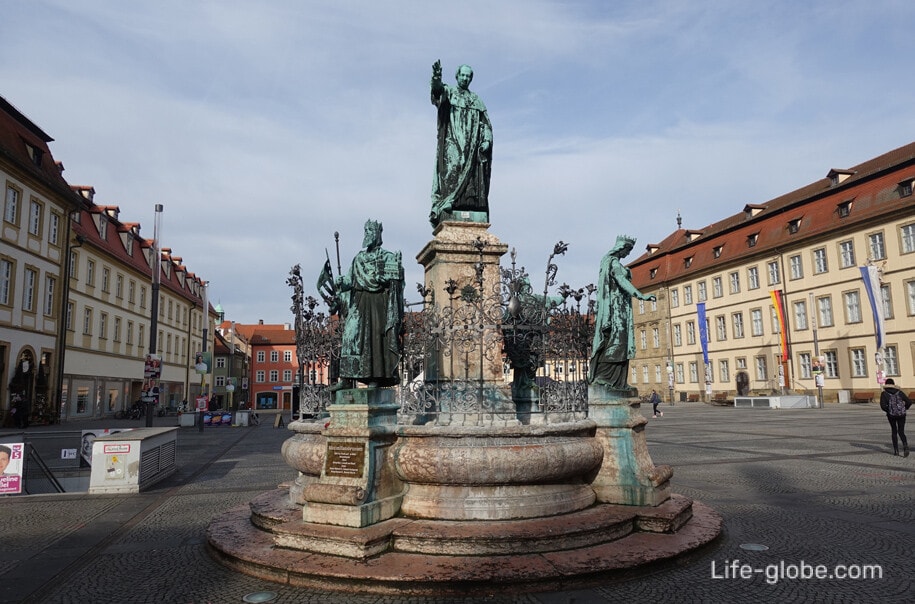

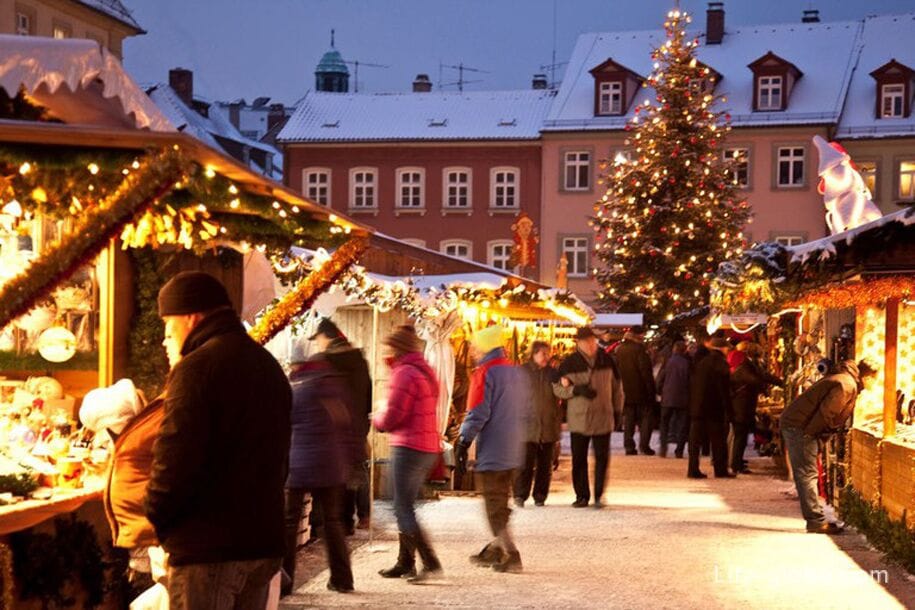
The Museum of Natural History (Naturkunde-Museum Bamberg), located in the halls of the former Jesuit College, combines the historical with the modern.
The most notable in the museum is the Bird Hall or the Bamberg Bird Hall (Vogelsaal), which exhibits numerous preserved specimens of animals, especially birds, as well as corals, shells, fish, snakes and other creatures.
The Bird Hall was founded in 1791 by Prince-Bishop Franz Ludwig von Erthal as a "cabinet of natural objects". The two-storey hall in the early classical style has survived to the present day and can be considered one of the most beautiful in this style in the world.
In addition to the hall, the museum also houses modern exhibitions on various topics of natural history.
Museum address: Fleischstraße 2, 96047 Bamberg.
The museum's website: naturkundemuseum-bamberg.de.
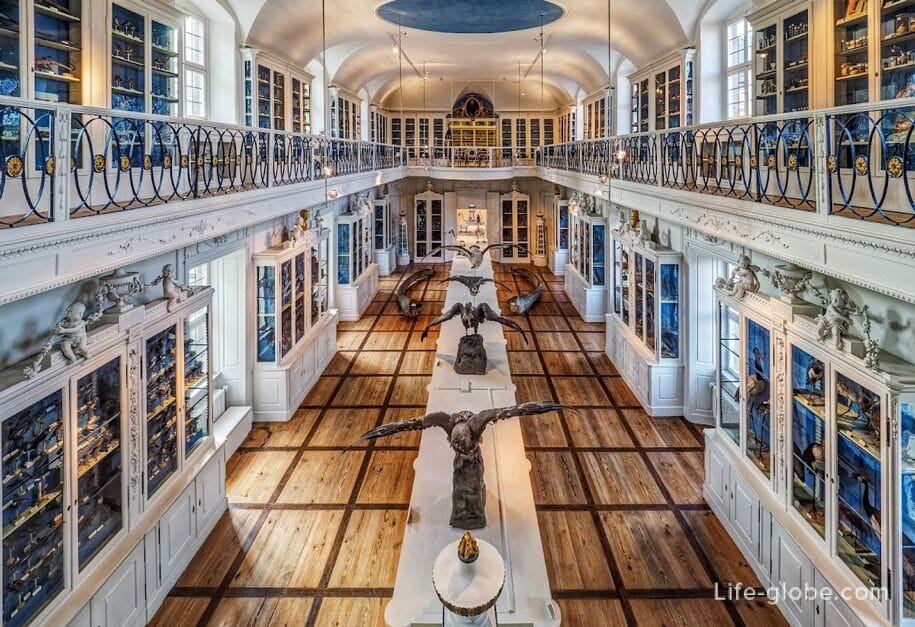
The Green Market (Grüner Markt) is a square and a street that are the main tourist spots in Bamberg.
The Green Market leads to the Maxplatz and it also houses Bamberg's main Christmas market.
Along the Gruner Markt there are historical buildings housing shops, cafes, restaurants and hotels
In the pedestrian zone of the Green Market there are stalls selling fruits, vegetables and flowers. Hence the name "Green Market".

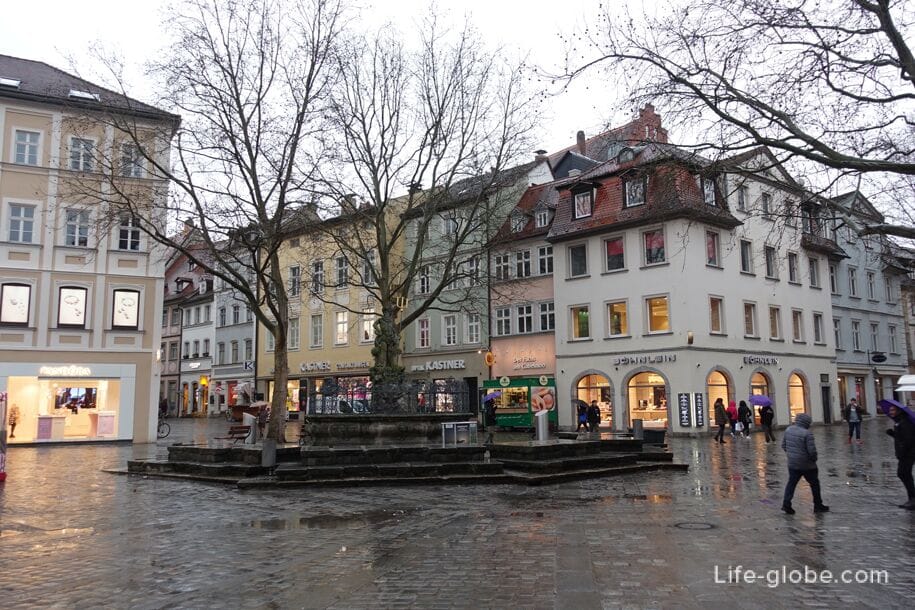
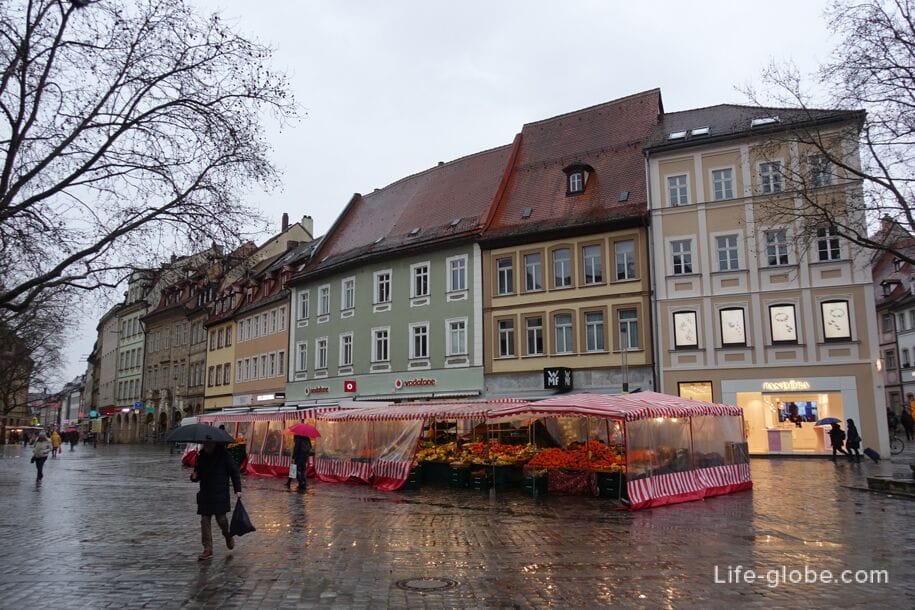
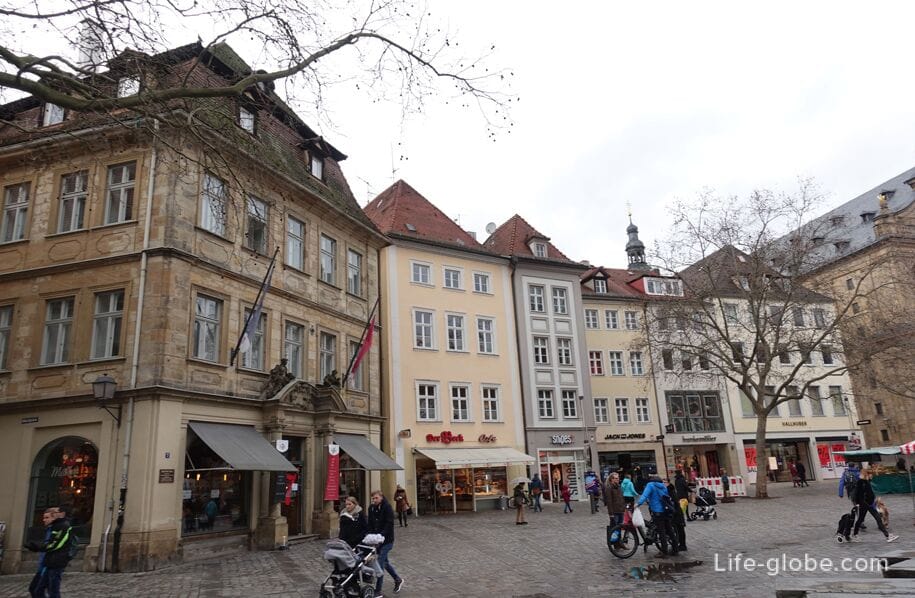


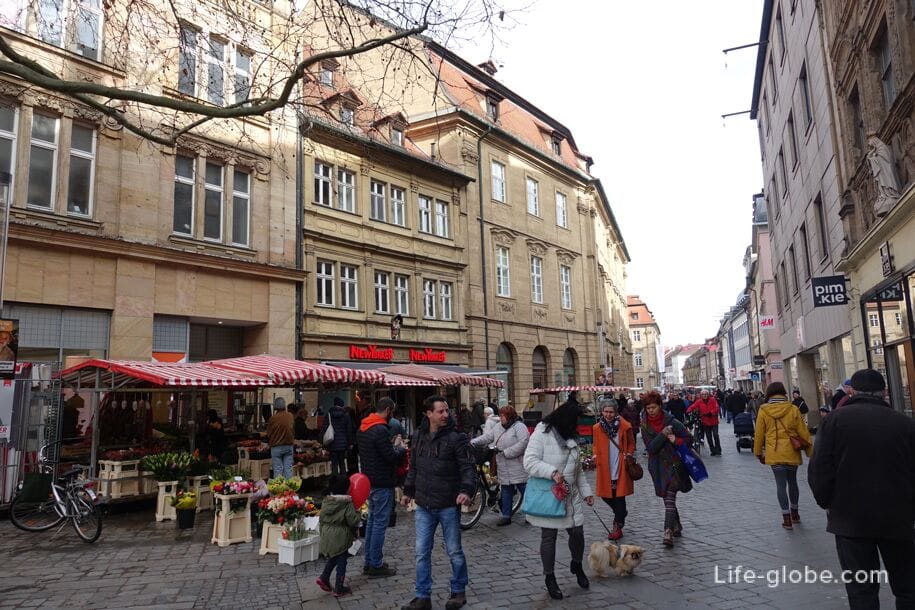
In the center of the square, the monumental fountain of Neptune (Neptunsbrunnen), which the residents of Bamberg affectionately call Gabelmann, is noteworthy.

Near the fountain of Neptune stands the beautiful Baroque church of St. Martin (Kirche St. Martin).
The origin of the church is closely connected with the Jesuit Order, as it was built as a university church and a Jesuit college church. The church was founded on August 16, 1686 and consecrated on May 17, 1693.
The mighty 55-meter-high church tower is not one of the tallest in the city, but it is a striking element of the urban landscape thanks to the surrounding balustrade and the "IHS" on the weather vane, which can be seen from afar. The tower was built in 1696.
The interior of the church harmoniously intertwines modesty and splendor of decoration. The church is notable for: altars, pulpit, organ, sculptures and a false inner dome with a dome fresco by Giovanni Francesco Marcini (1714-1716).
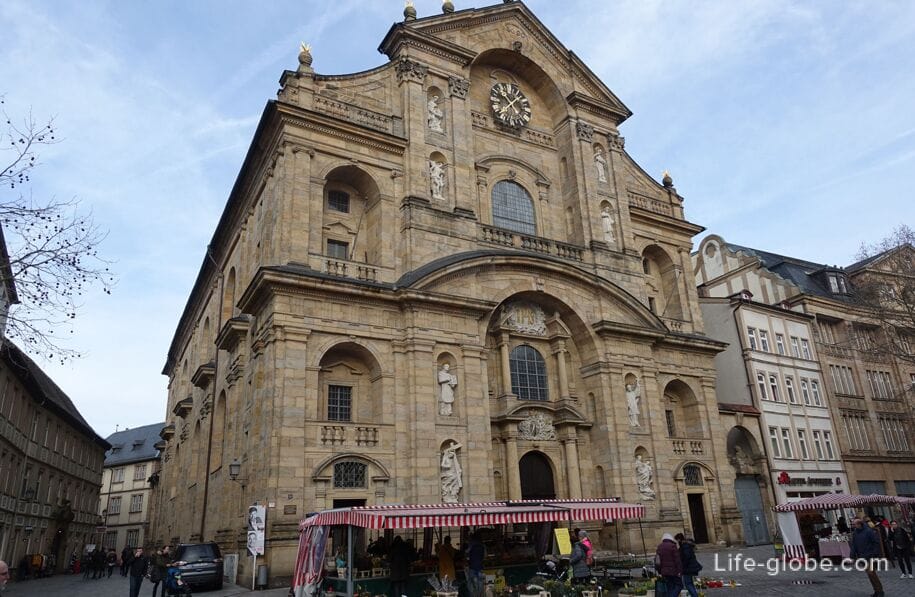
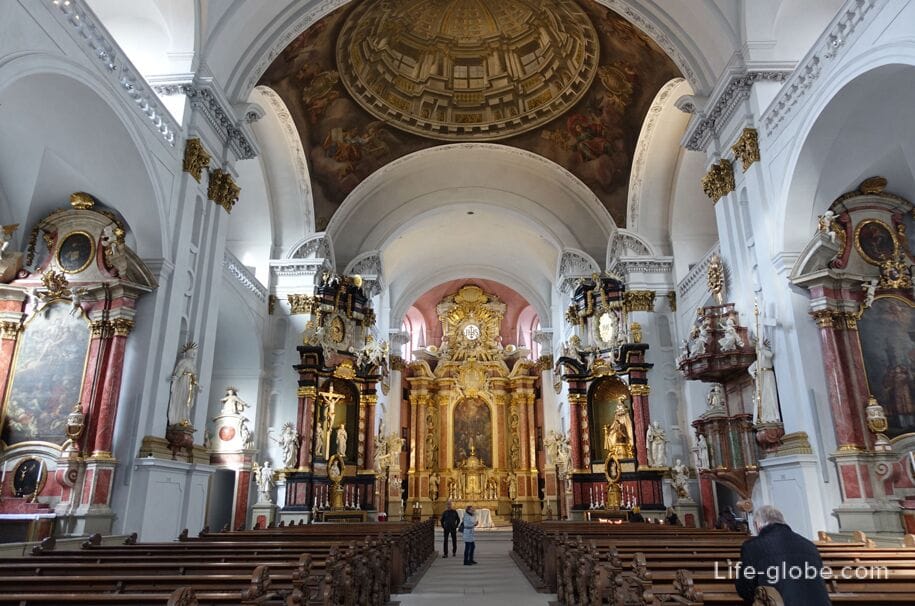

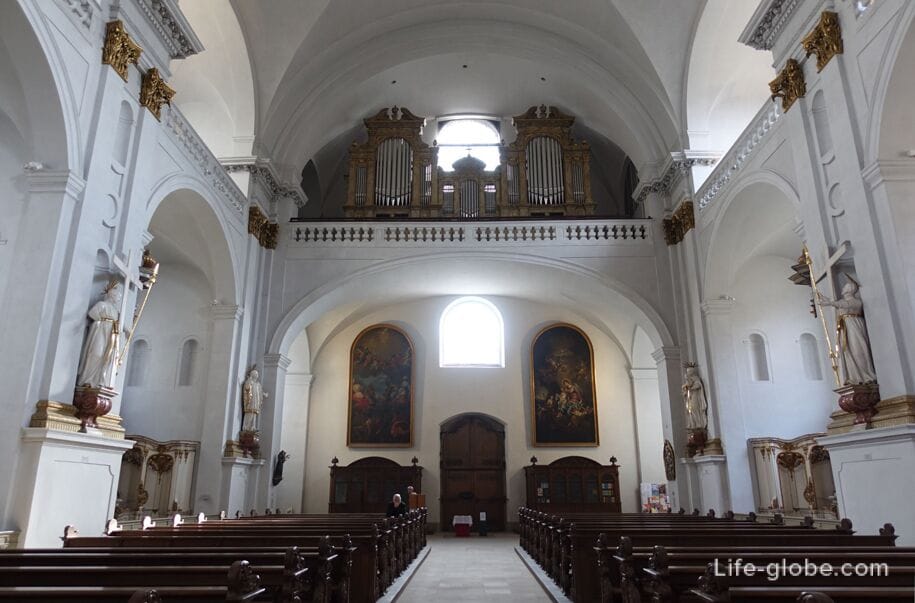
The small Obstmarkt square in the old town of Bamberg is one of the most cozy and colorful in the city.
The square is surrounded by a historic colorful building with cafes and restaurants with tables in the open air.
In the center of the square there is a three-dimensional fountain-pool.
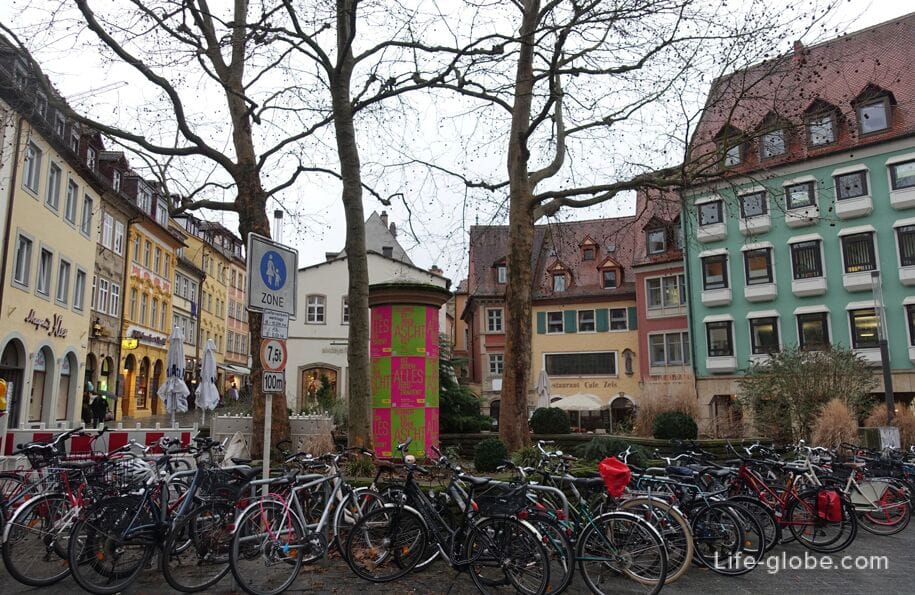
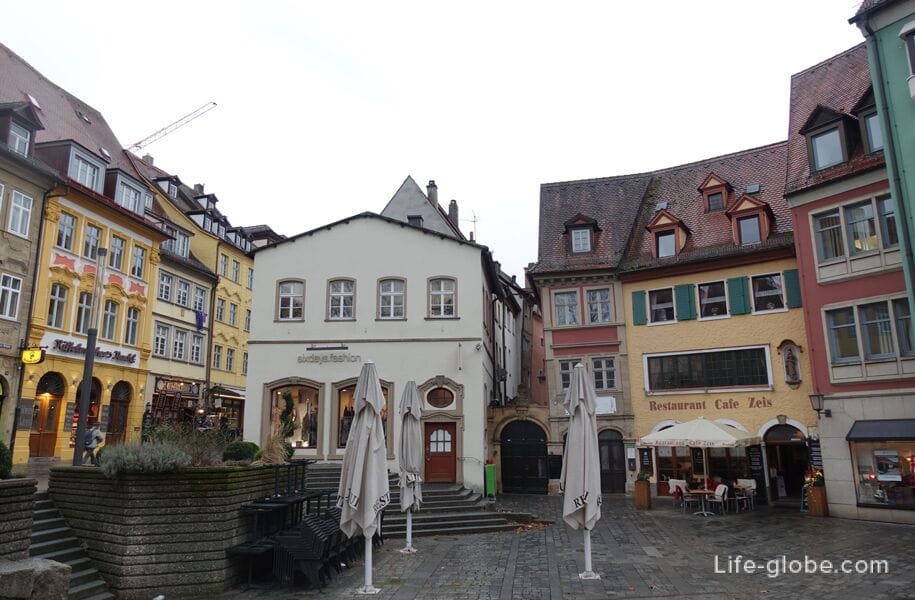
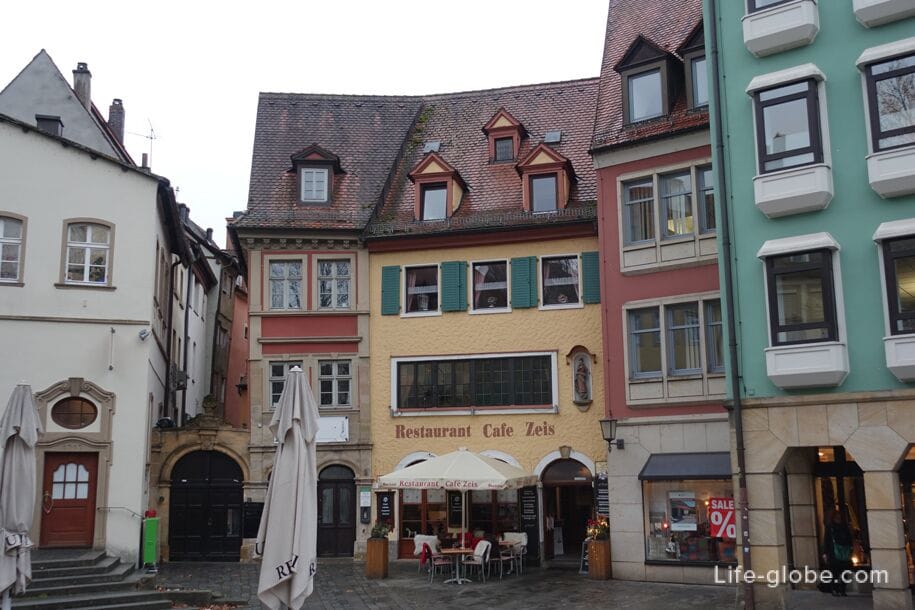
One of the attractive major streets of the historical center of Bamberg is Langestrasse (Langestr.).
Along the street, bright buildings with an abundance of cafes, restaurants, shops and accommodation facilities are located in dense rows:
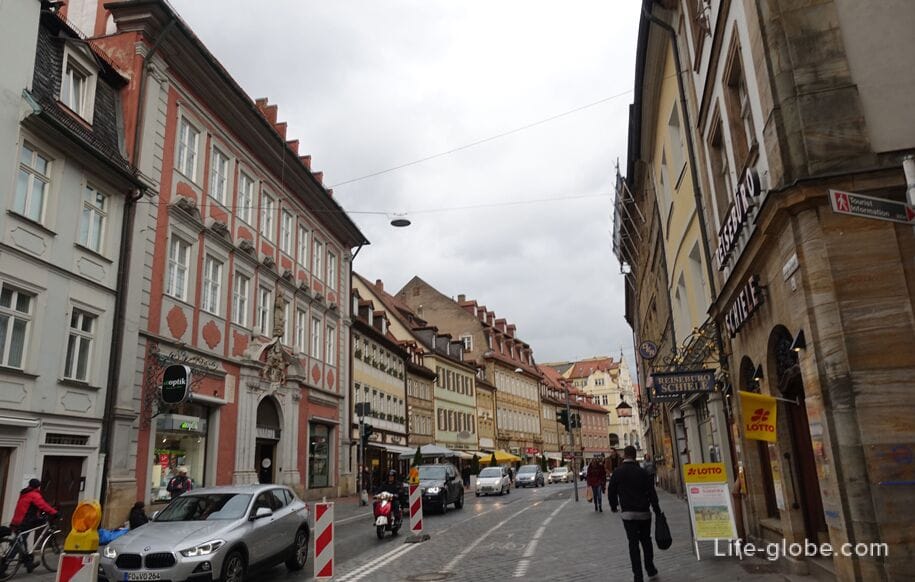
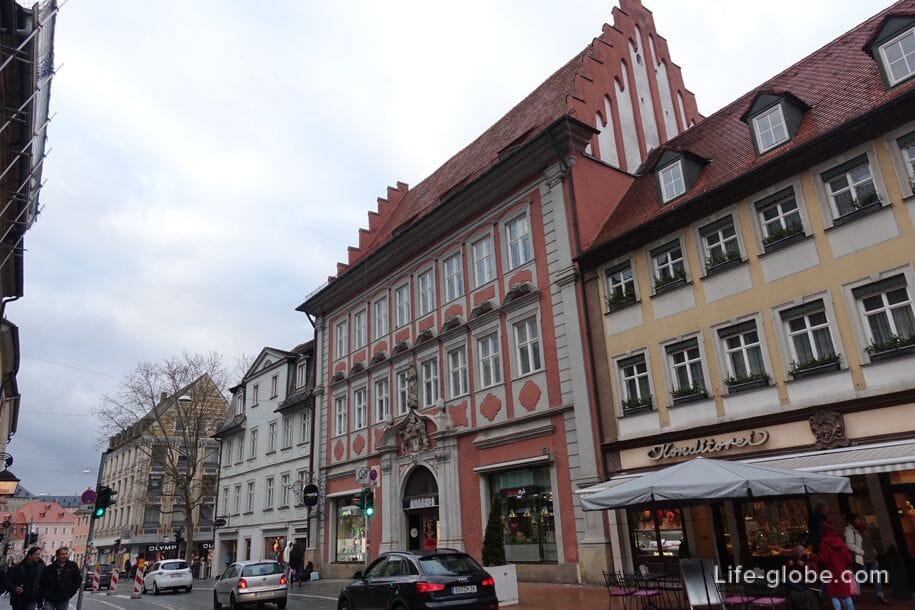
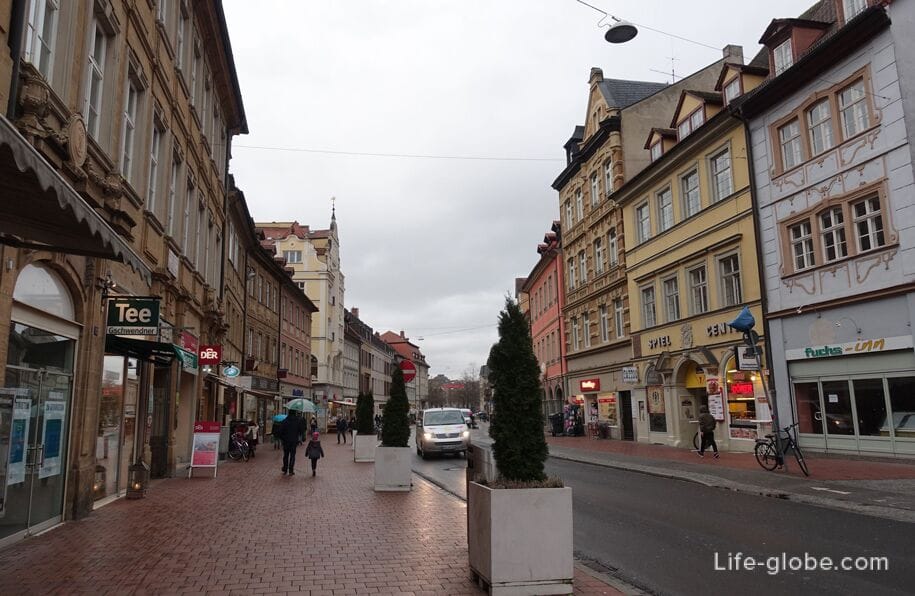
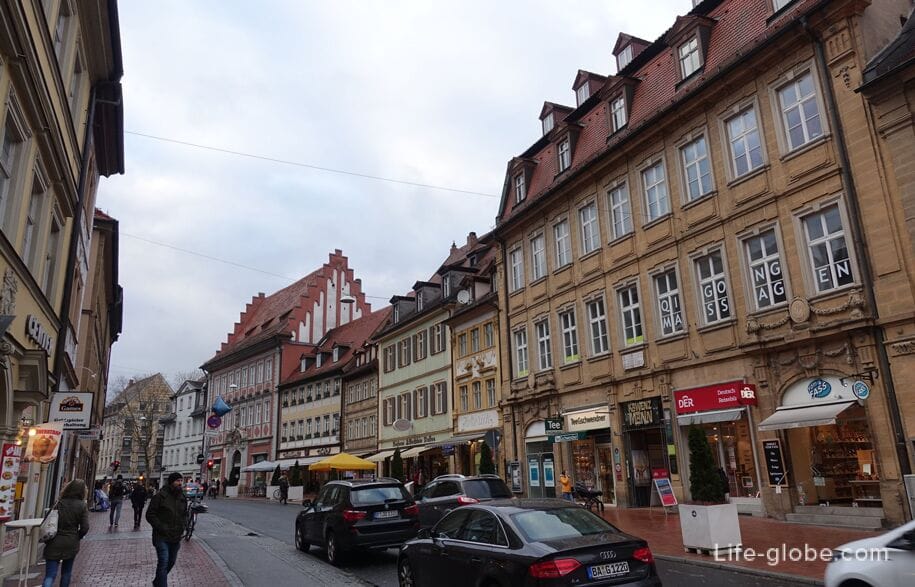



At the end of the Langestrasse is one of the most exquisite Wilhelmine city squares of the late 19th century - Schönleinsplatz square with a fountain and a park area.
The square is decorated with:
- monumental equestrian monument to Prince Regent Luitpold (Denkmal des Prinzregenten Luitpold);
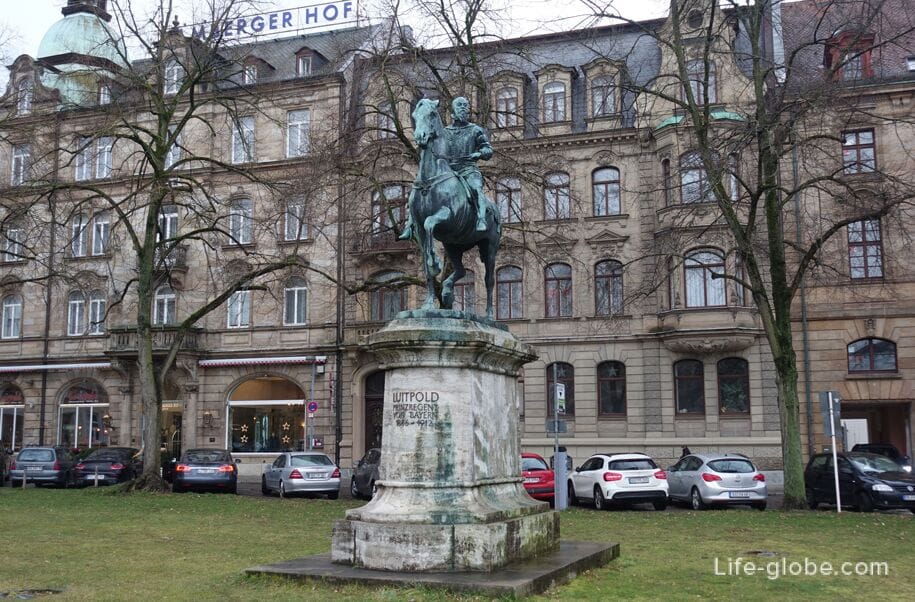
- sculpture group "Meeting" (Skulpturengruppe "Meeting") by Chinese master Wang Shugan, depicting eight squatting life-size figures;
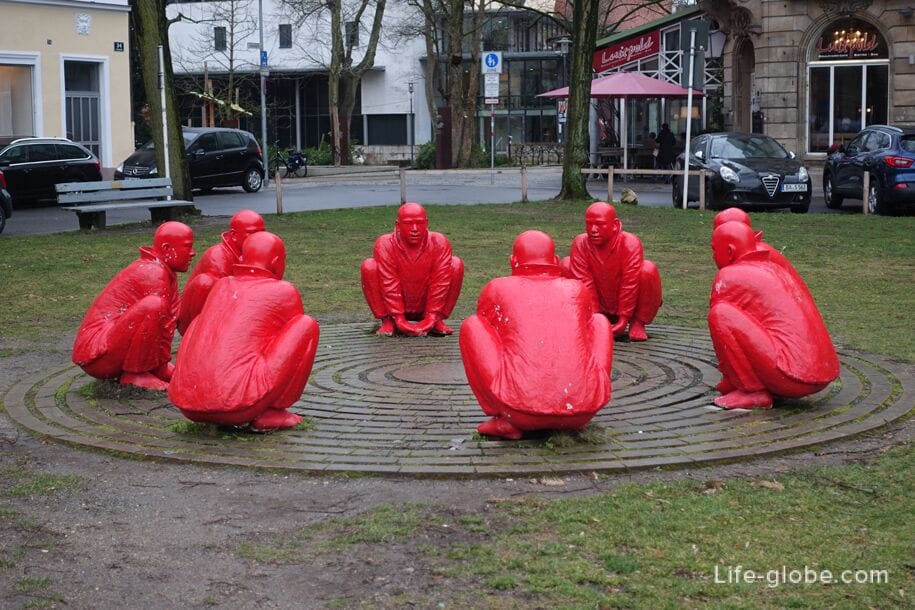
- Hexenmahnmal - a light sculpture at ground level commemorating the victims of illegal persecution, hunting and so-called witch trials that took place in Bishop Bamberg, especially between 1612 and 1631, when about 1,000 innocent people (women, men and children) were brutally tortured and killed during several waves persecution.

From Langestrasse Street, other city streets diverge in different directions, some of which are distinguished by the construction of more massive buildings.
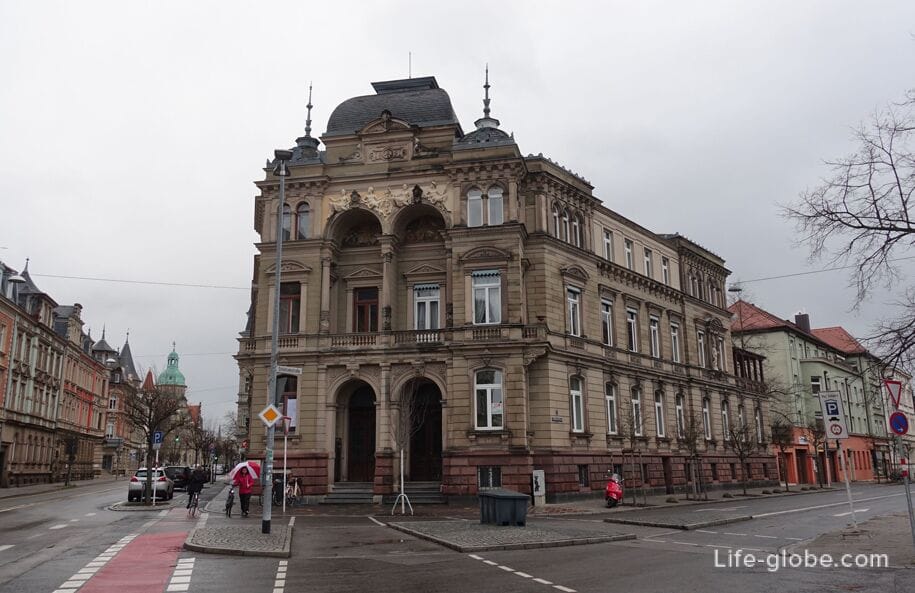
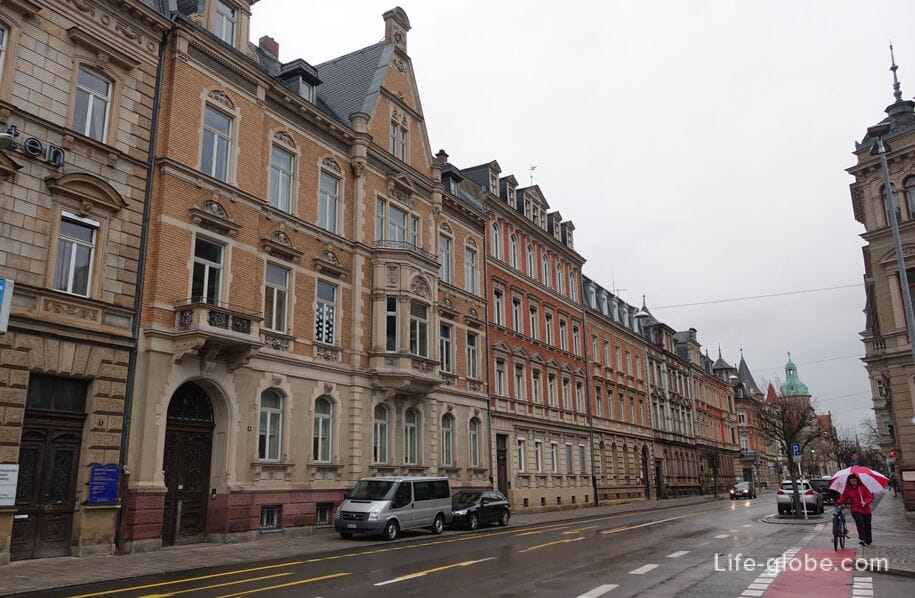

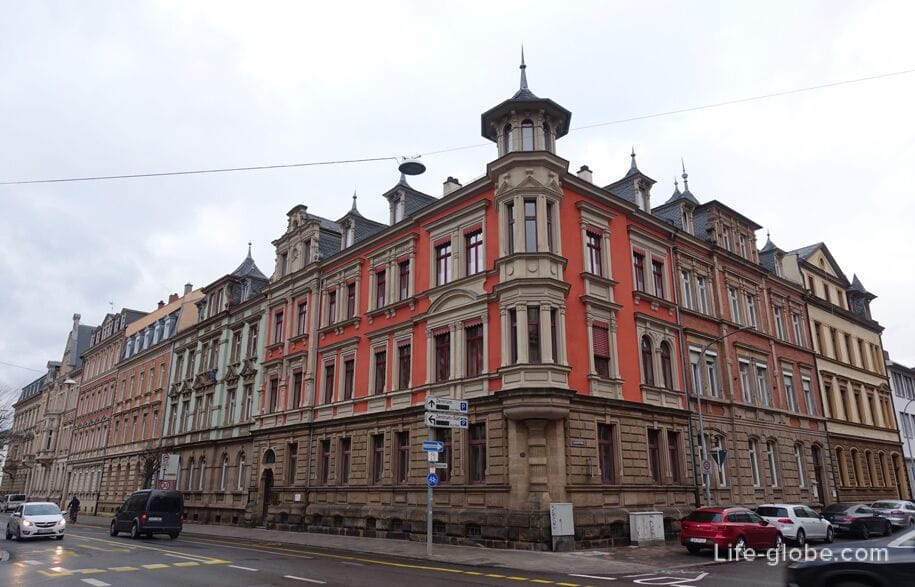

The Museum of Modern Art (Kunstraum Kesselhaus) is an exhibition space of contemporary fine art located in the hangar halls of the former boiler house in the old part of Bamberg.
Museum address: Untere Sandstraße 42, 96049 Bamberg.
The museum's website: kunstraum-jetzt.de .

The Bamberger Marionettentheater (Bamberger Marionettentheater) was founded in 1986, is famous for the historical stage of the 1st half of the 19th century and offers puppet productions - plays of the German romantic and classical periods; the repertoire includes in constant change: fairy tales, dramas and operas, mainly in the original versions of their respective authors.
The theater is located in the historic Bamberg townhouse of the 18th century - "Staubsche House" (Staubsche Haus), at the address: Untere Sandstraße 30, 96049 Bamberg.
The theater's website: bamberger-marionettentheater.de.
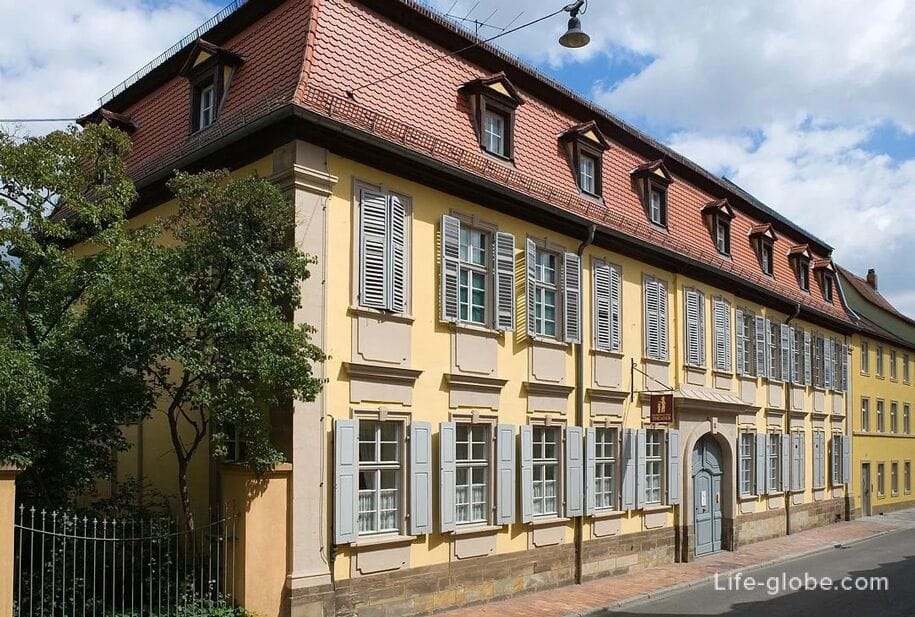
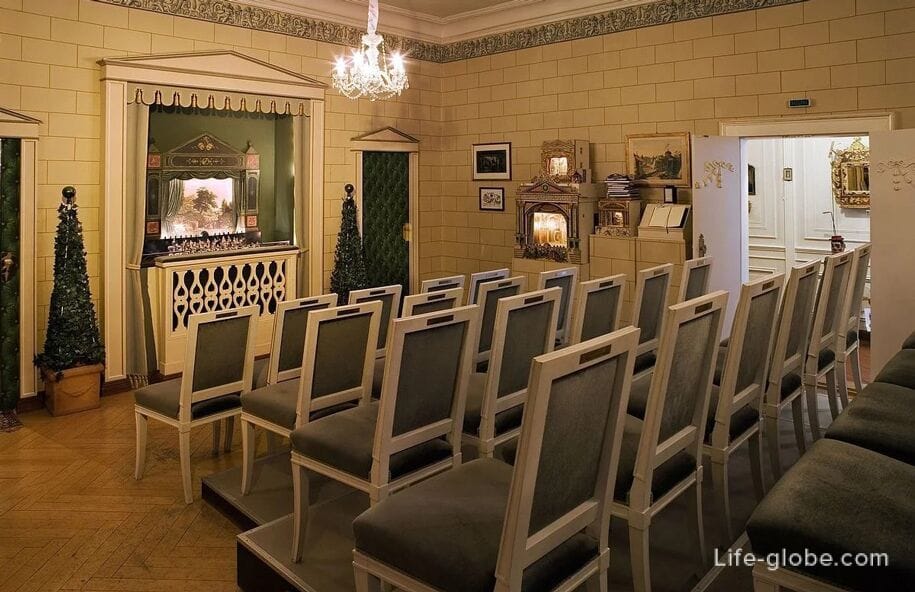
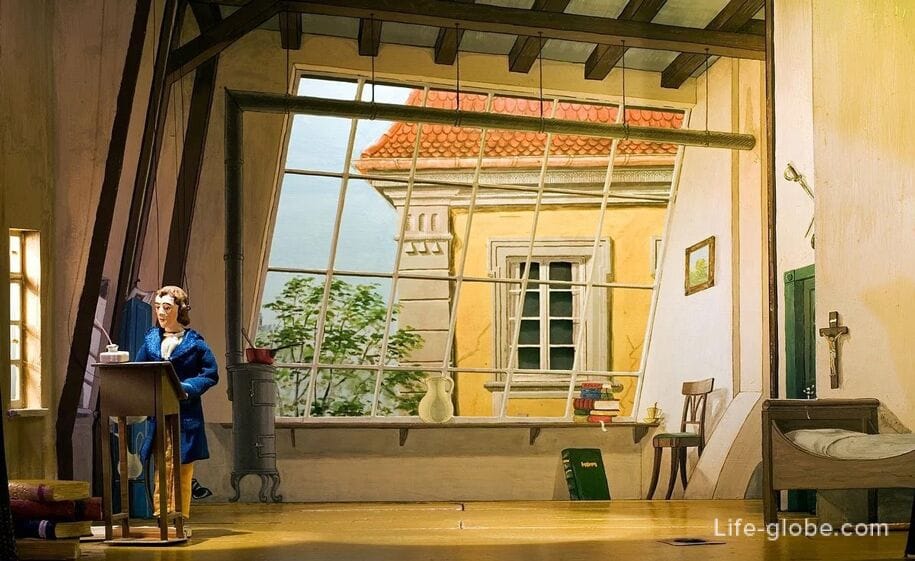
The Bamberg Concert and Congress Hall (Konzert- und Kongresshalle Bamberg) is primarily home to the Bamberg Symphony Orchestra - the Bavarian State Philharmonic.
The Bamberg Concert Hall is also a place with many possibilities as a venue for congresses and conferences, as well as an exhibition hall. It is also used for a wide variety of events, from festivals and cabarets to pop concerts, musicals and dance shows.
Hall address: Mußstraße 1, 96047 Bamberg.
Website of the hall: bamberg-ce.de.
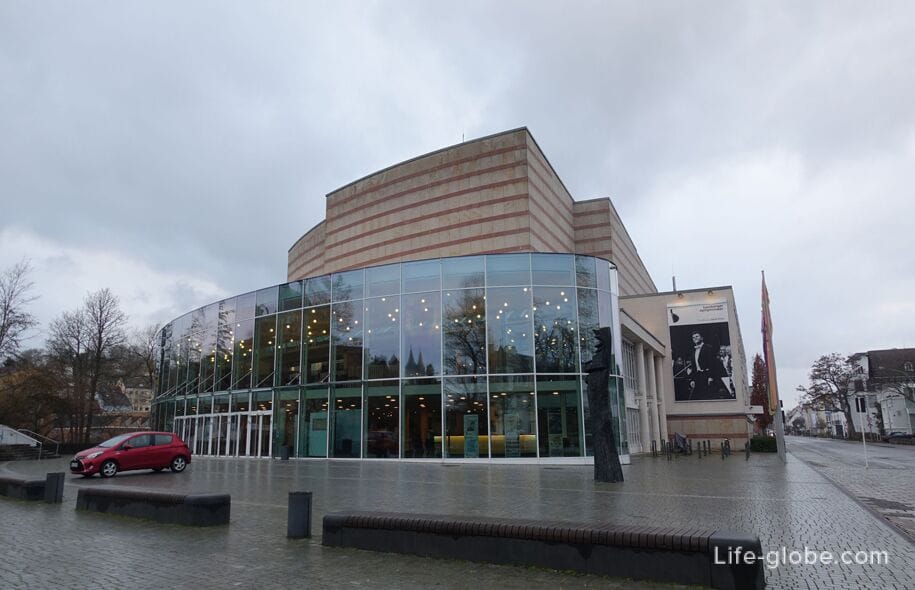
Next to the Concert Hall, near the waters of the Regnitz River, there is a small Lebensader Regnitz park with sculptures, including the famous "Anchor Figure 2002" (Ankerfigur 2002) by the Swiss artist Bernhard Luginbuhl, which is dedicated to civilization and the environment. The sculpture consists of discarded objects.

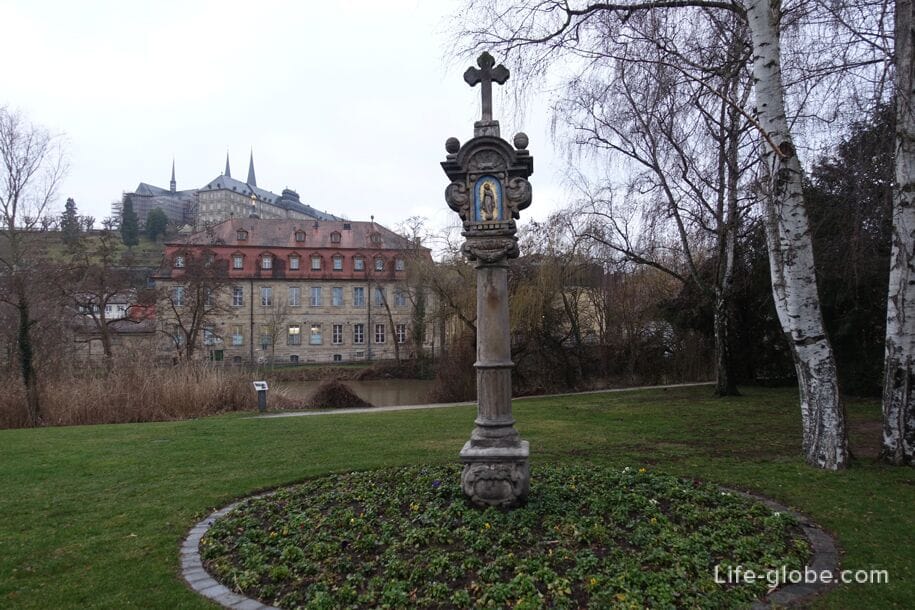

The Bamberg Sculpture Park (Sculpturenpark Bamberg / Skulpturenpark Bamberg) is also part of the sculptural part of Bamberg.
Here, on an area of more than 8000 square meters, there are more than 24 large sculptures from 5 working groups of the Bamberg master Bernd Wagenheuser. New sculptures are added or replaced alternately.
The address of the sculpture park: Mußstraße 5a, 96047 Bamberg.
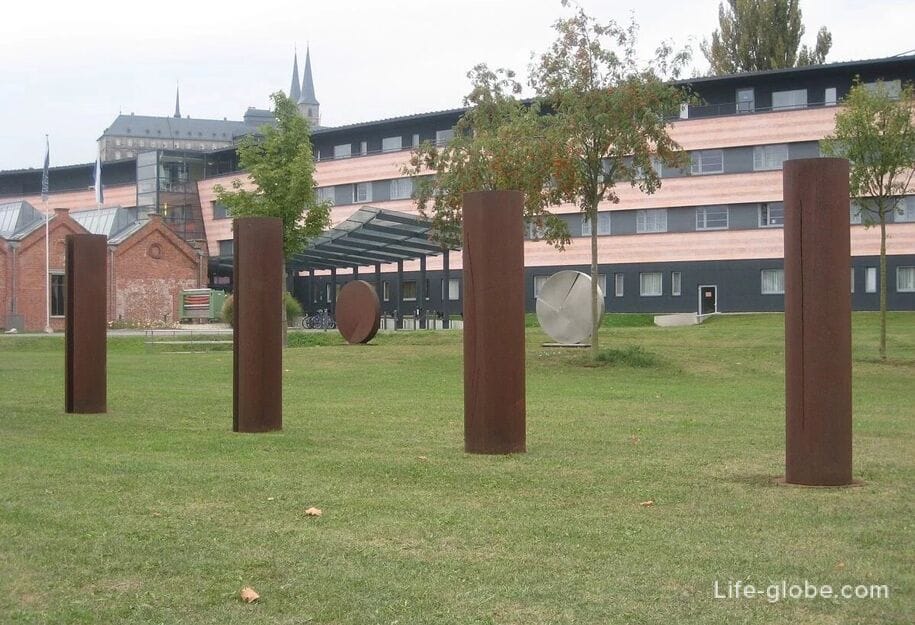
Also in Bamberg there are other sculptures by Bernd Wagenheuser, for example, modernThree-part art installation (Dreiteilige Kunst-Installation). Address: Hellerstraße 13, 96047 Bamberg.
In addition, an exhibition hall of the artist Bernd Wagenheuser has been opened in Bamberg, which is used as a place for contemporary art, where the artist's works are exhibited.
Hall address: Bernd Wagenhäuser, Gertrauden Straße 10 / Rückgebäude, 96050 Bamberg.
Website: atelier-wagenhaeuser.de.
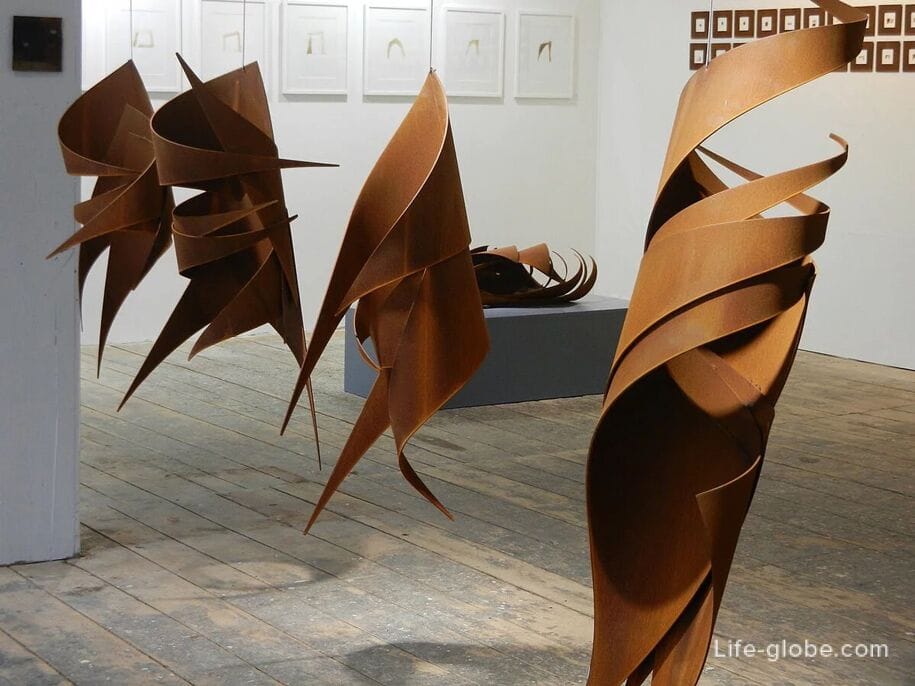
The Bettinger House (Böttingerhaus) is a beautiful former Baroque palace, which was built in 1707-1713 on the model of Italian palazzi by the wealthy court adviser Johan Ignaz Tobias Bettinger.
The palace was built on the surviving basements of two demolished medieval houses. Studies attribute the design of the facade and gardens of the palace to Maximilian von Welsch.
Today, this majestic building, which is considered the most important bourgeois German Baroque palace in Bamberg, has an ornate courtyard and a garden with terraces.
The walls of the building house an art gallery (Kunstgalerien Böttingerhaus) of old and modern art.
Of the previously valuable interior decorations in the representative halls of the upper floor , the molded ceilings of Ya have been preserved . Jacob Vogel with frescoes by Jacob Gebhard, which depict the deeds of Bettinger and his prince. Of particular importance is the street facade, made with a lush plastic decor.
The figures crowning the windows of the building - generals, officers and soldiers - recall the important role of Bettinger in the War of the Spanish Succession (1701-1714).
The address of the palace: Judenstraße 14, 96049 Bamberg.
Gallery website: kunstgalerie-boettingerhaus.

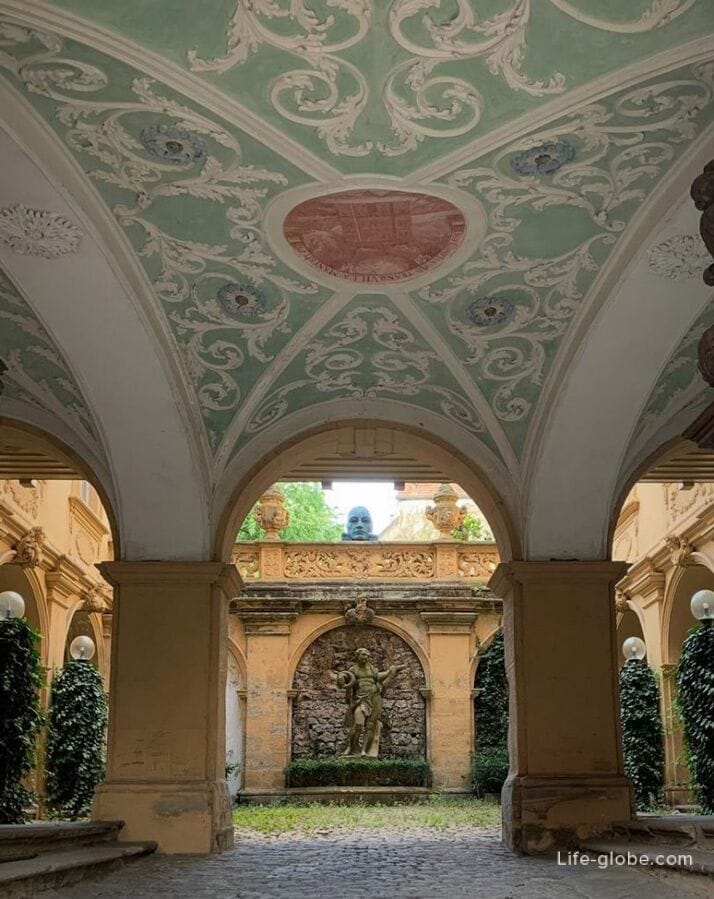
Pfahlplätzchen is a small colorful square in the old town of Bamberg, surrounded by historic buildings with restaurants with outdoor tables.
The center of the square is decorated with a sculpture.
Of the buildings around the perimeter of the square are notable: the "Crab House" (Haus zum Krebs) built in 1807-1808, the Christuskirche Marienkappelle Church and the art gallery (Keramik Katja Dennert).



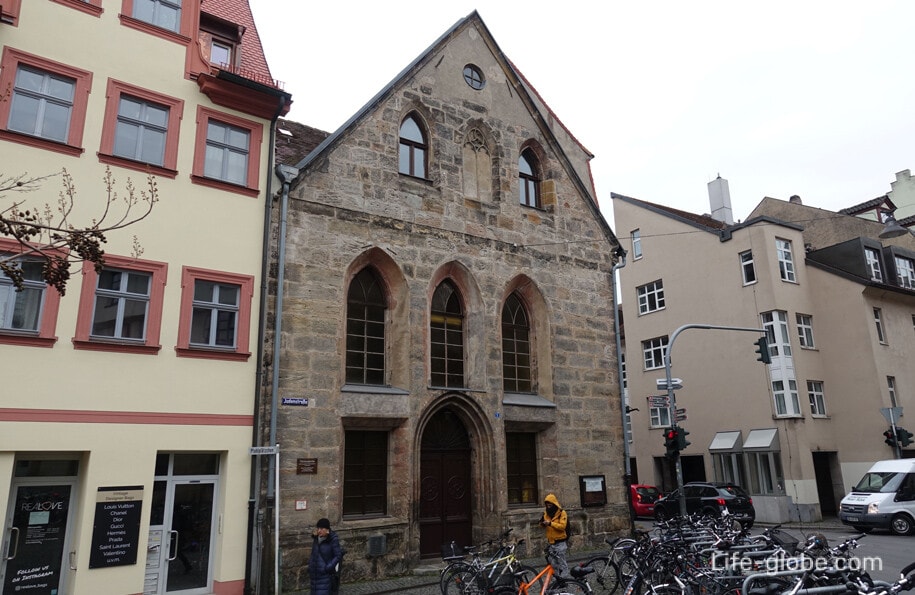
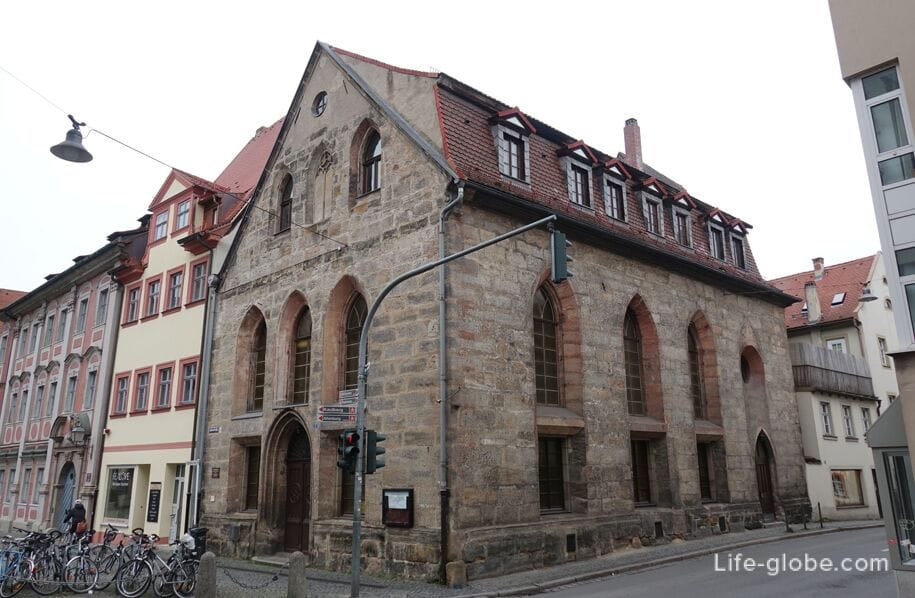
The Church of Our Lady or Upper Parish (Pfarrkirche Unsere Liebe Frau, Obere Pfarre) is a parish church, which is the only practically purely Gothic church in the city.
The popular name "Upper Parish" (Obere Pfarre) of the church was given because of its location on the Kaulberg hill, as an analogue of the Lower Parish - the former Gothic church of Alt St. Martin (Alt St. Martin) of the 14th and 15th centuries, which was located on Maximiliansplatz and was demolished during secularization in 1805.
The construction of the Church of Our Lady began in 1338.
Today, the Church of the Mother of God attracts attention with its size, architecture with portals and a bell tower, more than 60 meters high, the upper part of which forms the former home of the caretakers. More about the Church of Our Lady...
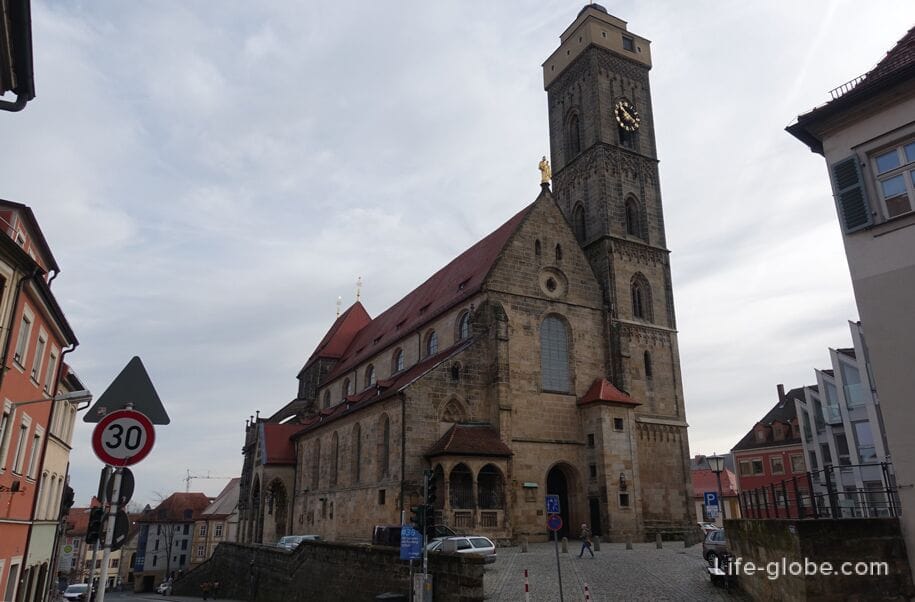

The Carmelite Monastery (Karmelitenkloster Bamberg) was founded as a complex in the 12th century and rebuilt in the Baroque style by Leonard Dinzenhofer in 1692-1701.
Behind the entrance facade of the Baroque monastery is a magnificent late Romanesque monastery of the 13th century.
The Carmelite Church of St. Mary and St. Theodore (Karmelitenkirche St. Maria und St. Theodor) is located at the monastery.
Address of the monastery: Karmelitenplatz 1, 96049 Bamberg.
Website: karmeliten.de.
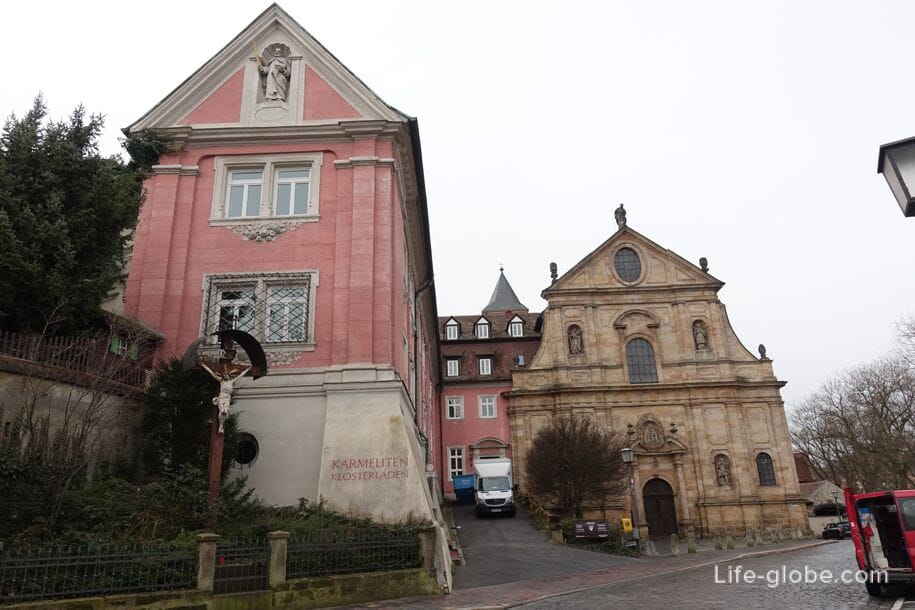
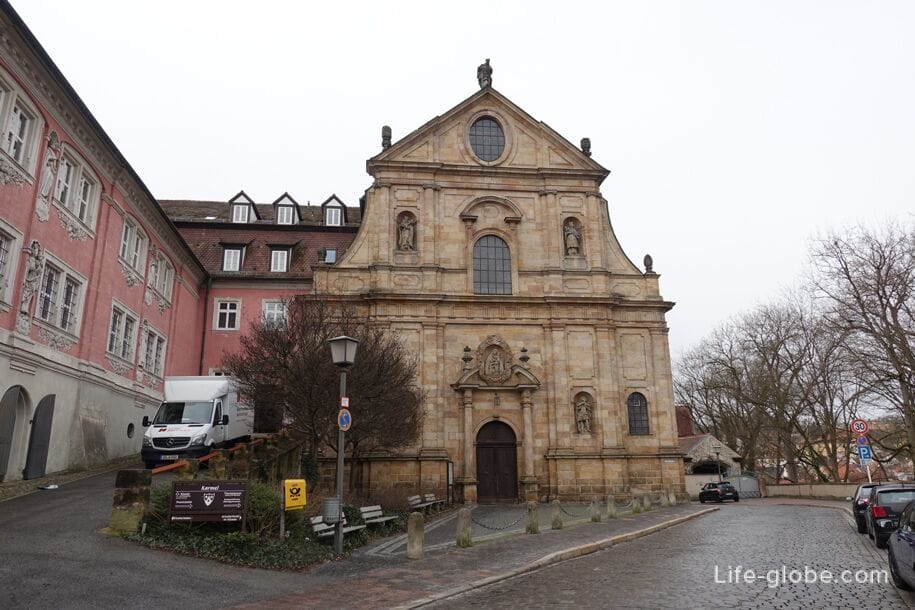


Bamberg is home to one of the oldest fully preserved Ways of the Cross of Jesus Christ in Germany (Der Bamberger Kreuzweg).
The Bamberg Via Dolorosa was created by Heinrich von Marschalk Rauenek, who made a pilgrimage to the Holy Land in 1503. In Bamberg, the distance between the points of the Sorrowful Way to Golgotha - the place of the crucifixion of Christ - corresponds to Jerusalem.
There are 6 points of the Way of the Cross in Bamberg, which are marked with reliefs. The well-preserved and extremely expressive sandstone images are an impressive interpretation of the faith and part of the city's attractions. The path ends at the Church of St. Getreu (Kirche St. Getreu) on Michelsberg (Michelsberg), which depicts the crucifixion and burial of Christ.
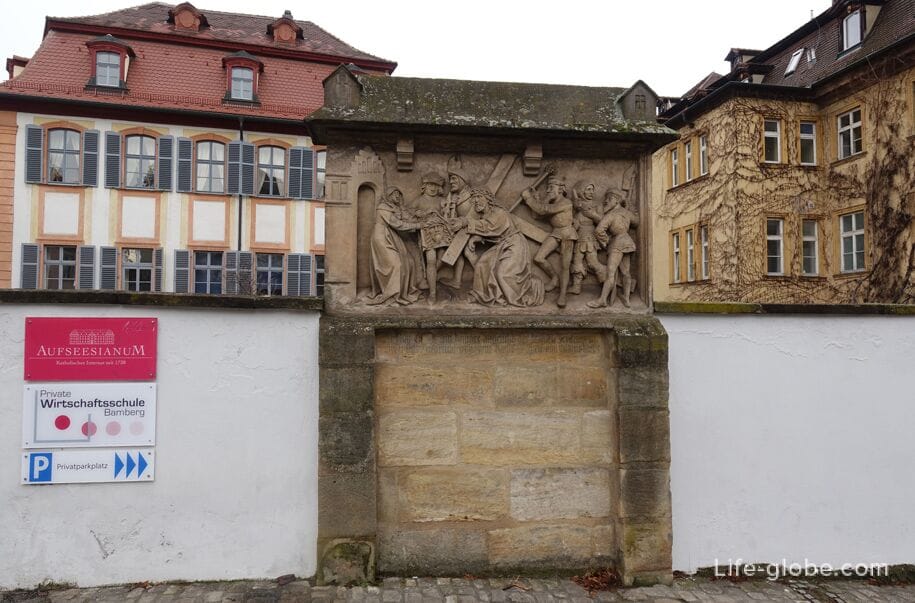
The Church of St. Getreu or Getre (Kirche St. Getreu), where the Bamberg Way of the Cross ends, was founded in 1124.
Today's Baroque church was built between 1652 and 1732 by Justus Heinrich Dinzenhofer and today is one of the most important Baroque religious buildings in Bavaria.
The church has an organ, ceiling paintings from about 1760, the main altar from 1733 with the late Gothic Virgin Mary of the 15th century.
Church address: Sankt-Getreu-Straße, 96049 Bamberg.
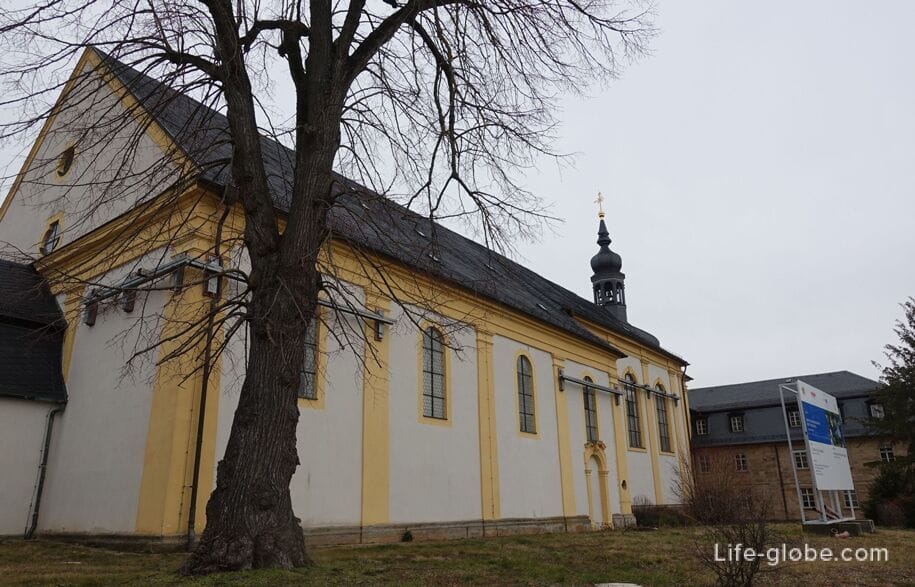
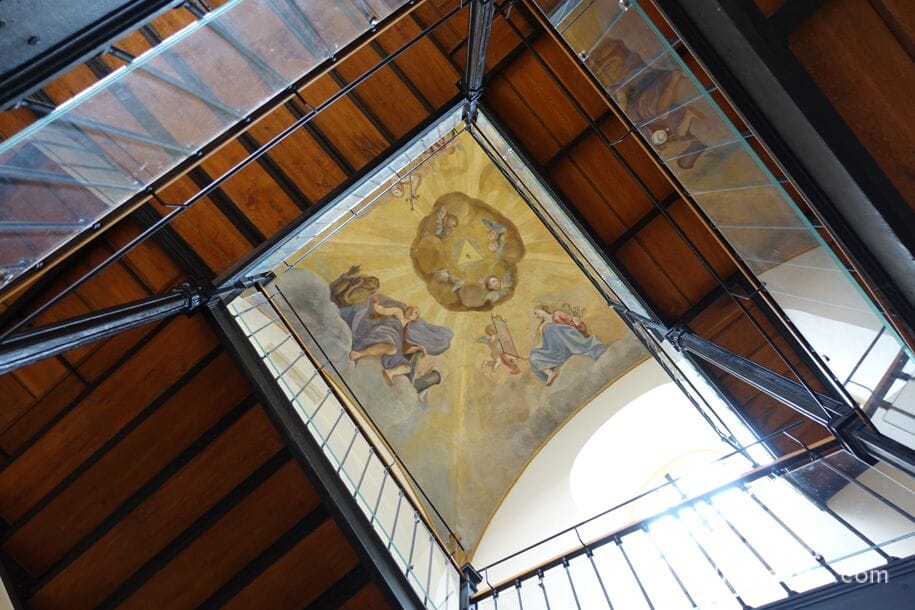
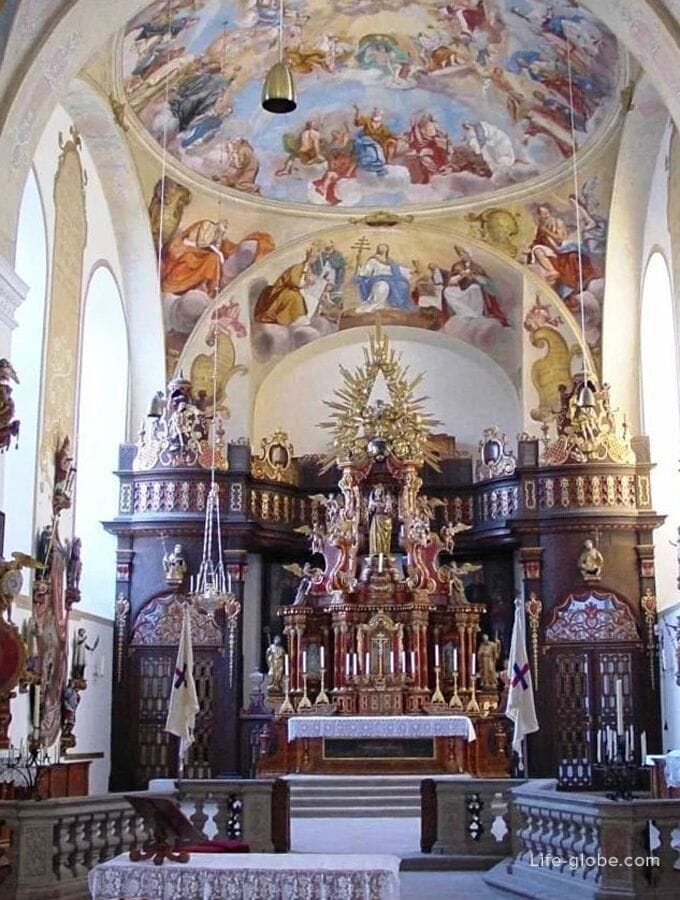
The Church of St. Jacob or Jacob (St. Jakob) is one of the largest churches in Bamberg.
Despite the Baroque facade, St. Jacob's Church is the only almost entirely Romanesque church in Bamberg.
In the 11th and 12th centuries, when the church was built, it was located outside the fortifications of the city, on the road along which numerous pilgrims were heading to Santiago de Compostela.
In 1771, the Baroque facade of the church was created, behind which numerous elements of the Romanesque period can still be found. There are also elements of Romanesque style inside.
Church address: Jakobsplatz, 96049 Bamberg.

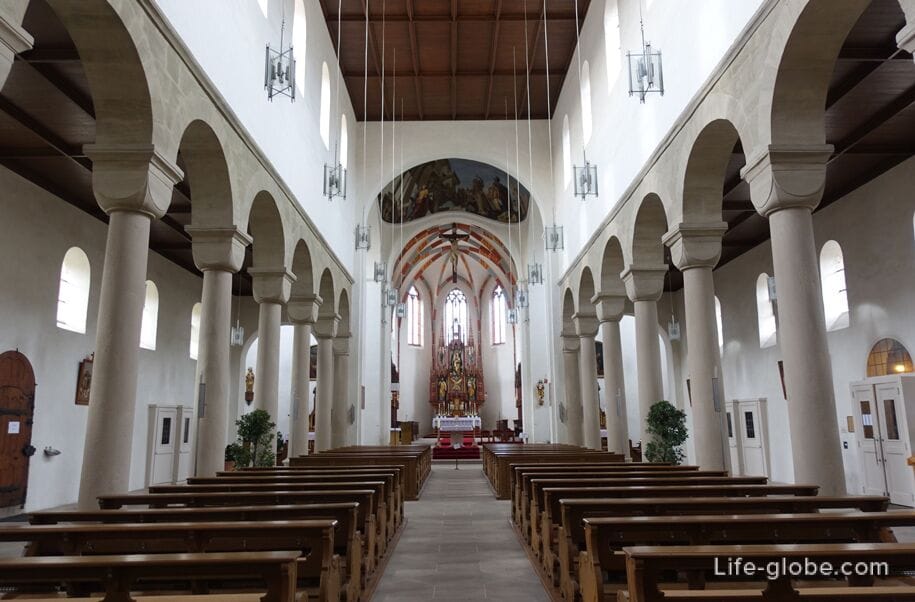
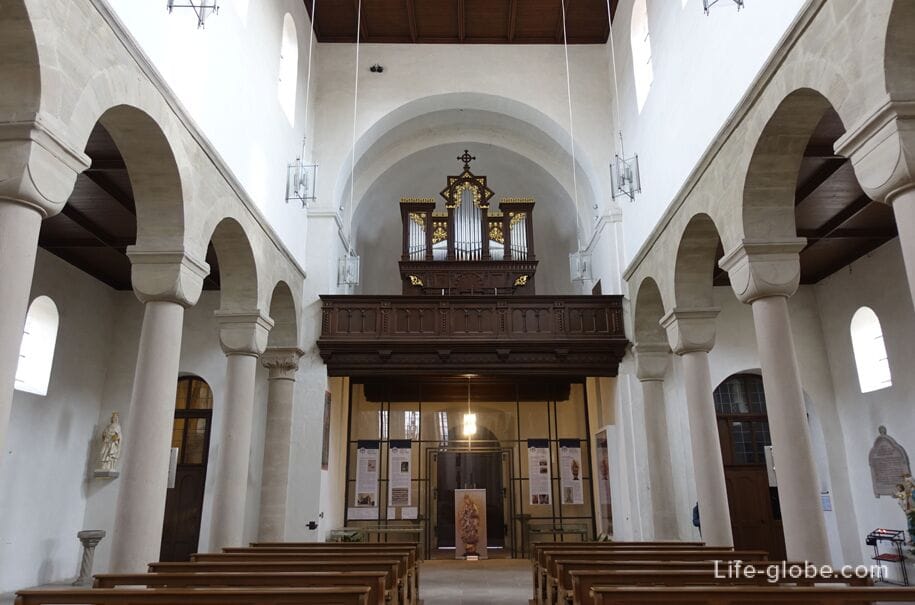
The Church of St. Elizabeth or Elizabeth (St. Elisabeth) as a hospital church was consecrated on August 24, 1354.
The choir of the church, which has survived to this day, was built around 1400, the current nave was built around 1493. After secularization in 1803, the church served as a prison and workhouse. The church was rededicated in 1883.
The church has the oldest fully preserved bas-relief of the Bamberg Way of the Cross, which begins at this church.
On the pedestal, near the church, there is a sculpture "Apollo" by Marcus Lupertz.
The church is decorated with 8 stained glass windows with motifs from the life of St. Elizabeth in combination with seven works of mercy from the Bible.
Church address: Ob. Sandstraße 29, 96049 Bamberg.
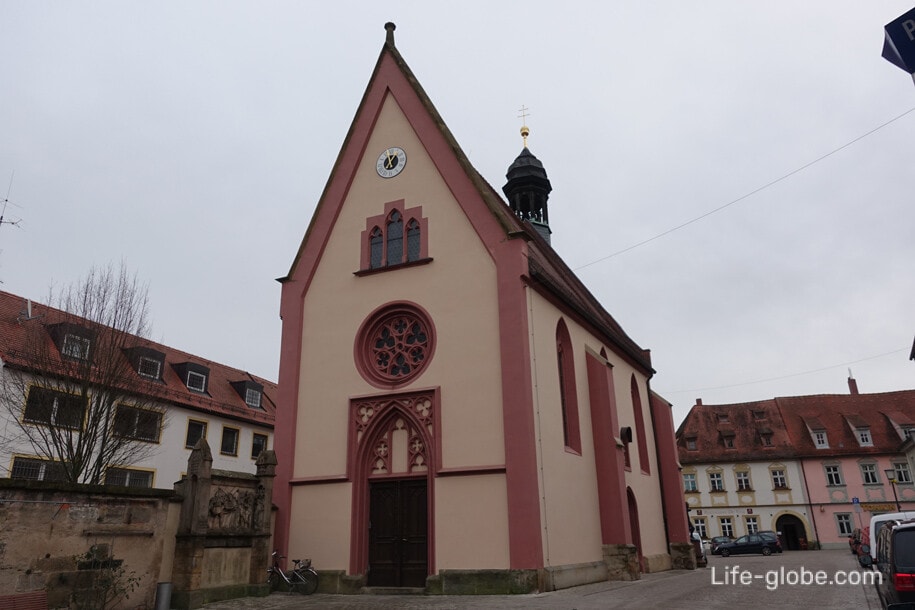
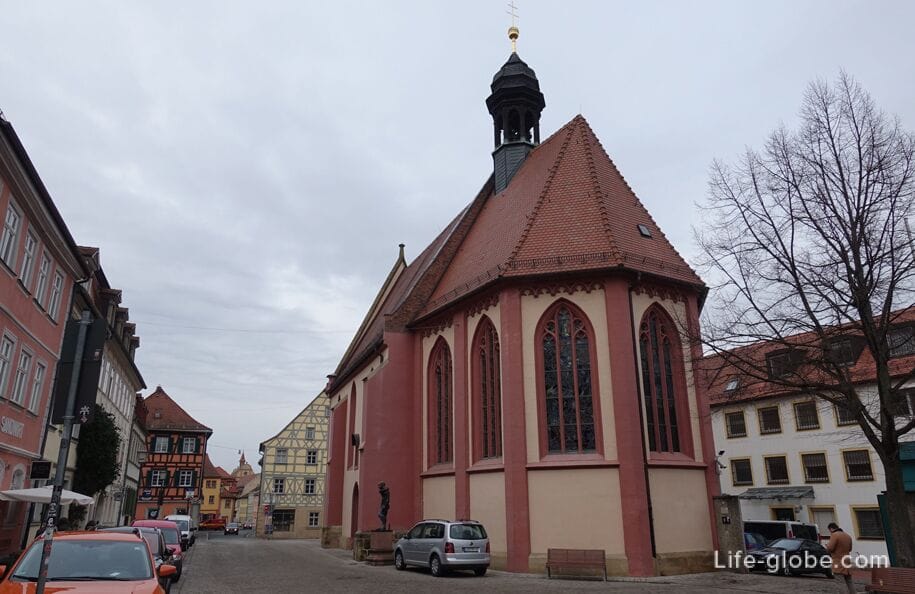
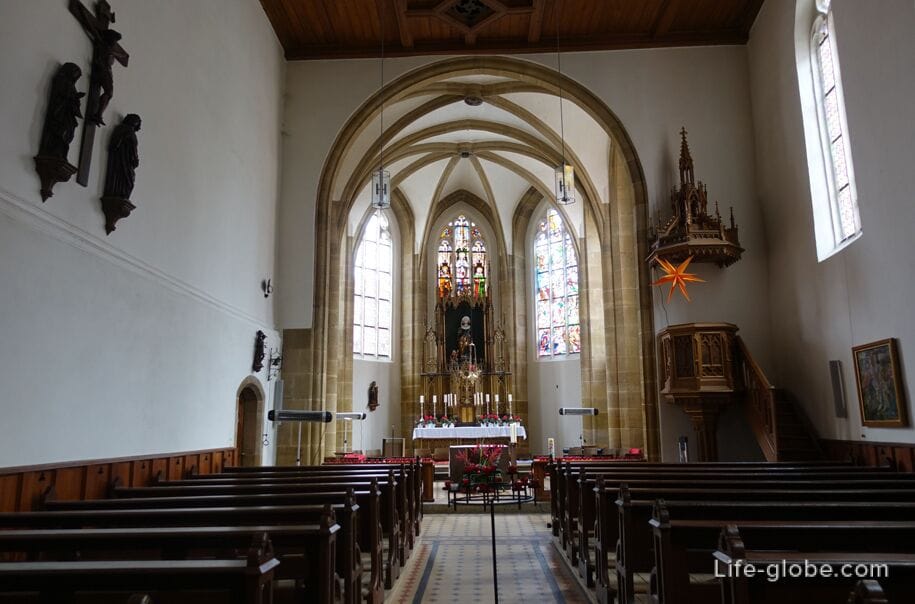
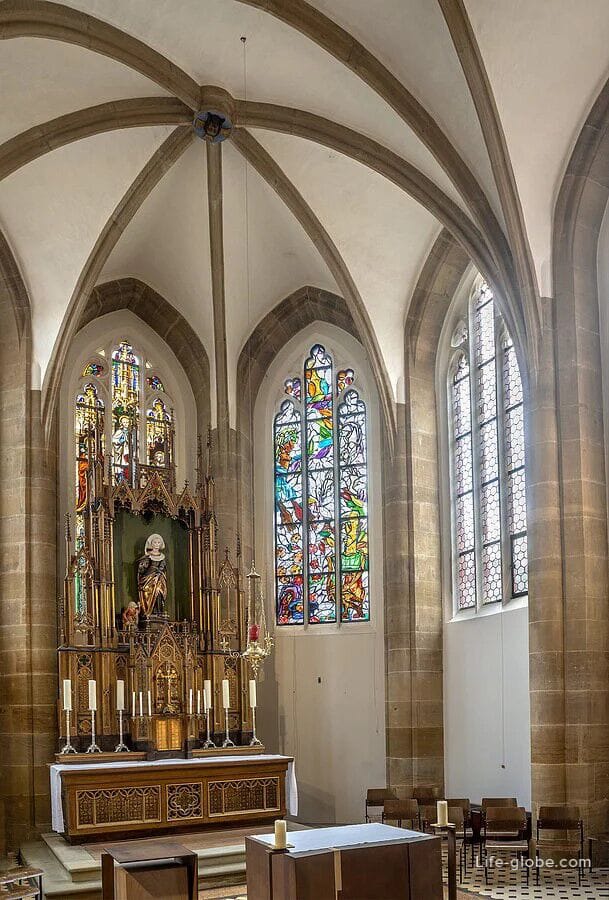
The Church of St. Stephen (St. Stephan) rises on the easternmost of the seven hills of Bamberg. It is the main evangelical church of Bamberg since 1807.
The original building, which was probably donated by Empress Kunigunde, was built at the same time as the Bamberg Cathedral, and was consecrated in 1020 by Pope Benedict VIII.
In the 17th century, according to the plan of the Greek cross, today's St. Stephen's Church was built in two stages of construction. The choir room, built by Giovanni Bonalino in 1628-1629, has elements of the Neo-Gothic Baroque style. The other three naves of the shrine, for which Antonio Petrini was responsible, are built in the Baroque style, but strongly based on the Renaissance. The works of art inside the church cover an arc of styles from the Baroque to the present day.
Church address: Stephansplatz 4, 96049 Bamberg.
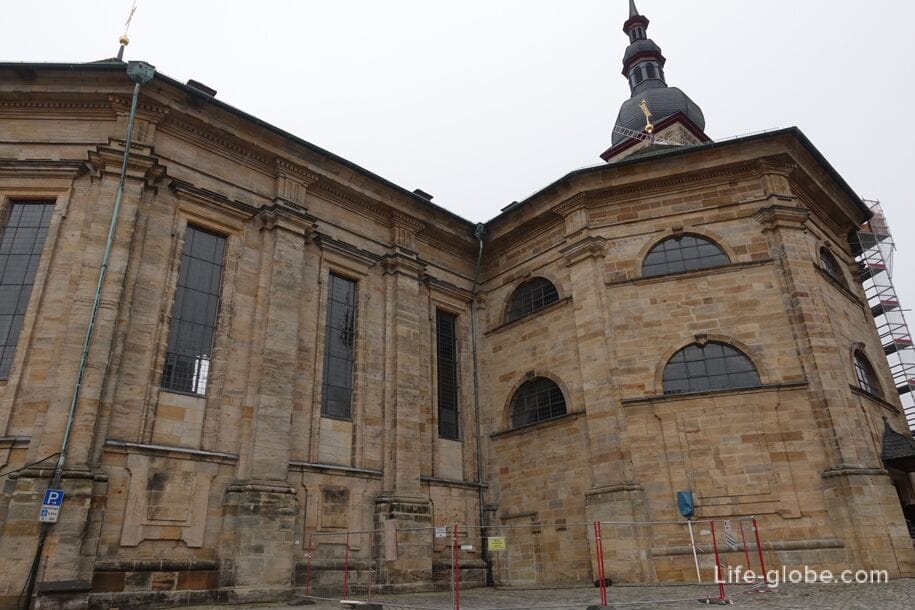

The House with the Golden Coat of Arms (Haus zur Goldenen Wappe) is the former Court of the Canons of St. Stephen "Curia ad salices", built in 1618-1622 as a retirement institution for the servants of the Bamberg High Abbey.
In 1622 Guda became a monastic curia again, and since 1818 it has been privately owned.
The building stands out with a large golden coat of arms on the main facade, placed above the entrance portal.

The old Ebracher Hof (Alter Ebracher Hof) is an architectural monument in Bamberg and was the first city palace-house of the Ebrach monastery of the 17th century.
The house has three main floors, a stepped magnificent pediment with a three-dimensional coat of arms and decorations in the form of sculptural groups.
House address: Vorderer Bach 5, 96049 Bamberg.
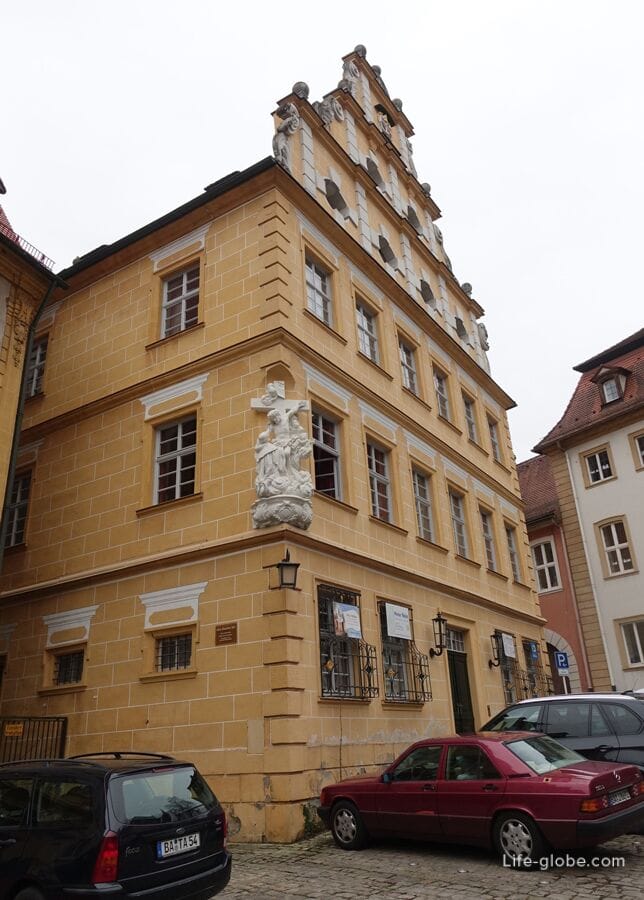
The Matern Chapel (Maternkapelle) is a small chapel in Bamberg, in which nativity scenes (cots) are exhibited during the Advent period (pre-Christmas period).
This small chapel is named after Matern, the first bishop of Cologne in the 4th century. In the 11th - 12th centuries the chapel was a hospital; in 1157 it belonged to the convent of St. Theodora, and in the 14th and 15th centuries it was rebuilt. In 1802 it fell under secularization and since then it has been owned by the association "Krippenfreunde Bamberg".
In the architecture of the chapel, a slender pointed bell tower catches the eye.
Chapel address: Maternstraße 10, 96052 Bamberg.

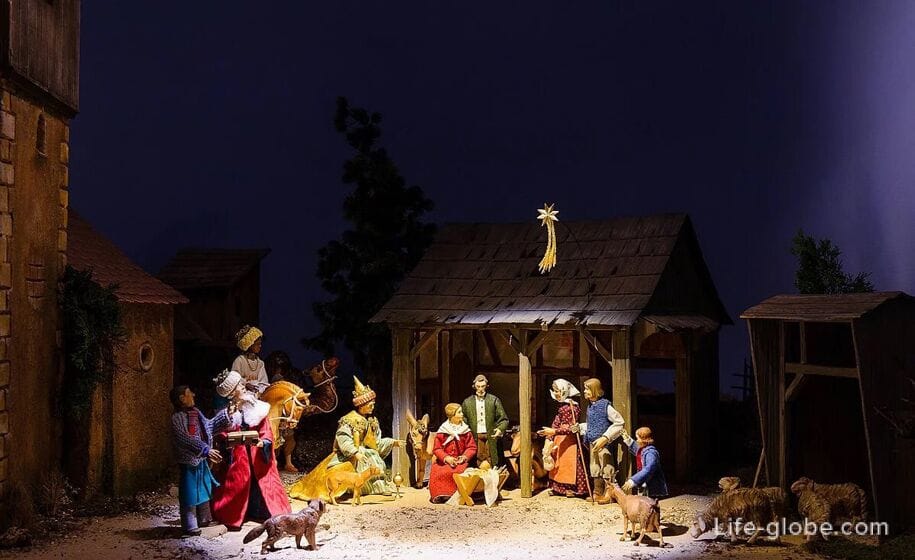
In the old town of Bamberg, in the part that is located on the left side of the Regnitz River, on the side of the Bamberg Cathedral, there are narrow cobbled streets with dense rows of beautiful historical buildings, which today house, among others, shops, cafes, restaurants, pubs and hotels

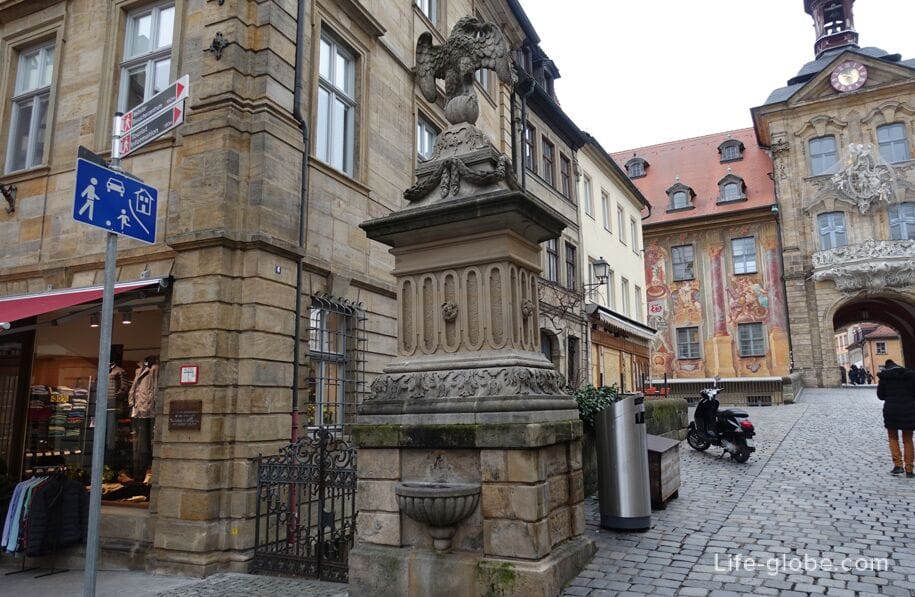


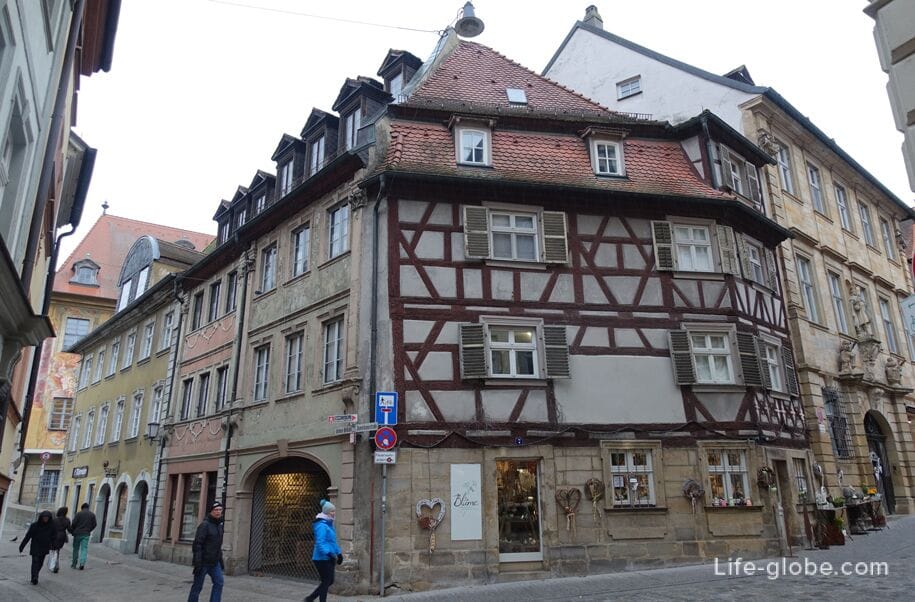
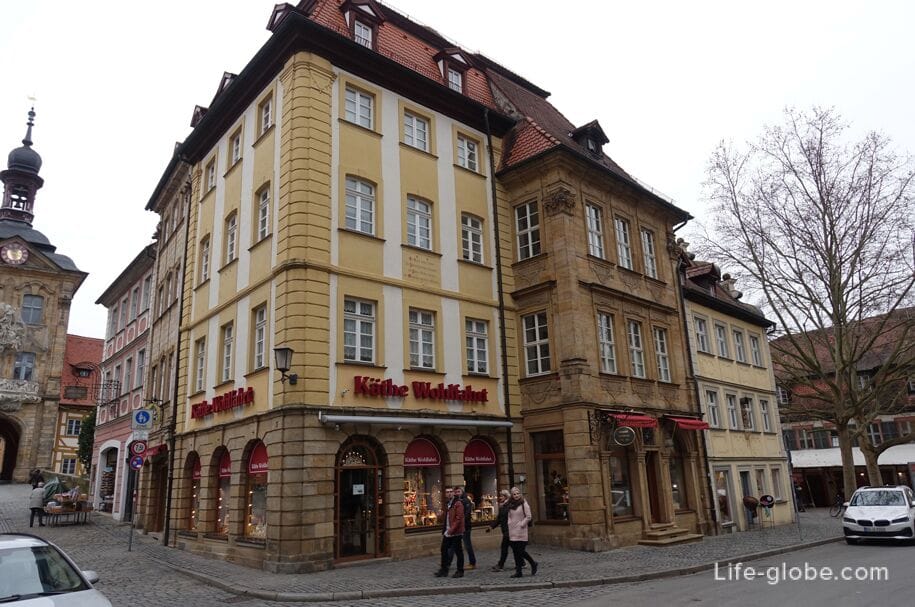




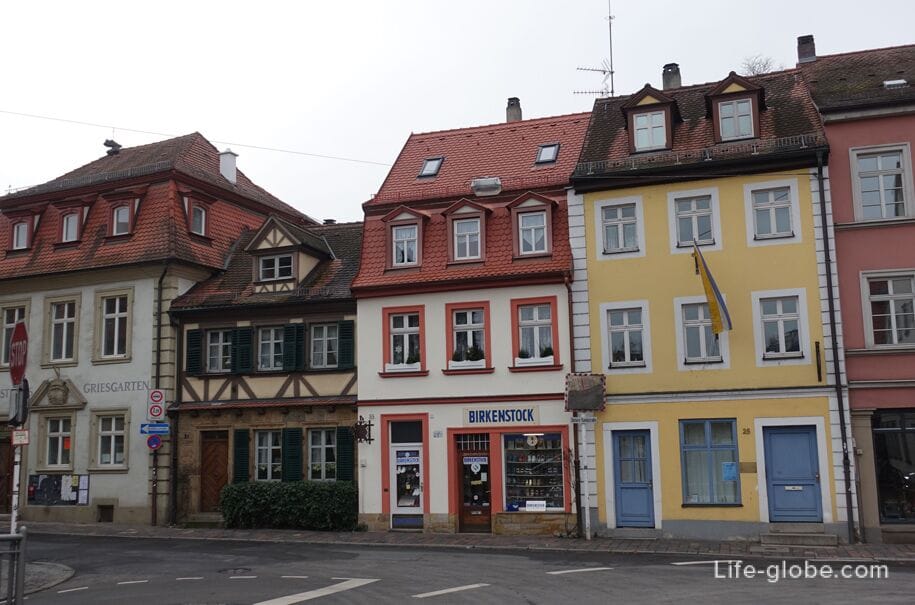

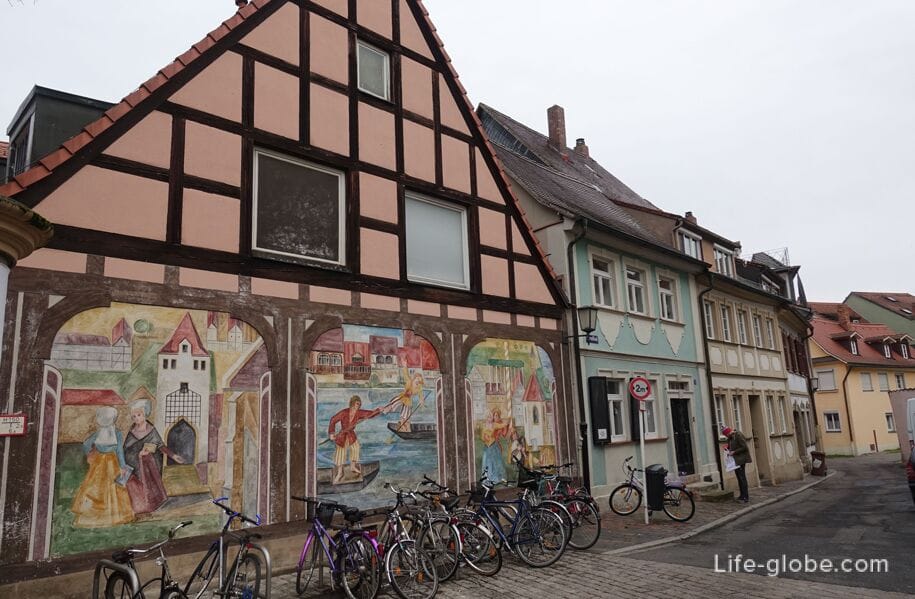


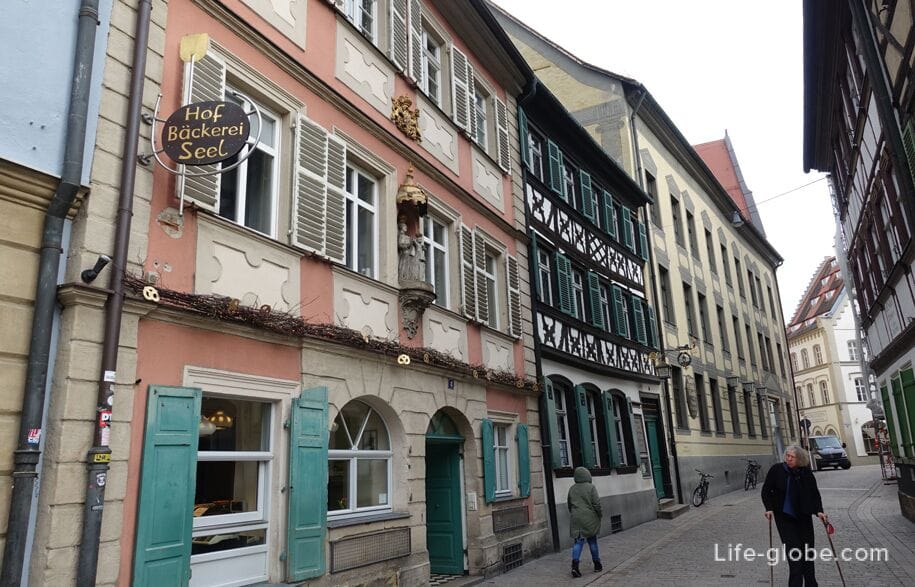

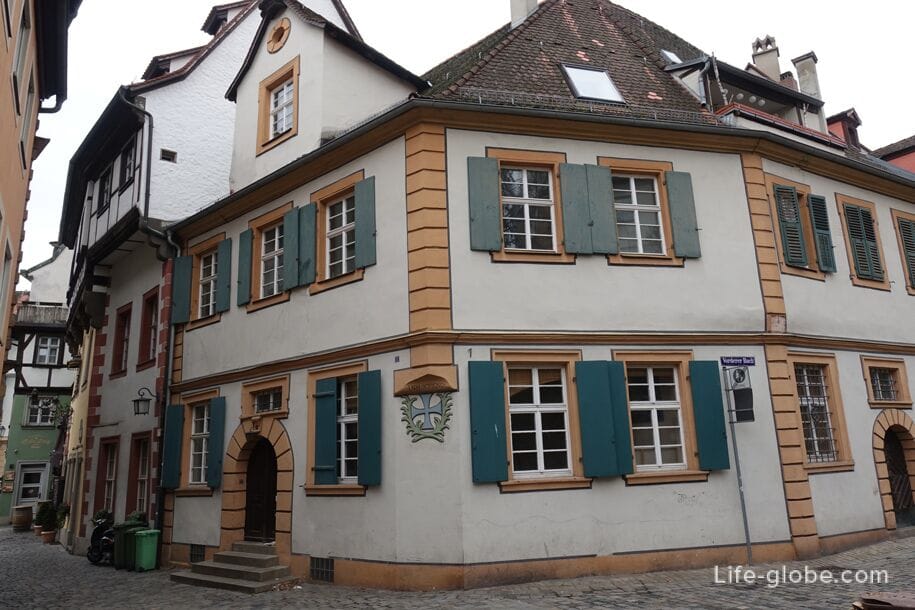
The House of St. Benedict (Haus St. Benedikt) is a historic townhouse in the old town of Bamberg.
The house on this site was first mentioned in 1321. The foundation of the vaulted brick cellar, which is used for temporary exhibitions and performances, is the remains of a medieval structure.
The current building was rebuilt by the clerk of the city court Johann Merzell in 1584 after a fire destroyed the old structure. The ancestral coats of arms on the stone slabs, which were originally located outside, are now represented on the stairwell on the first floor of the building. At the beginning of the 18th century, the building was the home of the court and chamber councilor Fortenbach and his family.
The Baroque interior of the house dates back to the time when many buildings in Bamberg were decorated with the addition of Baroque elements outside or inside. Among them are wall and ceiling frescoes, as well as stucco decorations. The stucco ceiling was created by Johann Jakob Vogel, who was the first permanent master of modeling for the Bamberg prince-bishops.
The facade of the building in its current form was formed in 1866, when the Baroque elements were removed.
In 1992, Manfred Bumiller bought this architectural gem, which he carefully restored until 1995.
Today, the building houses, among other things, the Museum of early Islamic Art of the Bumiller Collection.
Building address: Austraße 29, Bamberg BY 96047.
The museum's website: the-bumiller-collection.com/museum/.
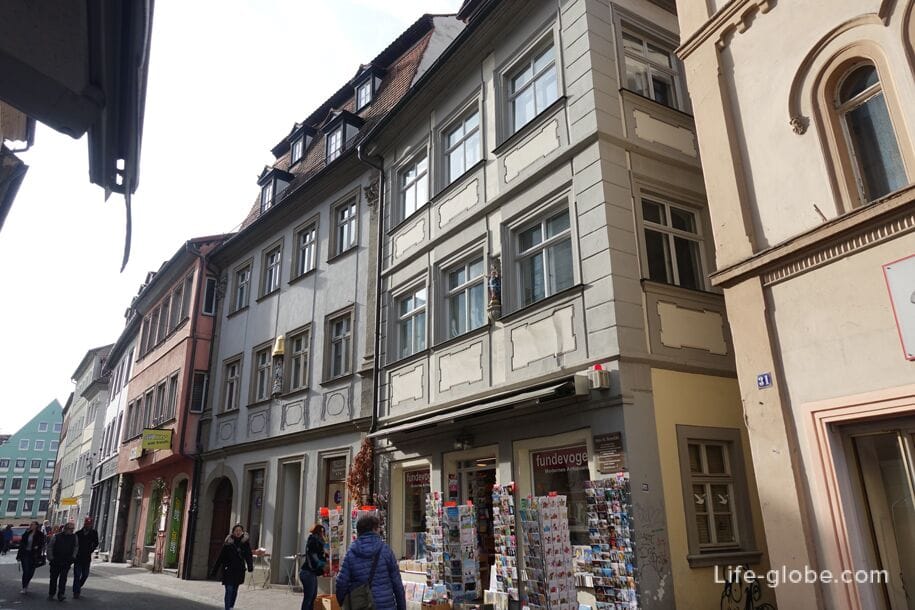
E.T.A. Hoffman was a composer, artist and poet. He came to Bamberg in 1808 to work as a musical director at the local theater - the current ETA Hoffmann Theater (E.T.A.-Hoffmann-Theater).
Not far from the theater is the former home of E.T.A. Hoffmann (E.T.A.-Hoffmann-Haus), where he lived with his wife from 1809 to 1813. Today the house can be visited as a museum. Hoffman's apartment is decorated as a memorial. The museum presents Hoffmann as a multifaceted artist and connects Hoffmann's years in Bamberg with his work.
Theater address: E.T.A.-Hoffmann-Platz 1, 96047 Bamberg. Website: theater.bamberg.de.
Address of the house-museum: Schillerplatz 26, 96047 Bamberg.
Hoffmann Theater
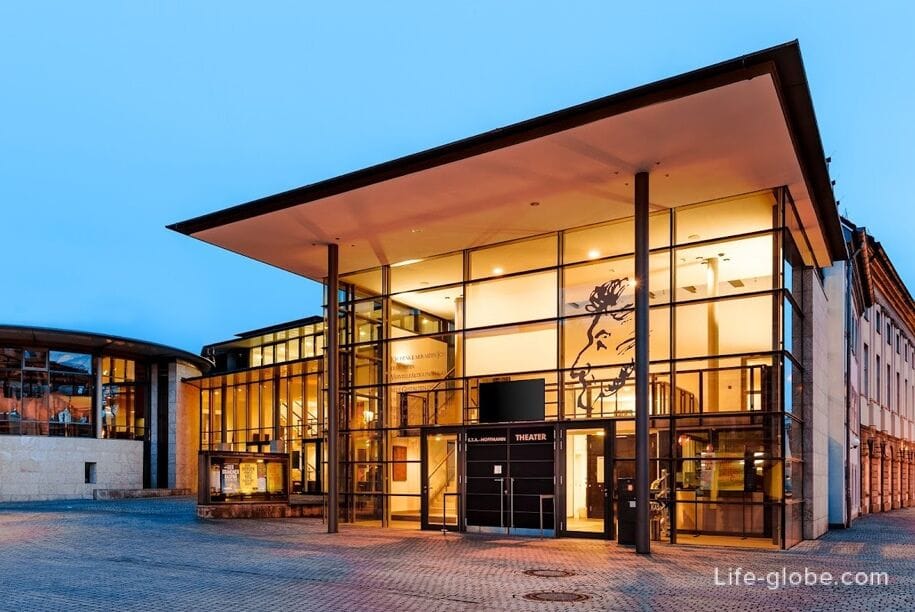
Hoffmann monument near the theater
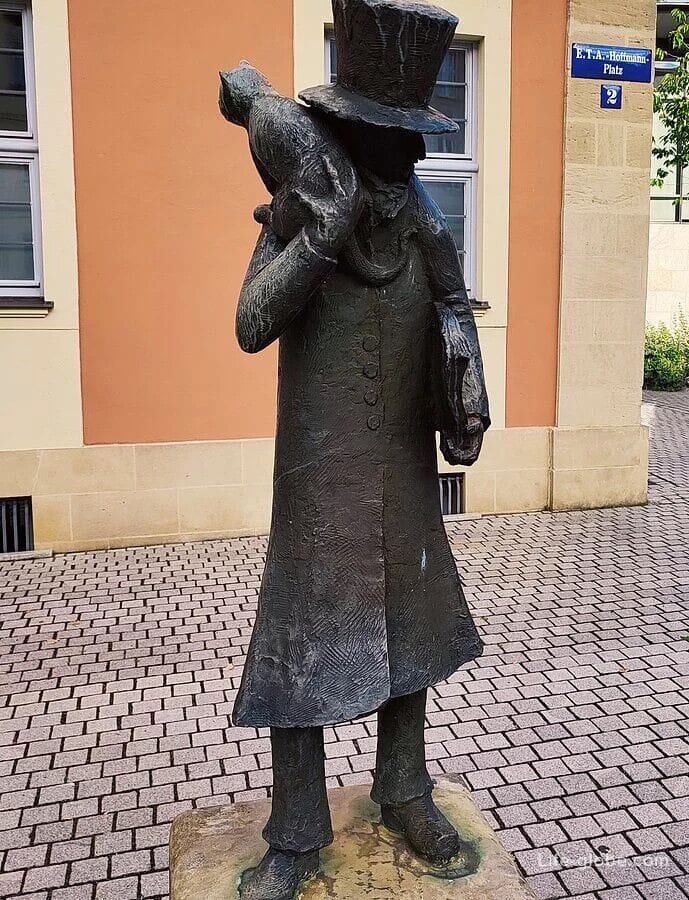
Hoffmann House Museum
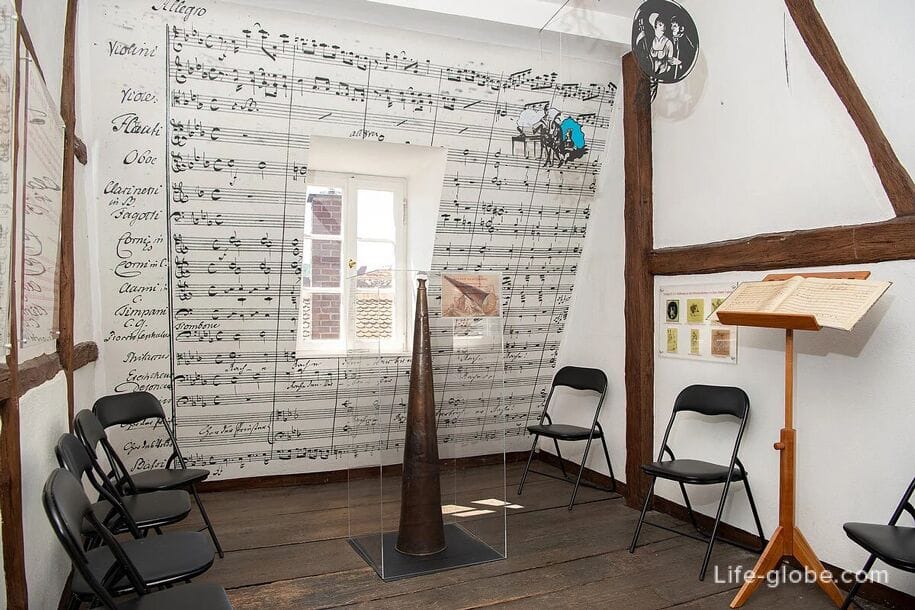
The representative villa (Villa Dessauer) of the Jewish hop merchant Dessauer was built in 1884 in front of the city gate in the grove area.
Today, the building houses the Stadtgalerie Bamberg, which hosts special exhibitions, mainly of contemporary art, as well as lectures and musical events organized by the museums of the city of Bamberg.
The address of the villa-gallery: Hainstraße 4, 96047 Bamberg.
Gallery website: villa-dessauer.
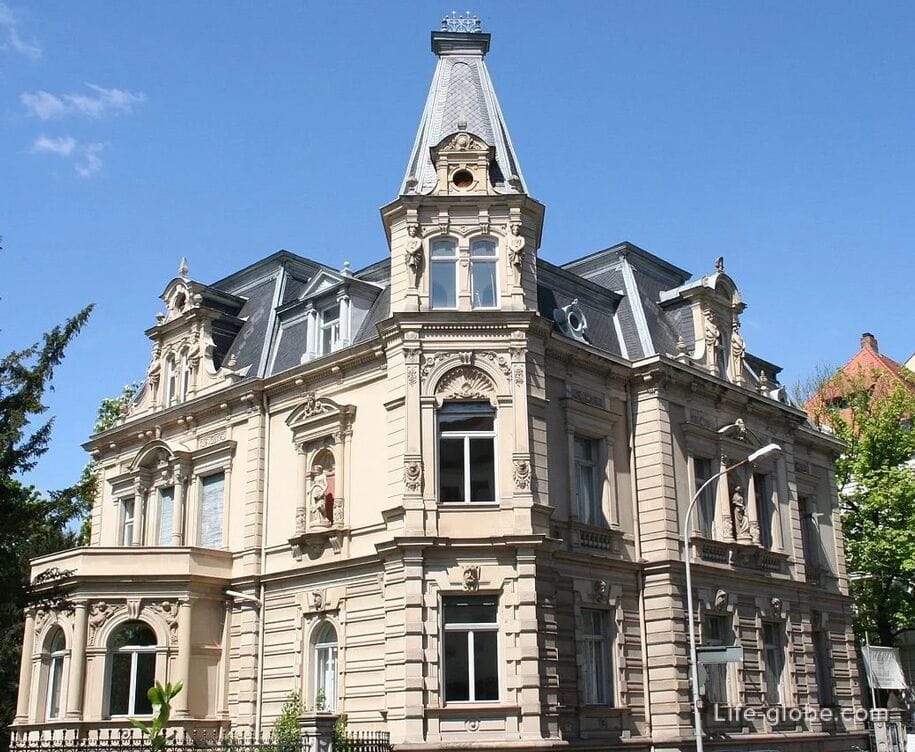
The Hauptwache is a historic two-storey sandstone building in the Baroque style with a mansard roof and an arched first floor.
The building was built between 1772 and 1774 for the military on behalf of Prince Bishop Adam Friedrich von Seinsheim. The construction was carried out by Johann Josef Vogel, designed by architect Johann Georg von Roppel. The military attributes and reliefs of the coat of arms on the building were created by the sculptor Johann Bernhard Kamm.
Building address: Hauptwachstraße 16, 96047 Bamberg.

The Institutskirche was built by Johann Friedrich Rosenzweig from 1724 to 1727.
A single-nave Baroque building with a cleaned choir is integrated into the complex of buildings of the educational institution in three floors.
The slender low ridge tower of the church with two bells outside indicates the place of worship. There is a crypt under the church, which is closed to the public.
The interior of the church was formed by the end of the 18th century. The main altar depicts the coronation of Mary, on the left and right there are statues of saints the Imperial couple Kunigunde and Heinrich. In the left side altar there is an image of the Seven Sanctuaries and a statue of Mary's Helper. The right side chapel is decorated with a guardian angel and a figure of Joseph. On the right side wall you can see a large cross (circa 1500) from the old church of St. Martin. At the back of the church, in a niche, there is a statue of the "Captive Savior".
Church address: Holzmarkt 2, 96047 Bamberg.
Website: institutskirche-bamberg.de.


St. Otto's Church is one of the few Art Nouveau churches in Germany. The church was the first church of the 20th century listed as a historical monument.
At the end of the 19th century, the St. Gangolf church became too small, so a new church had to be built in the north of Bamberg. Construction work on the project of architect Otto Orlando Kurtz and his partner Eduard Herbert began in 1912. The construction was completed by the end of 1913. On April 23, 1914, the bells were consecrated.
Church address: Siechenstraße 72, 96052 Bamberg.
Website: st-otto-bamberg.de/index.html.




St. Gangolf Church is the oldest church in Bamberg, combining various stylistic elements.
The parish church, a former monastery of canons, was built in Romanesque style in the 12th century under Bishop Otto the Saint and acquired the Gothic style around 1400.
Later, the shrine was furnished in the Baroque style, so today the Romanesque style of the main nave, the Gothic style of the choir, the Rococo altars and the newly created folk altar are combined into an ensemble covering the entire era of the church's existence.
Church address: Theuerstadt 4, 96050 Bamberg.
Website: st-gangolf.de.
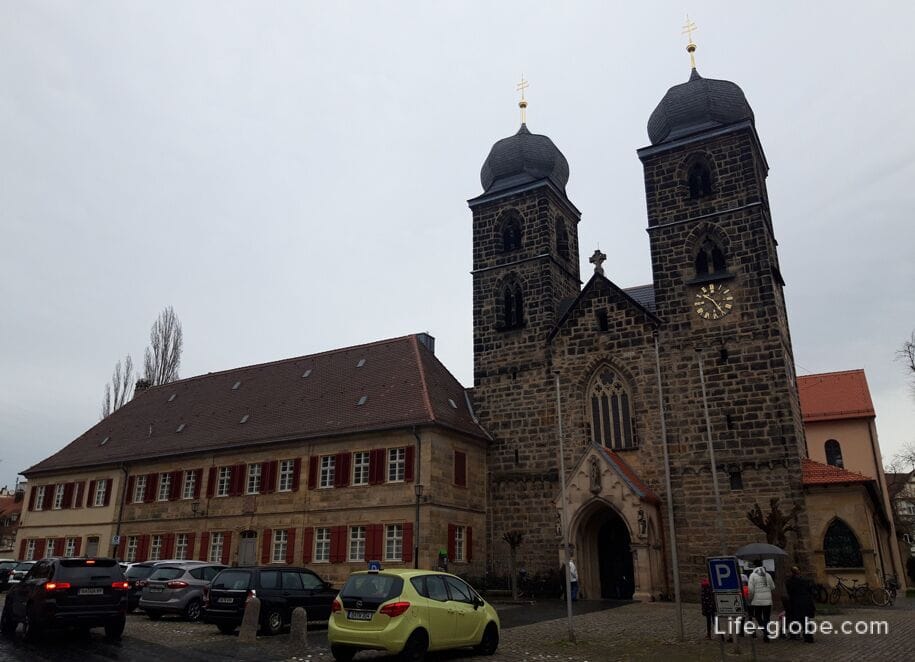
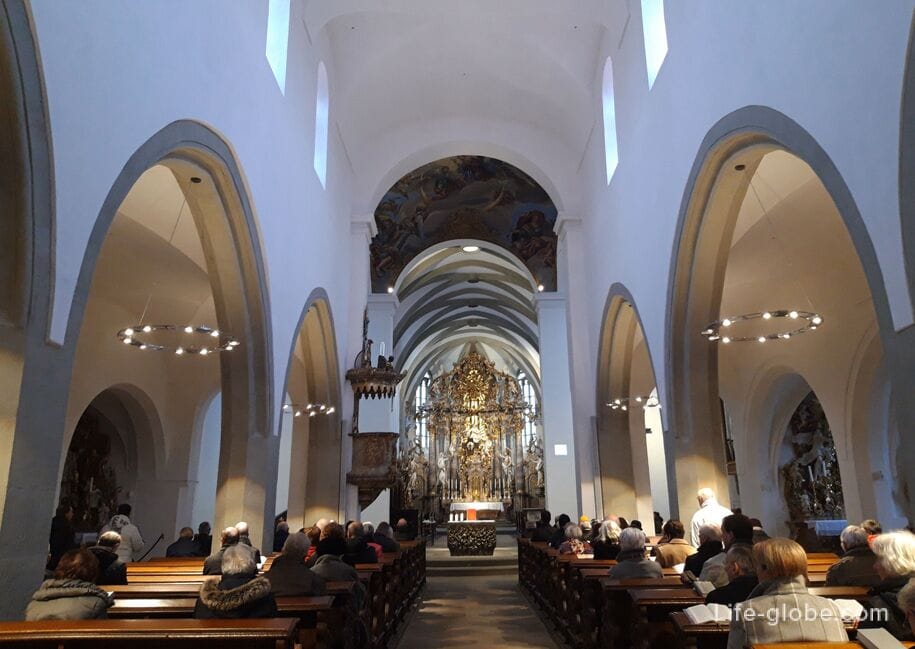
For more than 600 years, commercial gardeners of Bamberg, with their typical houses and long narrow homesteads, have cultivated plots, some of which are still cultivated and are part of the UNESCO World Heritage Site.
The pearl in the center of this part of the "old horticultural city" is the Gardeners' Museum (Gärtner- und Häckermuseum), which is a museum in the house of an 18th-century gardener with homely rooms, workrooms and a garden, which gives an idea of the habitat of a wealthy family of gardeners around 1900.
Museum address: Mittelstraße 34, 96052 Bamberg.
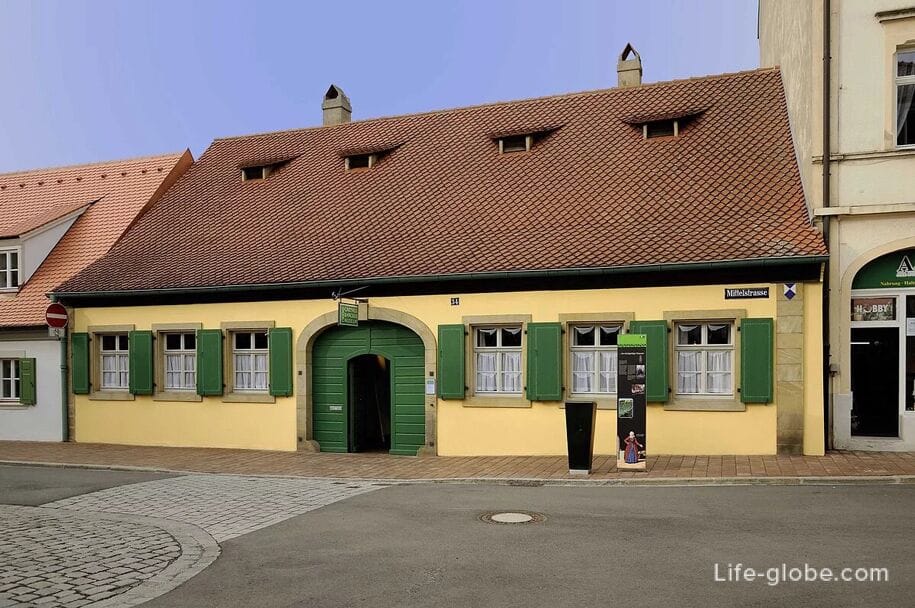
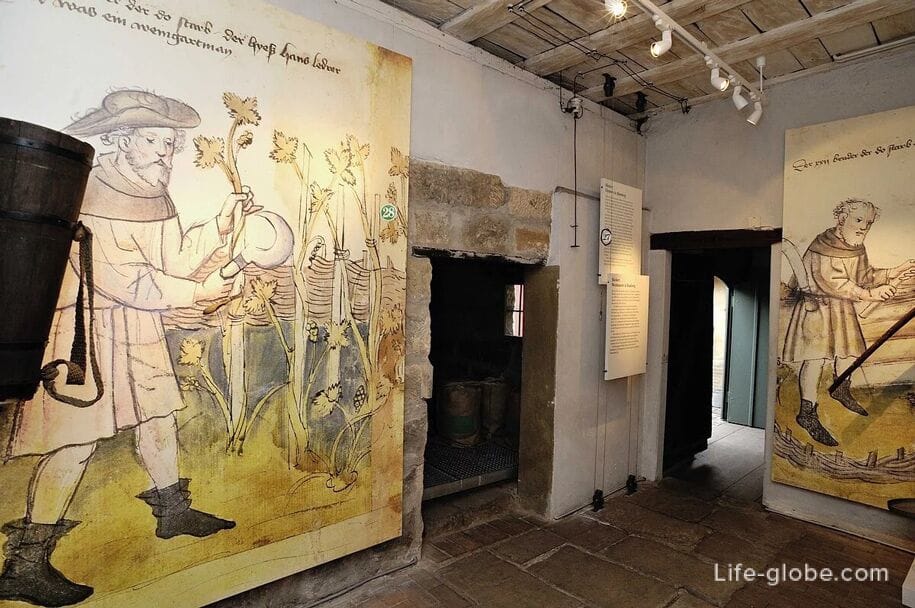
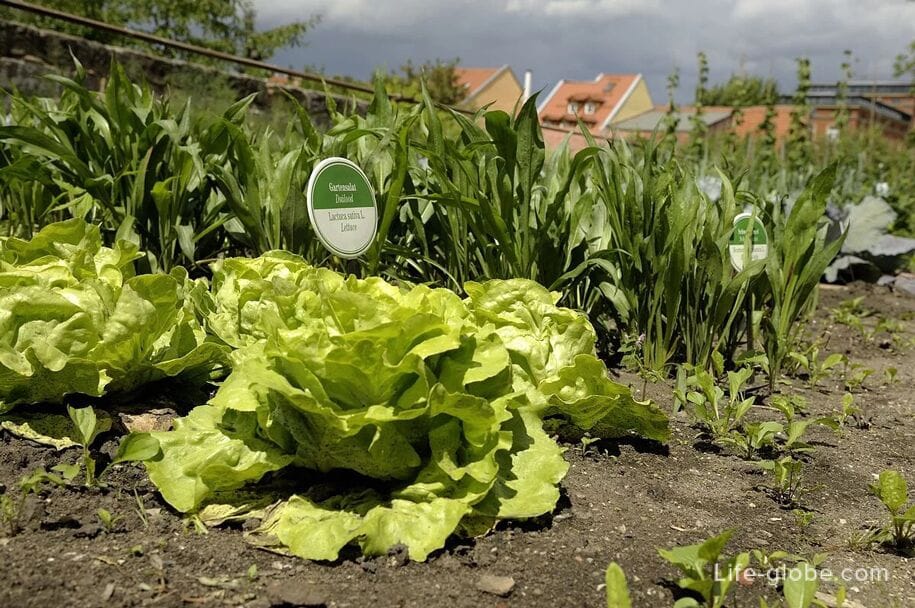
The observation deck "Leaning Tower" (Aussichtsturm "Schiefer Turm") is a low tower with two flights of stairs, which gives an overview of the "gardeners' quarter", spread out in the center of Bamberg.
Tower address: Heiliggrabstraße 57, 96052 Bamberg.
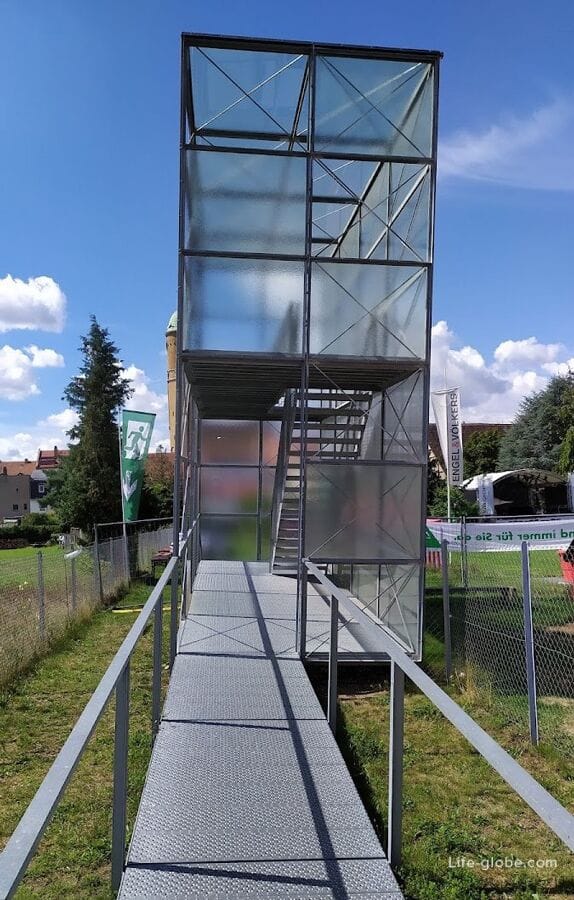
Two small Catholic chapels are notable on Siechenstraße: the chapel of Genninger or Maria (Gönningerkapelle) and the Chapel of Sebastiani (Sebastianikapelle).
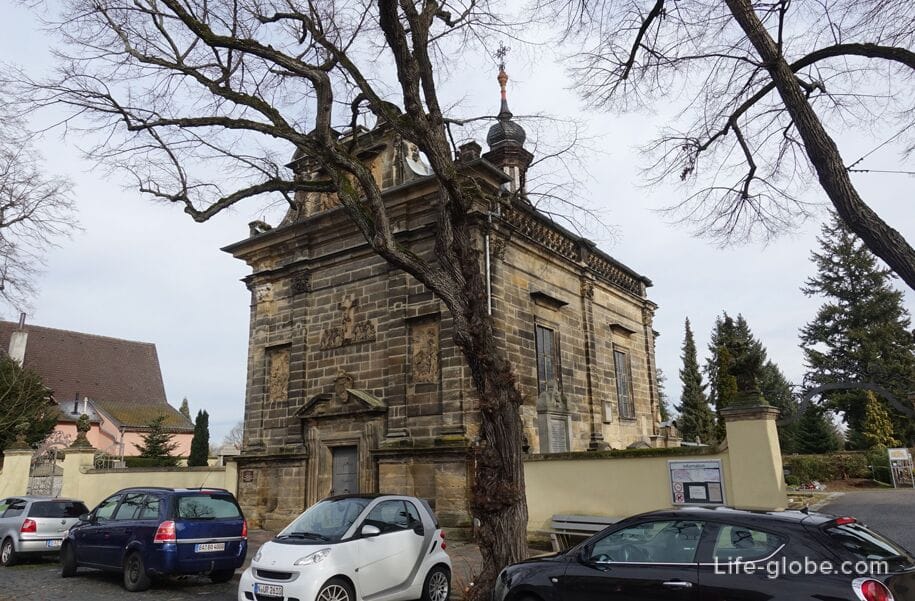

The Church of the Redeemer (Erlöserkirche) was erected in 1934 by Professor Hermann Bestelmeyer as the first new Protestant church in Bamberg.
The Church of the Redeemer is also the first church with bike paths in Bavaria.
Destroyed by bombs during the Second World War, the Church of the Savior was restored in 1950.
The crucifixion on the altar cross in the church dates back to the 16th century and is attributed to a disciple of Feit Stoss.
Church address: Kunigundendamm 14, 96050 Bamberg.
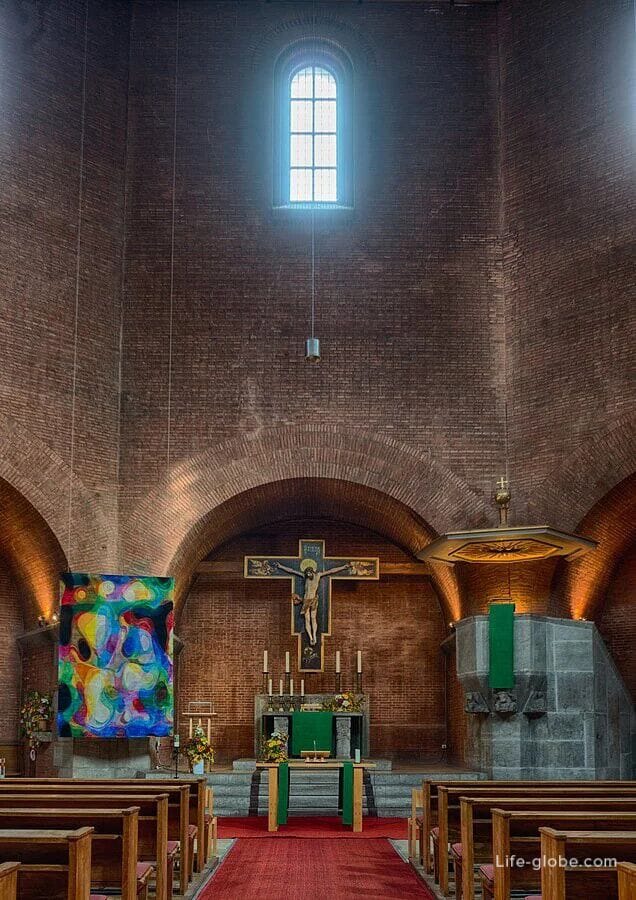
The Art Museum of the Bamberg eV Association (Kunstverein Bamberg e.V.) is a place where alternating exhibitions represent a cross-section of painting, graphics, sculpture, photography, installations and performance.
Once a year, Villa Dessauer hosts a large exhibition, and the lobby of the ETA Hoffmann Theater is also used as an exhibition space. Readings and specialized lectures on art, art history or other cultural topics, conversations with artists and art trips complement the program of art meetings.
The association has a collection of modern graphics by famous artists, which is replenished and from time to time exhibited at exhibitions.
Address: Hainstraße 4a, 96047 Bamberg.
Website: kunstverein-bamberg.de .
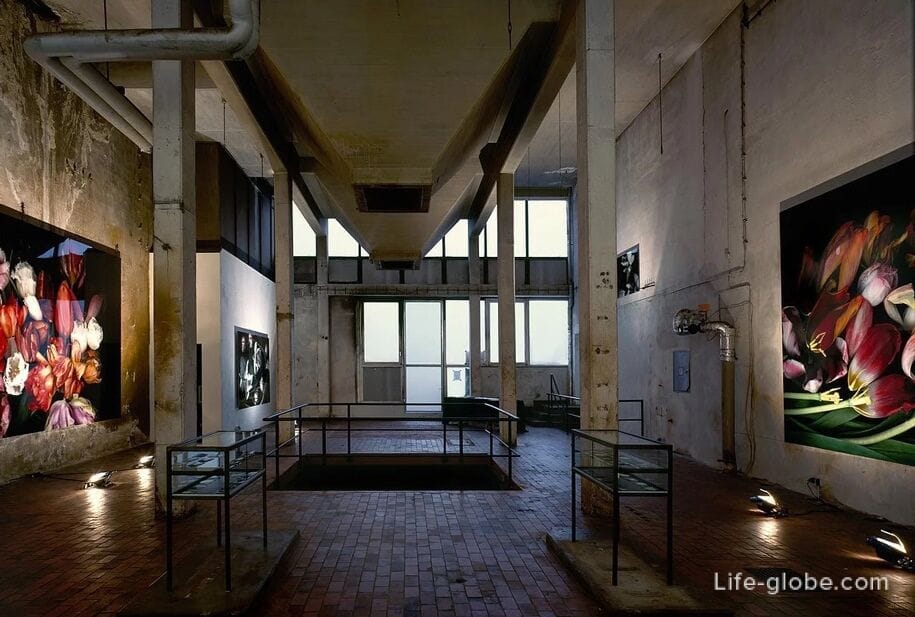
The city park "Hain" (Stadtpark "Hain") is the largest in the center of Bamberg.
The park is located near the banks of the Regnitz River near the old town of Bamberg.
The park has many walking paths among untouched nature and silence, a botanical garden, ponds, sculptures, places to relax, toilets, playgrounds and a beer garden.

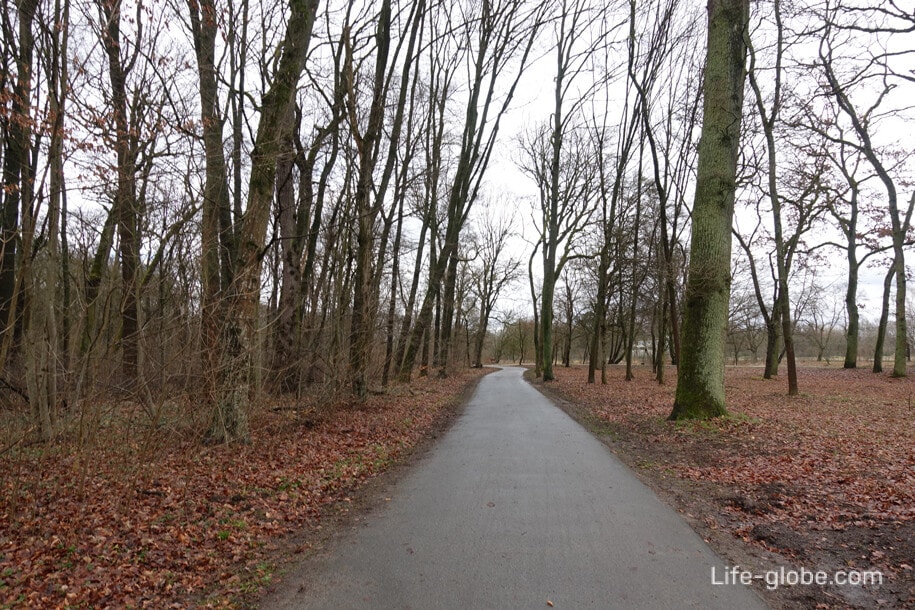



Near Hain Park, the summer recreation area is notable Hainbadestelle.
This is an outdoor recreation and swimming area by the Regnitz River with sun beds, lawns, a garden, a children's pool, table football, hammocks, a book delivery service, a cafe, a children's pool, a playground with a slide, swings and a sandbox.
You can swim in the river; wooden stairs are equipped for descending into the water.
Entrance is paid.
Address: Mühlwörth 18a, 96047 Bamberg.
Website: hainbadestelle.

Near the park there are pleasant streets with villas and houses of classicism, as well as the Diocesan House of St. Otto (Bistumshaus St. Otto), which was opened as a seminary on July 13, 1928, on the memorial day of St. Emperor Henry.

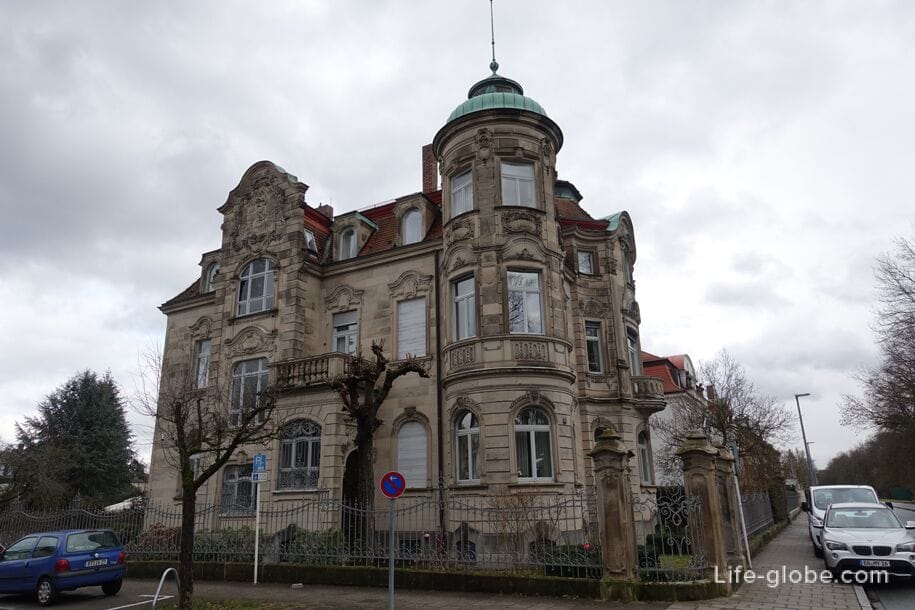



The Bamberger Krippenmuseum presents nativity scenes from all over the world, mainly historical and nativity scenes, which are very different in origin, age and material.
The range of exhibits that can be seen in the museum ranges from a large nativity scene made of Bohemian glass to evidence of the art of the nativity scene in Bamberg and numerous objects from around the world.
Museum address: Obere Sandstraße 23, 96049 Bamberg.
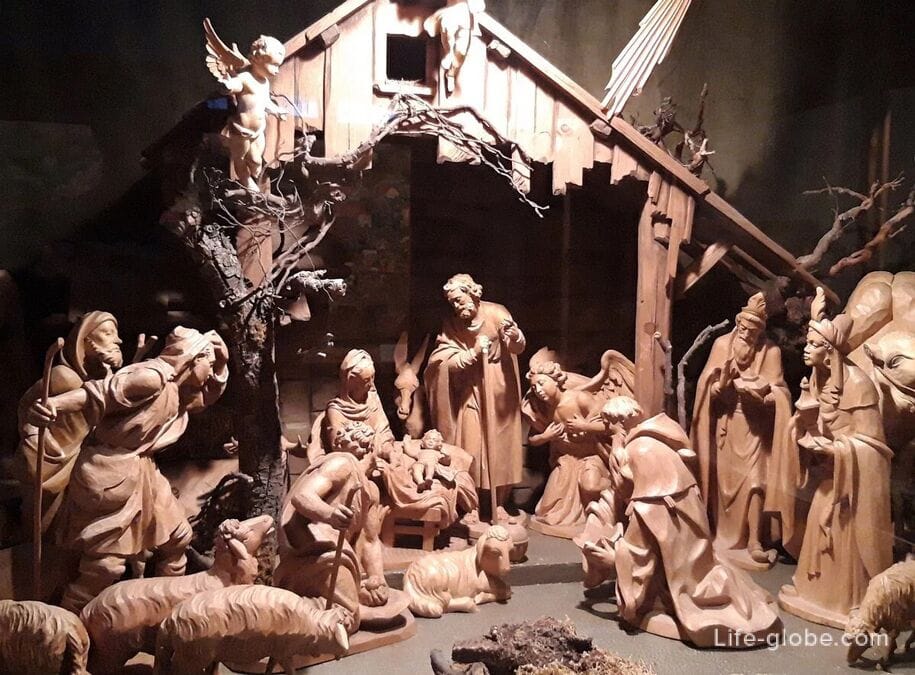
The Bamberg Fire Protection Museum (Feuerwehrmuseum Bamberg) tells about the more than 300-year history of development in the field of firefighting and where fire trucks and various fire protection items are presented.
The museum is open on certain days or it can be visited by appointment.
Museum address: Siechenstraße 75, 96052 Bamberg.
Fire Protection website: feuerwehr-bamberg.de.
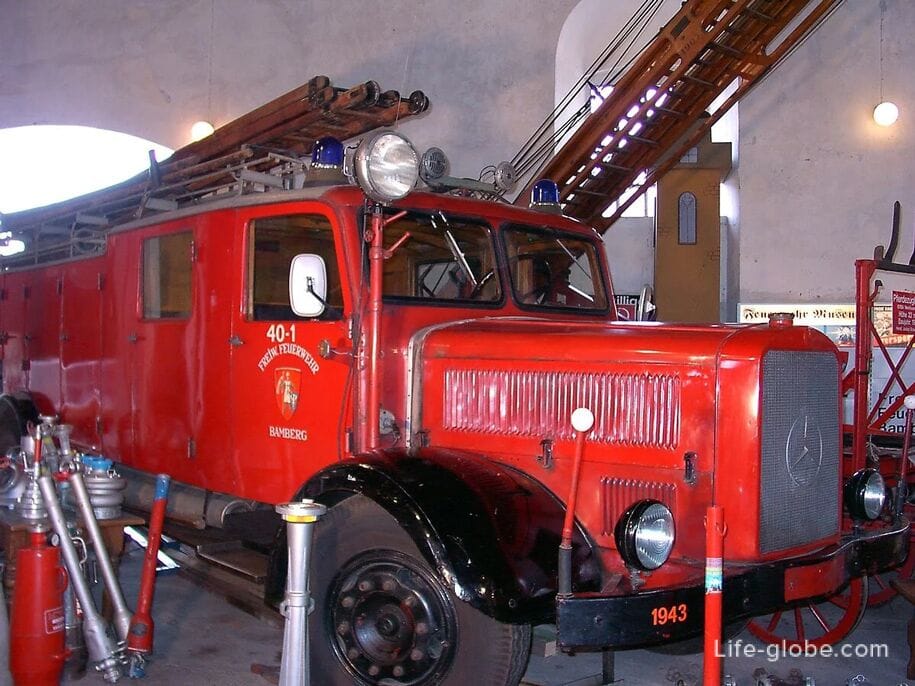
Villa Remeis is a historic classic villa by Karl Remeis.
Today, within the walls of the villa there is a cafe with halls and tables in the open air, and from the territory near the villa there are panoramic views of part of Bamberg.
Villa address: St.-Getreu-Strasse 13, 96049 Bamberg.

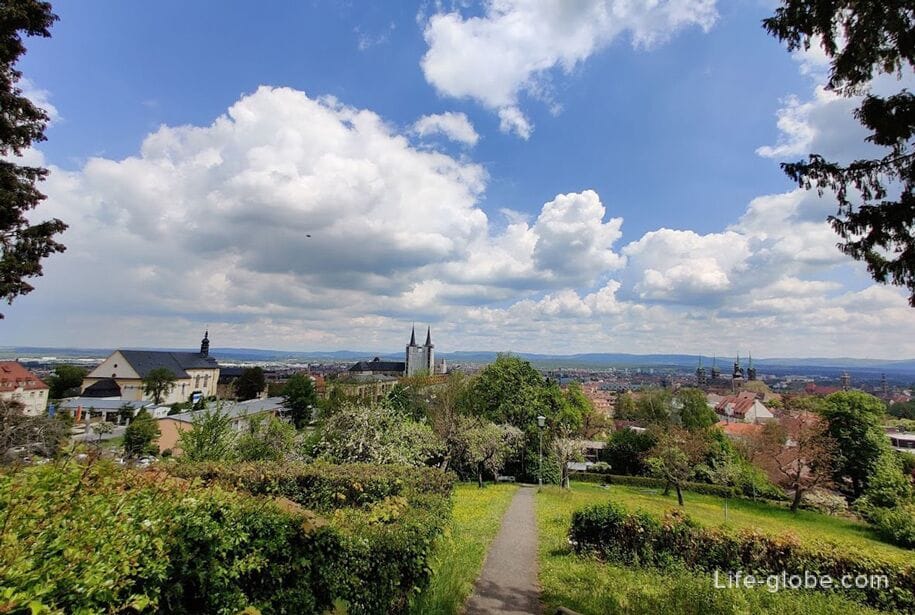
Bamberg is famous not only for its beautiful historical center, but also known as the beer city of Franconia.
There are many breweries with inns located within the city of Bamberg and in the surrounding area, where you can not only taste various foamy drinks, but also taste Franconian and Bavarian cuisine.
However, Bamberg itself is known primarily for its smoked (or smoky) beer (Rauchbier / Raubir), which is famous for the aroma of smoke and has already become legendary due to the taste that smoked malt gives to beer.
You can try smoked Bamberg beer in the historical brewery-beer "Schlenkerla" (Schlenkerla), which has been operating since 1405 and where smoked beer is still poured from oak barrels with you, and smoked malt is historically obtained by roasting malt on an open fire. Learn more about smoked beer and breweries in Bamberg...
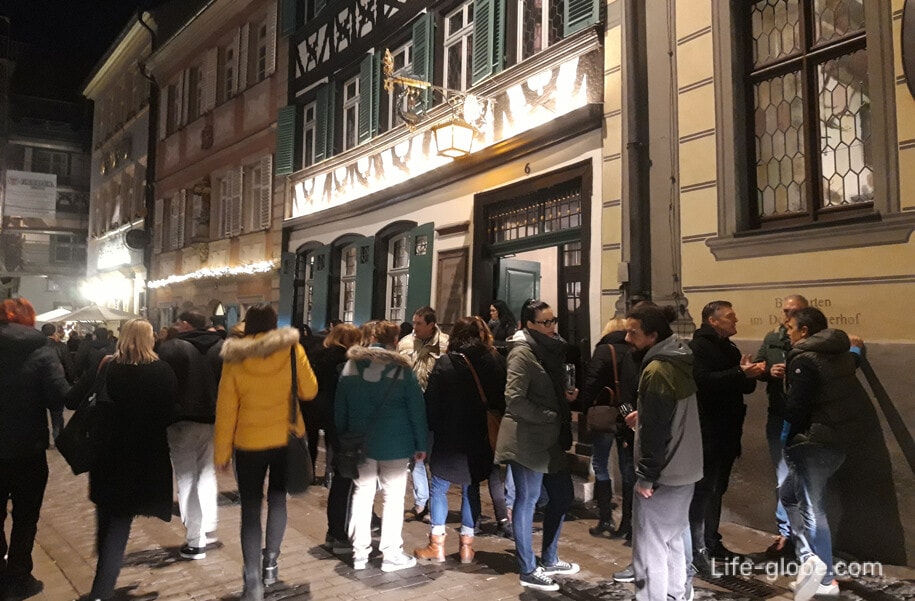


All accommodation facilities in Bamberg, including in the historical center of the city and more remotely from it, can be viewed and booked here